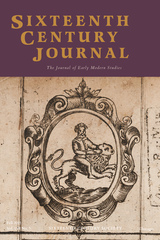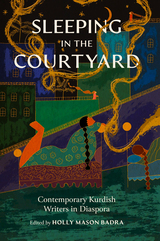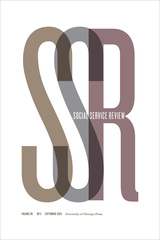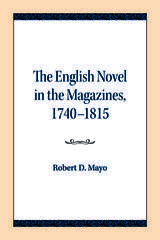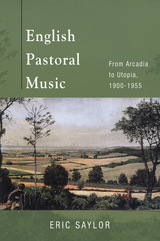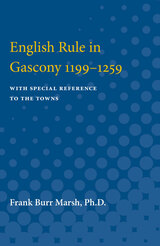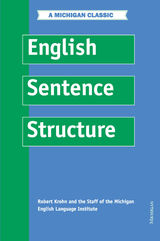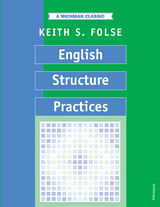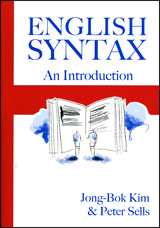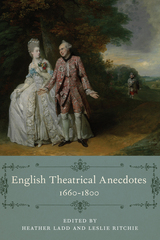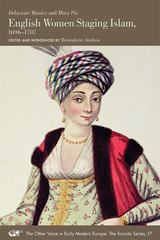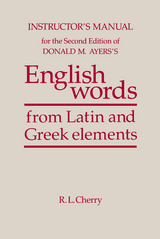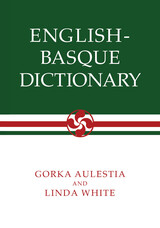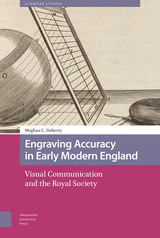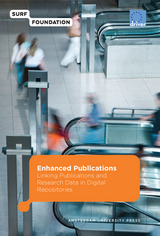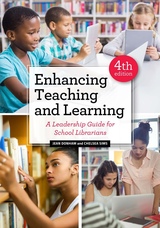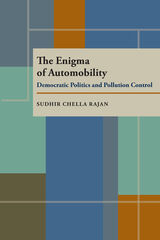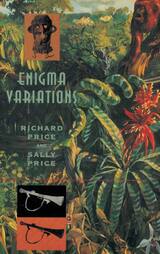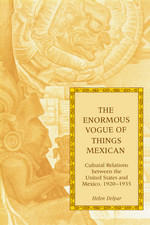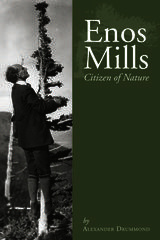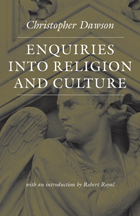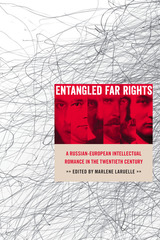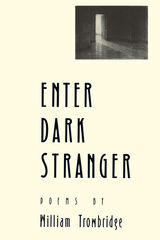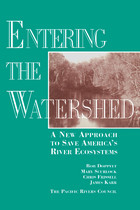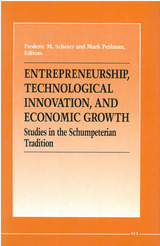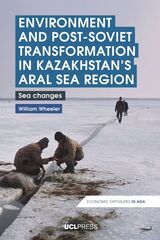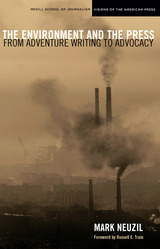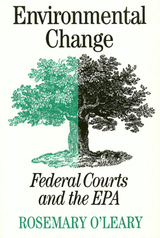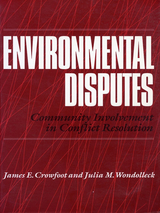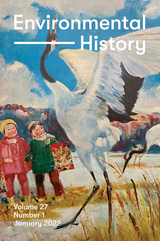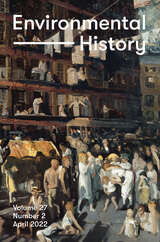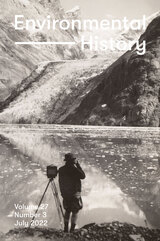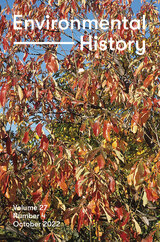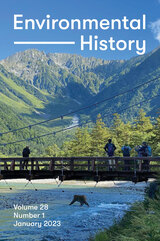The English Novel in the Magazines, 1740-1815
Robert D. Mayo
Northwestern University Press, 1962 The English Novel in the Magazines, 1740–1815, explores the popularity of magazines in the nineteenth century and the ways that much of the published fiction of the time appeared serially in these publications. Robert D. Mayo's groundbreaking study remains important to scholars of the nineteenth century as one of the first books to examine in a systematic manner the impact of magazines on reading and the dissemination of fiction in nineteenth-century England.
 English on the Bonin (Ogasawara) Islands, Volume 81
Daniel Long
Duke University Press Many inhabitants of the Bonin (Ogasawara) Islands in the northwestern Pacific Ocean speak a mixture of English and Japanese that resulted from the islands’ unique and complicated history. The development of Bonin English began with the arrival—on previously uninhabited islands—of men and women speaking eighteen European and Austronesian languages in the early nineteenth century. As the islanders intermixed, their native languages intertwining, the need arose for a common language and shared means of communication. Eventually, a pidgin version of English emerged as the preferred method of communication as well as a strong symbol of island identity. As Bonin English developed among second- and third-generation islanders, it was further complicated by the arrival of thousands of Japanese speakers. Increasingly, these formerly “western” islanders became bilingual, and by the mid-twentieth century Bonin English had evolved to incorporate elements of Japanese. This volume provides a comprehensive overview of Bonin English and the complex sociolinguistic factors that have influenced its endurance and metamorphosis.
English Pastoral Music: From Arcadia to Utopia, 1900-1955
Eric Saylor
University of Illinois Press, 2017 Covering works by popular figures like Ralph Vaughan Williams and Gustav Holst as well as less familiar English composers, Eric Saylor's pioneering book examines pastoral music's critical, theoretical, and stylistic foundations alongside its creative manifestations in the contexts of Arcadia, war, landscape, and the Utopian imagination. As Saylor shows, pastoral music adapted and transformed established musical and aesthetic conventions that reflected the experiences of British composers and audiences during the early twentieth century. By approaching pastoral music as a cultural phenomenon dependent on time and place, Saylor forcefully challenges the body of critical opinion that has long dismissed it as antiquated, insular, and reactionary.
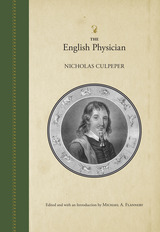 The English Physician
Nicholas Culpeper
University of Alabama Press, 2007 The first medical book published in the American colonies The English Physician is a humble vest-pocket-sized 94-page medical guide for the common person, by the prolific herbalist and author Nicholas Culpeper. It was a staple in 17th-century England, as it was short, written in accessible prose, and inexpensive; and perhaps as attractive, it took a decidedly skeptical view of "official" medicine, relying instead on popular remedies. Culpeper’s philosophy was to teach the common folk to minister to themselves by providing them with the tools and knowledge for self-help. Published in Boston in 1708 by Nicholas Boone, the American version of The English Physician was widely cited and used at the time. Today only five copies are known to exist. The rarity of this vade mecum of colonial America is wrapped in mystery: Who really wrote this book and when, where, and how did it originate? The editor illuminates these mysteries while adding an informative historical introduction on the state of medical knowledge and practice at the time, exploring Culpeper’s position among competing medical writers, and glossing the medical and botanical terms, providing contemporary equivalents. Modern readers will discover the meaning behind the strangely named brews and concoctions of the 17th century and will learn how this Boston printing literally transformed the American landscape with herbs brought from the British colonists’ homeland.
 English Pronunciation: Excercises in Sound Segments, Intonation, and Rhythm
Robert Lado and Charles C. Fries
University of Michigan Press, 1954 English Pronunciation: Exercises in Sound Segments, Intonation, and Rhythm, authored by Robert Lado, Charles C. Fries, and the Staff of the English Language Institute, is a comprehensive guide for mastering the intricacies of English pronunciation. This book is designed to improve the learner's ability to recognize and produce the sounds of English through a series of well-structured lessons and practical exercises. Starting with an introductory lesson designed to familiarize students with the phonemic alphabet and intonation markings, the book then progresses through a series of lessons that address both vowel and consonant contrasts, intonation patterns, rhythm, and stress. Each lesson includes drills for both recognition and production, emphasizing the importance of practice in achieving accurate pronunciation. The material is particularly focused on the needs of Spanish-speaking learners, with numerous aids and detailed articulatory descriptions to facilitate learning. Teachers will find tips on classroom atmosphere, individual differences, and specific teaching techniques that ensure effective learning. The latter part of the book continues to refine pronunciation skills, introducing more complex consonant clusters and combinations and providing supplementary information on English pronunciation irregularities and dialectal variations. By the end of the book, students are expected to have a solid grasp of English sound segments, intonation, and rhythm, enabling them to speak accurately and fluently.
 English Romanticism and the French Tradition
Margery Sabin
Harvard University Press, 1976 There are separate languages to be understood in the writings of French and English Romantics, Margery Sabin tells us. Instead of minimizing the importance of national characteristics, as comparatistes frequently do, she demonstrates that national traditions of thought and language have a determining influence throughout the Romantic period. In tracking the differing courses pursued by the best French and English writers of the period, she shows that the idea of the transcendental imagination never took hold among the French-Romantics; that Wordsworth's ideal of the marriage between mind and nature did not inform the vision of the French, who were preoccupied with the isolated human spirit thrown back on its own resources of conscience or faith.
A detailed and far-ranging comparison of Rousseau's Confessions and Wordsworth's Prelude establishes her provocative argument. The idea gains force from the wealth of examples that follow. Sabin examines Wordsworth, Coleridge, and George Eliot as representative of varieties of English Romanticism in the genres of lyric poetry, critical theory, and the novel. Contrasts between these writers and Hugo, Baudelaire, and Flaubert offer new and more precise ways of understanding both Romanticism and later departures from it. Her sensitive readings of Pascal, La Rochefoucauld, Addison, Samuel Johnson, Gerard Manley Hopkins, Thomas Hardy, Yeats, T. S. Eliot, and others yield further evidence. This fresh critical perspective will generate further thought about major writers and about national differences in literature.
English Rule in Gascony, 1199-1259: With Special Reference to the Towns
Frank Burr Marsh, Ph.D.
University of Michigan Press, 1912 This volume is a brief history of sixty years of English rule in Gascony, the southwestern region of present-day France. Marsh’s particular concern is how the various towns of the region were affected by decades of political upheavals. Beginning with the controversy over John’s ascension to the throne following the death of his brother, Richard I, Marsh shows how difficulties at the local level contributed to and resulted from the larger instabilities of the time. He also considers the alliances and factions among Gascony’s small towns as they met with a succession of English kings. The book concludes with the treaty between Henry II and Louis IX, ceding control of the region to France. An appendix lists the mayors of Bordeaux during this period.
English Sentence Structure
Robert Krohn and the Staff of the Michigan English Language Institute
University of Michigan Press, 1957 Part of the classic Michigan Rainbow series.
English Sentence Structure presents and clarifies all facets of the sentence for beginning and intermediate students. Oral drills, examples, and written exercises form a pattern of regular review and self-evaluation. Each lesson is coordinated with English Pattern Practices.
English Society: 1580-1680
Wrightson, Keith
Rutgers University Press, 2003 English Society brings together the results of recent historiography, together with much original research by the author, to provide a fascinating picture of society and social change in the period. The first section of the book discusses some of the enduring characteristics of society: social stratification and social mobility, kinship, neighborliness, patronage and deference, courtship and family formation, relationships between husbands and wives, parents and children. The second half of the book charts the course of social change: problems of public order, crime and social control, educational and religious developments, and profound changes in popular culture brought about by the growth of popular literacy and the consolidation of the Protestant Reformation. At every point, Keith Wrightson brings his material to life with his arresting use of contemporary diaries and texts.
English Structure Practices
Keith S. Folse
University of Michigan Press, 1983 This workbook, which may be used independently or in conjunction with English Sentence Structure, contains more than 400 exercises that cover beginning- and intermediate-level grammar points such as tenses, articles, count and noncount nouns, modals, verbals, relative clauses, passive voice, adverbs, and conditional sentences.
This is the workbook to accompany English Sentence Structure.
English Syntax: An Introduction
Jon-Bok Kim and Peter Sells
CSLI, 2008 Focusing on the descriptive facts of English, this volume provides a systematic introduction to English syntax for students with no prior knowledge of English grammar or syntactic analysis. English Syntax aims to help students appreciate the various sentence patterns available in the language, understand insights into core data of its syntax, develop analytic abilities to further explore the patterns of English, and learn precise ways of formalizing syntactic analysis for a variety of English data and major constructions such as agreement, raising and control, the auxiliary system, passive, wh- questions, relative clauses, extrapolation, and clefts.
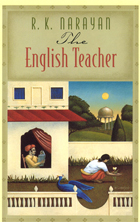 The English Teacher
R. K. Narayan
University of Chicago Press, 1980 This novel completes the informal trilogy which began with Swami and Friends and The Bachelor of Arts. The protagonist, Krishna, is an English teacher at the same college he had attended as a student. Although Krishna has recently married, his wife Susila and their daughter live with his parents-in-law some miles away. The story opens with his immediate family deciding to join him in Malgudi. Krishna is initially frightened by his new state of affairs, but he soon finds that his love for both his wife and child grows deeper than he could have imagined.
"Mr. Narayan has repeatedly been compared with Chekhov. Ordinarily such comparisons are gratuitous and strained, but in this case there are such clear and insistent echoes that any careful reader will be aware of them. There is that sense of rightness which transcends mere structure. There is the inexplicable blending of tragedy and humor. Most of all, there is a brooding awareness of fate which makes the story seem not authored, but merely translated."—J.F. Muehl, Saturday Review
"[Narayan] does not deal in exemplary fates, and the Western novel's machinery of retribution is far too grandiose for him. . . . In Narayan's world, scores are not settled but dissolved, recycled, restated. 'Both of us will shed our forms soon and perhaps we could meet again, who knows? So goodbye for the present.' These are the concluding words for the novel A Tiger for Malgudi, but they constitute a universal epilogue one could append to most of Narayan's fiction."—Russell Davies, Times Literary Supplement
English Theatrical Anecdotes, 1660-1800
Heather Ladd
University of Delaware Press, 2022 The essays in English Theatrical Anecdotes, 1660-1800 explore the theatrical anecdote’s role in the construction of stage fame in England’s emergent celebrity culture during the long eighteenth century, as well as the challenges of employing such anecdotes in theatre scholarship today. This collection showcases scholarship that complicates the theatrical anecdote and shows its many sides and applications beyond the expected comic punch. Discussing anecdotal narratives about theatre people as producing, maintaining, and sometimes toppling individual fame, this book crucially investigates a key mechanism of celebrity in the long eighteenth century that reaches into the nineteenth century and beyond. The anecdote erases boundaries between public and private and fictionalizing the individual in ways deeply familiar to twenty-first century celebrity culture.
English Theories of Central Banking Control, 1819-1858: With Some Account of Contemporary Procedure
Elmer Wood
Harvard University Press In dealing with his subject, Elmer Wood has found it necessary to give very considerable attention to the actual procedure followed by the Bank of England, and for this purpose he has prepared a large number of charts that show the actual movement of the various items of the Bank’s statement. Contrary to the position taken by most modem writers, he concludes that the country banks were not in a position to thwart control by the central institution. In the matter of gold, he has taken the view that the Bank, instead of adjusting its position to an international gold standard governed automatically by natural law, managed the international standard. Since, however, the Bank’s management of the standard was not on a secure footing, it was only an historical accident that it was successful in maintaining gold payments as long as it did.
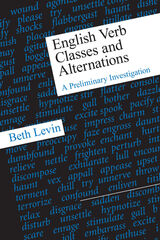 English Verb Classes and Alternations: A Preliminary Investigation
Beth Levin
University of Chicago Press, 1993 In this rich reference work, Beth Levin classifies over 3,000 English verbs according to shared meaning and behavior. Levin starts with the hypothesis that a verb's meaning influences its syntactic behavior and develops it into a powerful tool for studying the English verb lexicon. She shows how identifying verbs with similar syntactic behavior provides an effective means of distinguishing semantically coherent verb classes, and isolates these classes by examining verb behavior with respect to a wide range of syntactic alternations that reflect verb meaning.
The first part of the book sets out alternate ways in which verbs can express their arguments. The second presents classes of verbs that share a kernel of meaning and explores in detail the behavior of each class, drawing on the alternations in the first part. Levin's discussion of each class and alternation includes lists of relevant verbs, illustrative examples, comments on noteworthy properties, and bibliographic references. The result is an original, systematic picture of the organization of the verb inventory.
Easy to use, English Verb Classes and Alternations sets the stage for further explorations of the interface between lexical semantics and syntax. It will prove indispensable for theoretical and computational linguists, psycholinguists, cognitive scientists, lexicographers, and teachers of English as a second language.
 The English Virtuoso: Art, Medicine, and Antiquarianism in the Age of Empiricism
Craig Ashley Hanson
University of Chicago Press, 2009 Contrary to twentieth-century criticism that cast them as misguided dabblers, English virtuosi in the seventeenth and early eighteenth centuries were erudite individuals with solid grounding in the classics, deep appreciation for the arts, and sincere curiosity about the natural world. Reestablishing their broad historical significance, The English Virtuoso situates this polymathic group at the rich intersection of the period’s art, medicine, and antiquarianism.
At the heart of this profoundly interdisciplinary study lies the Royal Society of London for the Improvement of Natural Knowledge, which from its founding in 1660 served as the major professional organization for London’s leading physicians, many of them prominent virtuosi. Craig Ashley Hanson reveals that a vital art audience emerged from the Royal Society—whose members assembled many of the period’s most important nonaristocratic collections—a century before most accounts date the establishment of an institutional base for the arts in England. Unearthing the fascinating stories of an impressive cast of characters, Hanson establishes a new foundation for understanding both the relationship between British art and science and the artistic accomplishments of the late eighteenth and nineteenth centuries.
English Women Staging Islam, 1696-1707
Delarivier Manley and Mary Pix
Iter Press, 2012 Delarivier Manley and Mary Pix were among the groundbreaking “female wits,” who debuted their original plays for the public stage in 1695–96. Two of these plays contain explicitly Islamicate themes. Manley’s The Royal Mischief expands on The Travels of Sir John Chardin into Persia(1686), and Pix’s Ibrahim draws on Rycaut’s History of the Turkish Empire (1687). Continuing this interest, Manley’s Almyna (1706–7) responds to the newly translated Arabian Nights Entertainments (1704–17), and Pix’s The Conquest of Spain (1705) engages the history of Islamic Spain recounted in The Life of the Most Illustrious Monarch Almanzor (1693). These plays have been modernized and annotated in this edition, most for the first time. This edition also includes appendices with excerpts from historical sources and a select bibliography.
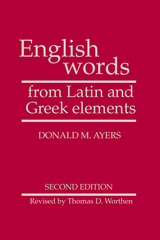 English Words from Latin and Greek Elements
Donald M. Ayers; Revised by Thomas D. Worthen
University of Arizona Press, 1986 Since 1965, Donald Ayers' English Words from Latin and Greek Elements has helped thousands of students to a broader vocabulary by showing them how to recognize classical roots in modern English words. Its second edition, published in 1986, has confirmed that vocabulary is best taught by root, not rote. The importance of learning classical word roots is already acknowledged by vocabulary texts that devote chapters to them. Why a whole book based on this approach? Ayers' text exposes students to a wider range of roots, introduces new English words in context sentences, and reinforces vocabulary through exercises. It promotes more practice with roots so that students learn to use them as tools in their everyday encounters with new words. English Words is written from the standpoint of English; it neither attempts to teach students Latin or Greek nor expects a knowledge of classical languages on the part of instructors. Its success has been demonstrated at both the secondary and college levels, and it can be used effectively with students in remedial or accelerated programs. An Instructor's Manual (gratis with adoption) and a Workbook are also available.
English Words Instructor's Manual
R. L. Cherry
University of Arizona Press, 1986 This is the Instructor's Manual for the second edition of Donald M. Ayers's English Words from Latin and Greek Elements, as revised and expanded by Thomas D. Worthen. It is intended as a guide to accompany Ayers's classroom text. It can be purchased here or requested gratis upon adoption of the text.
English-Basque Dictionary
Gorka Aulestia
University of Nevada Press, 1990 With over 25,000 English entries and their Basque equivalents in six major dialects, this volume is the most complete reference to the Basque language to date for English-speaking people. This useful resource is the very first of its kind to become available to both the casual student and the serious scholar of the Basque language. The Biscayan, Guipuzcoan, Labourdin, Low Navarrese, Zuberoan, and Batua dialects are included in order to cover all the different regional and formal dialects used in the body of Basque literature, both written and oral, and to present the language in a form familiar to American Basques who may know little of Batua. Whenever possible, the authors also include words relating to modern society.
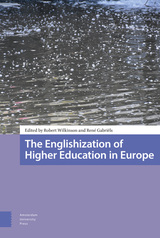 The Englishization of Higher Education in Europe
Robert Wilkinson
Amsterdam University Press, 2021 The introduction of English as a medium of instruction (EMI) has changed higher education enormously in many European countries. This development is increasingly encapsulated under the term Englishization, that is, the increasing dispersion of English as a means of communication in non-Anglophone contexts. Englishization is not undisputed: legal challenges have arisen in several countries. Nor is it uniform; universities across Europe embrace Englishization, but they do so in their own way. In this volume, authors from 15 European countries present analyses from a range of perspectives coalescing around core concerns: the quality of education, cultural identity, inequality of opportunities and access, questions of justice and democracy, and internationalization and language policy. This book will appeal to researchers in applied linguistics, sociolinguistics, educational sciences, and political science, as well as policy makers and people with a concern about the direction of higher education.
Englishness, Pop and Post-War Britain
Kari Kallioniemi
Intellect Books, 2016 English pop music was a dominant force on the global cultural scene in the decades after World War II—and it served a key role in defining, constructing, and challenging various ideas about Englishness in the period. Kari Kallioniemi covers a stunning range of styles of pop—from punk, reggae, and psychedelia to jazz, rock, Brit Pop, and beyond—as he explores the question of how various artists (including such major figures as David Bowie and Morrissey), genres, and pieces of music contributed to the developing understanding of who and what was English in the transformative postwar years.
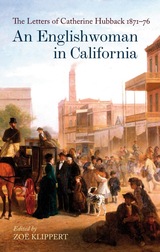 An Englishwoman in California: The Letters of Catherine Hubback, 1871-76
Edited by Zoë Klippert
Bodleian Library Publishing, 2010 A niece of Jane Austen and a novelist herself, Catherine Hubback was fifty-two years old when she left England for America. She travelled to California on the Transcontinental Railroad and settled in Oakland, on the eastern shore of San Francisco Bay. Her son Edward shared her household and commuted by ferryboat to a wheat brokerage in the City. In letters to her eldest son John and his wife Mary in Liverpool, Catherine conveys her delight – and her exasperation – at her new environment. She portrays her neighbours with a novelist's wry wit and brings her English sensibility to bear on gardening with unfamiliar plants and maintaining a proper wardrobe in a dry climate. She writes vividly of her adventures as she moves about a landscape recognizable to present-day residents, at a time when boats rather than bridges spanned the bay, and hot springs were the main attraction in the Napa Valley. In an atmosphere of financial unrest, she writes freely of her anxieties, while supplementing Edward's declining income by making lace and teaching the craft to other women. She recalls her 'prosperous days' in England, but finds pleasure in small things and assuredly takes her place in a society marked by great disparities in wealth. In addition to transcriptions of the letters, this highly readable edition offers pertinent information on many of the people and places mentioned, explanatory notes, and striking illustrations. The introduction places the letters in context and tells the story of Catherine Hubback, whose life evolved in ways unprecedented in the Austen family.
Engraved
Anna Meek
Tupelo Press, 2013 Inspired by nineteenth-century engravings for the Webster’s Dictionary, Engraved explores a fantastic land at the edge of obsolescence and loss. The poems teem with whaling schooners, passenger pigeons, a bayonet, cupola furnace, clavichord—words and objects at the brink of extinction, placed in and around the death of the poet’s father. But these poems also create, or recreate; through illustration, music, and myth, the imagination here allows the dead to reappear, mostly, and sometimes also lets them go. Located at the intersection of art and grief, these poems honor anyone who has set down lines and vanished from the earth.
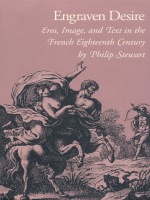 Engraven Desire: Eros, Image, and Text in the French Eighteenth Century
Philip Stewart
Duke University Press, 1992 How do literary illustrations affect the way we read—or more subtly, what we read? Through a critical investigation of the role of engraving played in eighteenth-century French literature, Philip Stewart grapples with this question. In both its approach and its conclusions, his project marks a provocative departure from the tradition of viewing illustrations as merely pictures, rather than as texts to be interpreted themselves.
Focusing on the objectification of women by the “male gaze,” Stewart analyzes the varous ways in which this masculine power is simultaneously represented and veiled: the fascination with women playing “male” roles, such as soldiers; the preponderance of voyeuristic images of the naked female body; the transformation of male power into hostile forces of nature that render women helpless. Further, Stewart shows how “indecent” engravings that purported to test the limits of eighteenth-century morality often merely reinforced prevailing images of women.
Addressing critical concerns about the societal enforcement of gender roles in literature along with essential questions about the function of illustration, Engraven Desire provides surprising insight into the culturally conditioned act of reading. Stewart’s work, itself richly illustrated with hundreds of arresting reproductions, makes a significant contribution to our understanding of the interplay of art, literature, and society.
Engraving Accuracy in Early Modern England: Visual Communication and the Royal Society
Meghan Doherty
Amsterdam University Press, 2022 Engraving Accuracy in Early Modern England traces major concepts including: the creation of the visual effects of accuracy through careful action and training; the development of visual judgment and connoisseurship; the role of an epistolary network in the production of knowledge; balancing readers’ expectations with representational conventions; and the effects of collecting on the creation and circulation of knowledge.
On the one hand, this study uncovers how approaches to knowledge production differed in the seventeenth century as compared with the twenty-first century. On the other, it reveals how the early modern struggle to sort through an overwhelming quantity of visual information - brought on by major changes in image production and circulation - resonates with our own.
 Engraving the Savage: The New World and Techniques of Civilization
Michael Gaudio
University of Minnesota Press, 2008 In 1585, the British painter and explorer John White created images of Carolina Algonquian Indians. These images were collected and engraved in 1590 by the Flemish publisher and printmaker Theodor de Bry and were reproduced widely, establishing the visual prototype of North American Indians for European and Euro-American readers. In this innovative analysis, Michael Gaudio explains how popular engravings of Native American Indians defined the nature of Western civilization by producing an image of its “savage other.” Going beyond the notion of the “savage” as an intellectual and ideological construct, Gaudio examines how the tools, materials, and techniques of copperplate engraving shaped Western responses to indigenous peoples. Engraving the Savage demonstrates that the early visual critics of the engravings attempted-without complete success-to open a comfortable space between their own “civil” image-making practices and the “savage” practices of Native Americans-such as tattooing, bodily ornamentation, picture-writing, and idol worship. The real significance of these ethnographic engravings, he contends, lies in the traces they leave of a struggle to create meaning from the image of the American Indian. The visual culture of engraving and what it shows, Gaudio reasons, is critical to grasping how America was first understood in the European imagination. His interpretations of de Bry’s engravings describe a deeply ambivalent pictorial space in between civil and savage-a space in which these two organizing concepts of Western culture are revealed in their making. Michael Gaudio is assistant professor of art history at the University of Minnesota.
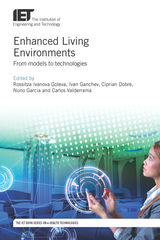 Enhanced Living Environments: From models to technologies
Rossitza Ivanova Goleva
The Institution of Engineering and Technology, 2018 Enhanced living environments employ information and communications technologies to support true ambient assisted living for adults and people with disabilities. This book provides an overview of today's architectures, techniques, protocols, components, and cloud-based solutions related to ambient assisted living and enhanced living environments. Topics covered include: an introduction to enhanced living environments; pervasive sensing for social connectedness; ethics in information and communication technologies; service scenarios in smart personal environments; technological support to stress level monitoring; big data systems to improve healthcare information searching over the Internet; sensors for wireless body area networks; linear wireless sensor networks and protocols in next generation networks; model-compilation challenges for cyber-physical systems; health monitoring using wireless body area networks; wearable health care; and intelligent systems for after-stroke home rehabilitation.
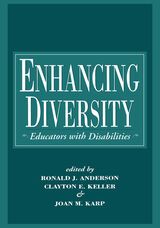 Enhancing Diversity: Educators with Disabilities
Ronald J. Anderson
Gallaudet University Press, 1998 The 43 million people with disabilities form this country’s largest minority group, yet they are markedly under-employed as educators. Enhancing Diversity: Educators with Disabilities paves the way for correcting this costly omission. Editors Anderson, Karp, and Keller have called upon the knowledge of 19 other renowned contributors to address the important issues raised in Enhancing Diversity, including the place of disability in discussions of diversity in education, research on educators with disabilities that validates their capabilities, and information on the qualifications desired in and the demands made of education professionals. Legal precedents are cited and explained, and examples of efforts to place disabled educators are presented, along with recommendations on how disabled individuals and school administrators can work toward increased opportunities. Interviews with 25 disabled educators discussing how they satisfactorily fulfill their professional requirements completes this thoughtful-provoking book.
Enhancing Human Traits: Ethical and Social Implications
Erik Parens, Editor
Georgetown University Press In this volume, scholars from philosophy, sociology, history, theology, women’s studies, and law explore the looming ethical and social implications of new biotechnologies that are rapidly making it possible to enhance an individual’s mental and physical attributes in ways previously only imagined. To clarify the issues, the contributors grapple with the central concept of "enhancement" and probe the uses and abuses of the term. Focusing in particular on the moral issues pertaining to cosmetic surgery and cosmetic psychopharmacology (a category which includes Prozac), they also examine notions of identity, authenticity, normality, and complicity. Other essays in this collection address the social ramifications of the new technologies, including the problems of access and fairness.
Enhancing Religious Identity: Best Practices from Catholic Campuses
John R. Wilcox and Irene King, Editors. Foreword by Monica K. Hellwig
Georgetown University Press, 2000 Catholic colleges and universities have achieved a prestigious place in American higher education, but at the risk of losing their religious identity. This book confronts challenges facing all members of the college community, from presidents and trustees through the faculty and deans to student-life professionals, in making a renewed commitment to that mission. Developing the vision of Catholic higher education expressed in the Vatican statement Ex Corde Ecclesiae, these essays provide a framework for enhancing Catholic identity across the campus and in the curriculum. The contributors address significant aspects of the culture of Catholic higher education in order to prescribe the best practices that can help colleges and universities maintain their distinctive religious character and ethical vision.
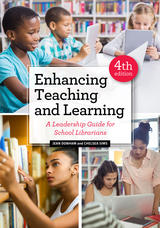 Enhancing Teaching and Learning: A Leadership Guide for School Librarians
Jean Donham
American Library Association, 2020 Rapid change calls for informed leadership. The goal of Donham’s text has always been to help school library professionals make a difference in the educational experience and academic attainment of students in their schools. With the addition of new co-author Sims, a junior high school librarian, this newly revised fourth edition rises to the challenge with updates and enhancements that confirm its value as an important resource for both LIS students and current school librarians. Covering all aspects of the school system, including students, curriculum and instruction, principals, district administration, and the community, it demonstrates how to interact and collaborate in order to integrate the school library program throughout these environments. Inside, readers will find - myriad real-world examples of issues in school librarianship and evidence-based practice;
- discussion of such urgent topics as the educational needs of the iGen (those born between 1995 and 2012), changing reading habits, the influence of the media, and news literacy and other issues related to the proliferation of fake news;
- updates which touch upon the new AASL Standards, inquiry-based learning, assessment, and library program evaluation;
- specific tactics for establishing the library program as an active player in teaching and learning;
- an overview of education-related technology such as course management systems, the virtual library, makerspaces, information presentation and data representation tools like ScreenCast and Google Maps, online home-school communication, and online student safety and privacy; and
- end-of-chapter discussion scenarios that explore opportunities for the practical application of concepts.
Reflecting changes—professional, theoretical, legal, and political—in both the library field and education, this new edition of a groundbreaking school library text will equip readers to be leaders at their schools and in their communities.
The Enigma of Automobility: Democratic Politics and Pollution Control
Sudhir Chella Rajan
University of Pittsburgh Press, 1996 Rajan investigates air pollution policy as one based on how to make cars less polluting. Putting the onus on auto manufacturers and owners has generated an elaborate scheme of emissions testing and pollution-control devices, and does not look at the technology itself as the heart of the problem. Rajan focuses his study on data collected in Los Angeles, to show how emissions testing burdens the poor, who tend to own older cars that pollute more. Rajan argues for democratic control over technology, steering it away from special interest groups and toward a long-term ethical resolution.
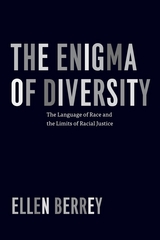 The Enigma of Diversity: The Language of Race and the Limits of Racial Justice
Ellen Berrey
University of Chicago Press, 2015 Diversity these days is a hallowed American value, widely shared and honored. That’s a remarkable change from the Civil Rights era—but does this public commitment to diversity constitute a civil rights victory? What does diversity mean in contemporary America, and what are the effects of efforts to support it?
Ellen Berrey digs deep into those questions in The Enigma of Diversity. Drawing on six years of fieldwork and historical sources dating back to the 1950s and making extensive use of three case studies from widely varying arenas—housing redevelopment in Chicago’s Rogers Park neighborhood, affirmative action in the University of Michigan’s admissions program, and the workings of the human resources department at a Fortune 500 company—Berrey explores the complicated, contradictory, and even troubling meanings and uses of diversity as it is invoked by different groups for different, often symbolic ends. In each case, diversity affirms inclusiveness, especially in the most coveted jobs and colleges, yet it resists fundamental change in the practices and cultures that are the foundation of social inequality. Berrey shows how this has led racial progress itself to be reimagined, transformed from a legal fight for fundamental rights to a celebration of the competitive advantages afforded by cultural differences.
Powerfully argued and surprising in its conclusions, The Enigma of Diversity reveals the true cost of the public embrace of diversity: the taming of demands for racial justice.
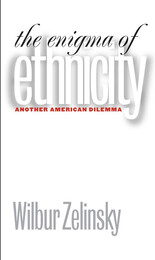 Enigma of Ethnicity: Another American Dilemma
Wilbur Zelinsky
University of Iowa Press, 2000 In The Enigma of Ethnicity Wilbur Zelinsky draws upon more than half a century of exploring the cultural and social geography of an ever-changing North America to become both biographer and critic of the recent concept of ethnicity. In this ambitious and encyclopedic work, he examines ethnicity's definition, evolution, significance, implications, and entanglements with other phenomena as well as the mysteries of ethnic identity and performance.
Zelinsky begins by examining the ways in which “ethnic groups” and “ethnicity” have been defined; his own definitions then become the basis for the rest of his study. He next focuses on the concepts of heterolocalism—the possibility that an ethnic community can exist without being physically merged—and personal identity—the relatively recent idea that one can concoct one's own identity. In his final chapter, which is also his most provocative, he concentrates on the multifaceted phenomenon of multiculturalism and its relationship to ethnicity. Throughout he includes a close look at African Americans, Hispanics, and Jews as well as such less-studied groups as suburbanized Japanese, Cubans in Washington, Koreans, Lithuanian immigrants in Chicago, Estonians in New Jersey, Danish Americans in Seattle, and Finns.
Reasonable, nonpolemical, and straightforward, Zelinsky's text is invaluable for readers wanting an in-depth overview of the literature on ethnicity in the United States as well as a well-thought-out understanding of the meanings and dynamics of ethnic groups, ethnicity, and multiculturalism.
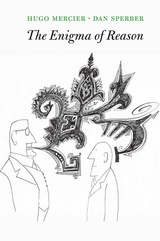 The Enigma of Reason
Hugo Mercier and Dan Sperber
Harvard University Press, 2017 “Brilliant…Timely and necessary.” —Financial Times
“Especially timely as we struggle to make sense of how it is that individuals and communities persist in holding beliefs that have been thoroughly discredited.”
—Darren Frey, Science
If reason is what makes us human, why do we behave so irrationally? And if it is so useful, why didn’t it evolve in other animals? This groundbreaking account of the evolution of reason by two renowned cognitive scientists seeks to solve this double enigma. Reason, they argue, helps us justify our beliefs, convince others, and evaluate arguments. It makes it easier to cooperate and communicate and to live together in groups. Provocative, entertaining, and undeniably relevant, The Enigma of Reason will make many reasonable people rethink their beliefs.
“Reasonable-seeming people are often totally irrational. Rarely has this insight seemed more relevant…Still, an essential puzzle remains: How did we come to be this way?…Cognitive scientists Hugo Mercier and Dan Sperber [argue that] reason developed not to enable us to solve abstract, logical problems…[but] to resolve the problems posed by living in collaborative groups.”
—Elizabeth Kolbert, New Yorker
“Turns reason’s weaknesses into strengths, arguing that its supposed flaws are actually design features that work remarkably well.”
—Financial Times
“The best thing I have read about human reasoning. It is extremely well written, interesting, and very enjoyable to read.”
—Gilbert Harman, Princeton University
 The Enigma of the Aerofoil: Rival Theories in Aerodynamics, 1909-1930
David Bloor
University of Chicago Press, 2011 Why do aircraft fly? How do their wings support them? In the early years of aviation, there was an intense dispute between British and German experts over the question of why and how an aircraft wing provides lift. The British, under the leadership of the great Cambridge mathematical physicist Lord Rayleigh, produced highly elaborate investigations of the nature of discontinuous flow, while the Germans, following Ludwig Prandtl in Göttingen, relied on the tradition called “technical mechanics” to explain the flow of air around a wing. Much of the basis of modern aerodynamics emerged from this remarkable episode, yet it has never been subject to a detailed historical and sociological analysis. In The Enigma of the Aerofoil, David Bloor probes a neglected aspect of this important period in the history of aviation. Bloor draws upon papers by the participants—their restricted technical reports, meeting minutes, and personal correspondence, much of which has never before been published—and reveals the impact that the divergent mathematical traditions of Cambridge and Göttingen had on this great debate. Bloor also addresses why the British, even after discovering the failings of their own theory, remained resistant to the German circulation theory for more than a decade. The result is essential reading for anyone studying the history, philosophy, or sociology of science or technology—and for all those intrigued by flight.
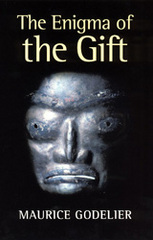 The Enigma of the Gift
Maurice Godelier
University of Chicago Press, 1998 When we think of giving gifts, we think of exchanging objects that carry with them economic or symbolic value. But is every valuable thing a potentially exchangeable item, whose value can be transferred? In The Enigma of the Gift, the distinguished French anthropologist Maurice Godelier reassesses the significance of gifts in social life by focusing on sacred objects, which are never exchanged despite the value they possess.
Beginning with an analysis of the seminal work of Marcel Mauss and Claude Lévi-Strass, and drawing on his own fieldwork in Melanesia, Godelier argues that traditional theories are flawed because they consider only exchangeable gifts. By explaining gift-giving in terms of sacred objects and the authoritative conferral of power associated with them, Godelier challenges both recent and traditional theories of gift-giving, provocatively refreshing a traditional debate.
Elegantly translated by Nora Scott, The Enigma of the Gift is at once a major theoretical contribution and an essential guide to the history of the theory of the gift.
Enigma Variations
Richard Price and Sally Price
Harvard University Press, 1995 Noted writers on art, culture, and the tropical Americas, Richard and Sally Price have crafted a mystery at the intersections of art and anthropology. Drawing readers into their quest for a solution, they build an unusual partnership between text and pictures, daringly expanding the possibilities of academic discourse. Enigma Variations--in the tradition of The Recognitions and The Crying of Lot 49--is an entertainment as readable for its intellectual power as for its irresistible drama.
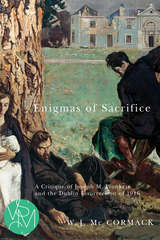 Enigmas of Sacrifice: A Critique of Joseph M. Plunkett and the Dublin Insurrection of 1916
W. J. Mc Cormack
Michigan State University Press, 2016 Enigmas of Sacrifice: A Critique of Joseph M. Plunkett and the Dublin Insurrection of 1916 is the first critical study of the religious poet and militarist Joseph M. Plunkett, who was executed with the other leaders of the Dublin insurrection of 1916. Through Plunkett the author gains access to areas of nationalist thought that were more often assumed or repressed than publicly formulated. In this eye-opening book, W. J. Mc Cormack explores and analyzes Plunkett’s brief life, work, and influence, beginning with his wealthy but dysfunctional family, irregular Jesuit education, and self-canceling sexuality. Mc Cormack continues through Plunkett’s active phase when amateur theatricals and a magazine editorship brought him into the emergent neonationalist discourse of early twentieth-century Ireland. Finally, the author arrives at Holy Week 1916, when Plunkett masterminded the forgery of official documentation in order to provoke and justify the insurrection he planned. Mc Cormack analyzes Plunkett’s significant texts and provides context through critical perspectives on his milieu. Enigmas of Sacrifice is unique in its effort to understand a major figure of Irish nationalism in terms that reach beyond political identity.
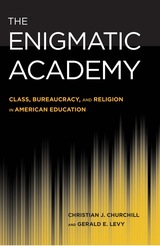 The Enigmatic Academy: Class, Bureaucracy, and Religion in American Education
Christian J. Churchill
Temple University Press, 2012 The Enigmatic Academy is a provocative look at the purpose and practice of education in America. Authors Christian Churchill and Gerald Levy use three case studies—a liberal arts college, a boarding school, and a Job Corps center—to illustrate how class, bureaucratic, and secular-religious dimensions of education prepare youth for participation in American foreign and domestic policy at all levels.
The authors describe how schools contribute to the formation of a bureaucratic character; how middle and upper class students are trained for leadership positions in corporations, government, and the military; and how the education of lower class students often serves more powerful classes and institutions.
Exploring how youth and their educators encounter the complexities of ideology and bureaucracy in school, The Enigmatic Academy deepens our understanding of the flawed redemptive relationship between education and society in the United States. Paradoxically, these three studied schools all prepare students to participate in a society whose values they oppose.
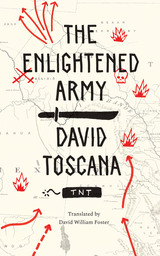 The Enlightened Army
By David Toscana; translated by David William Foster
University of Texas Press, 2019 Ignacio Matus is a public school history teacher in Monterrey, Mexico, who gets fired because of his patriotic rantings about Mexico’s repeated humiliations by the United States. Not only did Mexico’s northern neighbor steal a large swath of the country in the Mexican-American War, but according to Matus it also denied him Olympic glory. Excluded from the 1924 Olympics, Matus ran his own parallel marathon and beat the time of the American who officially won the bronze medal. After spending decades attempting to vindicate his supposed triumph and claim the medal, Matus seeks an even bigger vindication—he will reconquer Texas for Mexico! Recruiting an army of “los iluminados,” the enlightened ones, Matus sets off on a quest as worthy of Don Quixote as it is doomed. David Toscana is one of Latin America’s leading contemporary writers, and his books have won several prestigious awards, including the Casa de las Américas Prize for The Enlightened Army. The novel’s treatment of the troubled relations between Mexico and the United States makes it highly topical at a time when immigration and border walls capture headlines, while its lyrical writing and humorous take on the absurdities of everyday life offer timeless pleasures.
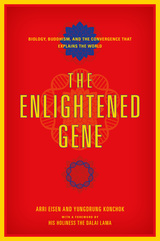 The Enlightened Gene: Biology, Buddhism, and the Convergence that Explains the World
Arri Eisen and Yungdrung Konchok
University Press of New England, 2017 Eight years ago, in an unprecedented intellectual endeavor, the Dalai Lama invited Emory University to integrate modern science into the education of the thousands of Tibetan Buddhist monks and nuns in exile in India. This project, the Emory Tibet Science Initiative, became the first major change in the monastic curriculum in six centuries. Eight years in, the results are transformative. The singular backdrop of teaching science to Tibetan Buddhist monks and nuns offered provocative insights into how science and religion can work together to enrich each other, as well as to shed light on life and what it means to be a thinking, biological human. In The Enlightened Gene, Emory University Professor Dr. Arri Eisen, together with monk Geshe Yungdrung Konchok explore the striking ways in which the integration of Buddhism with cutting-edge discoveries in the biological sciences can change our understanding of life and how we live it. What this book discovers along the way will fundamentally change the way you think. Are humans inherently good? Where does compassion come from? Is death essential for life? Is experience inherited? These questions have occupied philosophers, religious thinkers and scientists since the dawn of civilization, but in today’s political discourse, much of the dialogue surrounding them and larger issues—such as climate change, abortion, genetically modified organisms, and evolution—are often framed as a dichotomy of science versus spirituality. Strikingly, many of new biological discoveries—such as the millions of microbes that we now know live together as part of each of us, the connections between those microbes and our immune systems, the nature of our genomes and how they respond to the environment, and how this response might be passed to future generations—can actually be read as moving science closer to spiritual concepts, rather than further away. The Enlightened Gene opens up and lays a foundation for serious conversations, integrating science and spirit in tackling life’s big questions. Each chapter integrates Buddhism and biology and uses striking examples of how doing so changes our understanding of life and how we lead it.
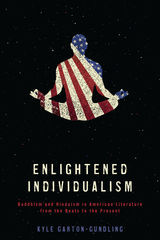 Enlightened Individualism: Buddhism and Hinduism in American Literature from the Beats to the Present
Kyle Garton-Gundling
Ohio State University Press, 2019 Buddhism and Hinduism have spread in the US largely through texts and are now recognizable facets of American literature and culture. But the US has defined itself through goal-oriented individualism, whereas Buddhism and Hinduism teach that individuality is a delusion and thus worldly desires are misguided. Given this apparent contradiction, what can Buddhist and Hindu influences offer American identities? Enlightened Individualism explores how post-1945 American writers, including Jack Kerouac, Alice Walker, and Maxine Hong Kingston, have tried to answer this question. Playing on enlightenment as both Anglo-American liberalism and Asian mysticism, this book argues that recent American literature seeks to reconcile seemingly incompatible liberal models of individual autonomy with Buddhist and Hindu ideals of transcending selfhood.
This “enlightened individualism” uses Buddhist and Hindu philosophy to reframe American freedom in terms of spiritual liberation, and it also reinterprets Asian teachings through Western traditions of political activism and countercultural provocation. Garton-Gundling argues that even though works by Kerouac, Walker, Kingston, and others wrestle with issues of exoticism and appropriation, their characters are also meaningfully challenged and changed by Asian faiths. These literary adaptations, then, can help Americans reenvision individualism in a more transcendent and cosmopolitan context.
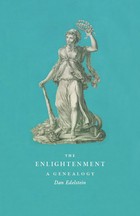 The Enlightenment: A Genealogy
Dan Edelstein
University of Chicago Press, 2010 What was the Enlightenment? Though many scholars have attempted to solve this riddle, none has made as much use of contemporary answers as Dan Edelstein does here. In seeking to recover where, when, and how the concept of “the Enlightenment” first emerged, Edelstein departs from genealogies that trace it back to political and philosophical developments in England and the Dutch Republic. According to Edelstein, by the 1720s scholars and authors in France were already employing a constellation of terms—such as l’esprit philosophique—to describe what we would today call the Enlightenment. But Edelstein argues that it was within the French Academies, and in the context of the Quarrel of the Ancients and the Moderns, that the key definition, concepts, and historical narratives of the Enlightenment were crafted. A necessary corrective to many of our contemporary ideas about the Enlightenment, Edelstein’s book turns conventional thinking about the period on its head. Concise, clear, and contrarian, The Enlightenment will be welcomed by all teachers and students of the period.
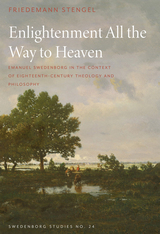 Enlightenment All the Way to Heaven: Emanuel Swedenborg in the Context of Eighteenth-Century Theology and Philosophy
Friedemann Stengel
Swedenborg Foundation Publishers, 2023 Enlightenment All the Way to Heaven: Emanuel Swedenborg in the Context of Eighteenth-Century Theology and Philosophy is an English translation of Friedemann Stengel’s 2009 German habilitation (qualifying) thesis, which was published by Mohr Siebeck Tübingen in 2011, Aufklärung bis zum Himmel: Emanuel Swedenborg im Kontext der Theologie und Philosophie des 18. Jahrhunderts. In this volume, Stengel provides a survey of Swedenborg’s philosophical influences, as well as an assessment of Swedenborg’s own influence on the German theology of his time, thereby giving the reader new insight into the nature of the Enlightenment. Exploring Swedenborg’s many inspirations, from Plato to Aristotle, Augustine to Descartes, and Malebranche to Leibniz, just to name a few, Stengel shows the breadth of their impact on Swedenborg and the resultant sophistication of the Swedish prophet’s ideas.
By broadening the conversation surrounding Swedenborg’s source and reception histories, Stengel hopes to counter the reductive lenses through which certain of Swedenborg’s experiences have been filtered. In the author’s own words, “this will serve to highlight the perspectives contained within the historical discourse, tracing their seminal influence on later religious and philosophical discussions that, in turn, gave rise, from the eighteenth century onward, to the psychohistorical interpretations of associated supernatural phenomena such as Swedenborg’s visionary propensity.”
Enlightenment All the Way to Heaven is the twenty-fourth installment in the Swedenborg Studies scholarly series.
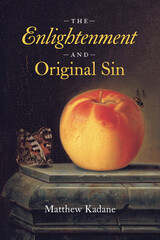 The Enlightenment and Original Sin
Matthew Kadane
University of Chicago Press, 2024 An eloquent microhistory that argues for the centrality of the doctrine of original sin to the Enlightenment.
What was the Enlightenment? This question has been endlessly debated. In The Enlightenment and Original Sin, historian Matthew Kadane advances the bold claim that the Enlightenment is best defined through what it set out to accomplish, which was nothing short of rethinking the meaning of human nature.
Kadane argues that this project centered around the doctrine of original sin and, ultimately, its rejection, signaling the radical notion that an inherently flawed nature can be overcome by human means. Kadane explores this and other wide-ranging themes through the story of a previously unknown figure, Pentecost Barker, an eighteenth-century purser and wine merchant. By examining Barker’s personal diary and extensive correspondence with a Unitarian minister, Kadane tracks the transformation of Barker’s consciousness from a Puritan to an Enlightenment outlook, revealing through one man’s journey the large-scale shifts in self-understanding whose philosophical reverberations have shaped debates on human nature for centuries.
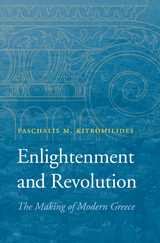 Enlightenment and Revolution: The Making of Modern Greece
Paschalis M. Kitromilides
Harvard University Press, 2013 Greece sits at the center of a geopolitical storm that threatens the stability of the European Union. To comprehend how this small country precipitated such an outsized crisis, it is necessary to understand how Greece developed into a nation in the first place, Paschalis Kitromilides contends. Enlightenment and Revolution identifies the intellectual trends and ideological traditions that shaped a religiously defined community of Greek-speaking people into a modern nation-state--albeit one in which antiliberal forces have exacted a high price.
Kitromilides takes in the vast sweep of the Greek Enlightenment in the eighteenth and nineteenth centuries, assessing key developments such as the translation of Voltaire, Locke, and other modern authors into Greek; the conflicts sparked by the Newtonian scientific revolution; the rediscovery of the civilization of classical Greece; and the emergence of a powerful countermovement. He highlights Greek thinkers such as Voulgaris and Korais, showing how these figures influenced and converged with currents of the Enlightenment in the rest of Europe.
In reconstructing this history, Kitromilides demonstrates how the confrontation between Enlightenment ideas and Church-sanctioned ideologies shaped the culture of present-day Greece. When the Greek nation-state emerged from a decade-long revolutionary struggle against the Ottoman Empire in the early nineteenth century, the Enlightenment dream of a free Greek polity was soon overshadowed by a romanticized nationalist and authoritarian vision. The failure to create a modern liberal state at that decisive historic moment, Kitromilides insists, is at the root of Greece's recent troubles.
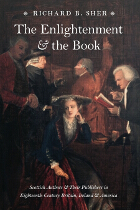 The Enlightenment and the Book: Scottish Authors and Their Publishers in Eighteenth-Century Britain, Ireland, and America
Richard B. Sher
University of Chicago Press, 2007 The late eighteenth century witnessed an explosion of intellectual activity in Scotland by such luminaries as David Hume, Adam Smith, Hugh Blair, William Robertson, Adam Ferguson, James Boswell, and Robert Burns. And the books written by these seminal thinkers made a significant mark during their time in almost every field of polite literature and higher learning throughout Britain, Europe, and the Americas.
In this magisterial history, Richard B. Sher breaks new ground for our understanding of the Enlightenment and the forgotten role of publishing during that period. The Enlightenment and the Book seeks to remedy the common misperception that such classics as The Wealth of Nations and The Life of Samuel Johnson were written by authors who eyed their publishers as minor functionaries in their profession. To the contrary, Sher shows how the process of bookmaking during the late eighteenth-century involved a deeply complex partnership between authors and their publishers, one in which writers saw the book industry not only as pivotal in the dissemination of their ideas, but also as crucial to their dreams of fame and monetary gain. Similarly, Sher demonstrates that publishers were involved in the project of bookmaking in order to advance human knowledge as well as to accumulate profits.
The Enlightenment and the Book explores this tension between creativity and commerce that still exists in scholarly publishing today. Lavishly illustrated and elegantly conceived, it will be must reading for anyone interested in the history of the book or the production and diffusion of Enlightenment thought.
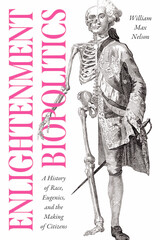 Enlightenment Biopolitics: A History of Race, Eugenics, and the Making of Citizens
William Max Nelson
University of Chicago Press, 2024 A wide-ranging history tracing the birth of biopolitics in Enlightenment thought and its aftermath.
In Enlightenment Biopolitics, historian William Max Nelson pursues the ambitious task of tracing the context in which biopolitical thought emerged and circulated. He locates that context in the Enlightenment when emancipatory ideals sat alongside the horrors of colonialism, slavery, and race-based discrimination. In fact, these did not just coexist, Nelson argues; they were actually mutually constitutive of Enlightenment ideals.
In this book, Nelson focuses on Enlightenment-era visions of eugenics (including proposals to establish programs of selective breeding), forms of penal slavery, and spurious biological arguments about the supposed inferiority of particular groups. The Enlightenment, he shows, was rife with efforts to shape, harness, and “organize” the minds and especially the bodies of subjects and citizens. In his reading of the birth of biopolitics and its transformations, Nelson examines the shocking conceptual and practical connections between inclusion and exclusion, equality and inequality, rights and race, and the supposed “improvement of the human species” and practices of dehumanization.
 Enlightenment in Colonial Egypt: Ahmad Lutfi al-Sayyid in His Generation
Israel Gershoni and Molly Bernstein
University of Texas Press, 2026 A study of Ahmad Lutfi al-Sayyid, widely recognized as the creator of Egyptian nationalism, and his impact on Egyptian culture and history. Ahmad Lutfi al-Sayyid (1872–1963) stands among the most creative, impactful intellectuals of modern Egypt and the Middle East. While best known as the architect of Egyptian nationalism, his nationalist endeavor was in fact part of his broader project to bring enlightenment to Egypt under the yoke of British colonialism. Through his articles, editorials, and mentoring, his newspaper al-Jarida became a key forum for the lively debates of the time, ranging from the role of Islam in society to women's inclusion, all toward shaping a unique colonial modernity for his country. The most comprehensive study of Lutfi, his writing, and his impact—Enlightenment in Colonial Egypt deconstructs the view that he was a covert apologist of empire out of admiration for the liberal aspects of European enlightenment. Lutfi faced this duality head on: He believed it essential to embrace parts of the West’s Enlightenment values and to decolonize and Egyptianize them in order to establish an authentic, indigenous, Egyptian civilization, appropriate for modernity. Israel Gershoni and Molly Bernstein argue that Lutfi successfully engaged with these most difficult challenges, shaping a detailed plan to implement enlightenment in the Egyptian national context.
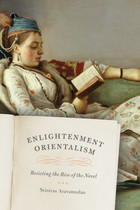 Enlightenment Orientalism: Resisting the Rise of the Novel
Srinivas Aravamudan
University of Chicago Press, 2011 Srinivas Aravamudan here reveals how Oriental tales, pseudo-ethnographies, sexual fantasies, and political satires took Europe by storm during the eighteenth century. Naming this body of fiction Enlightenment Orientalism, he poses a range of urgent questions that uncovers the interdependence of Oriental tales and domestic fiction, thereby challenging standard scholarly narratives about the rise of the novel. More than mere exoticism, Oriental tales fascinated ordinary readers as well as intellectuals, taking the fancy of philosophers such as Voltaire, Montesquieu, and Diderot in France, and writers such as Defoe, Swift, and Goldsmith in Britain. Aravamudan shows that Enlightenment Orientalism was a significant movement that criticized irrational European practices even while sympathetically bridging differences among civilizations. A sophisticated reinterpretation of the history of the novel, Enlightenment Orientalism is sure to be welcomed as a landmark work in eighteenth-century studies.
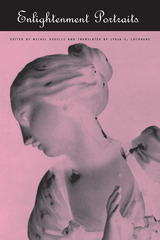 Enlightenment Portraits
Edited by Michel Vovelle
University of Chicago Press, 1997 Enlightenment Portraits permits us to see direct actors in history, people who took an active part in the collective adventures that put the human being at the center of Western civilizations vision of the world: nobles, priests, functionaries, men of letters, artists, and explorers, also soldiers and women.
The Enlightenment's leading figures cast their light in an irregular and unequal way: areas and environments in which new ideas penetrated and took effect alternated with shadowy patches. The fundamental structures of society may have remained stable, but new ways of producing, of being, and of appearing made sometimes abrupt headway. Attitudes toward life, birth, love, marriage and sexuality, and death had begun to change.
The twilight of the Enlightenment came at the end of the eighteenth century, part of a sequence of events of which the French Revolutions was simply the paroxysm.
A subtle and complex study of the Enlightenment, this book allows contemporary readers to reflect on how nineteenth- and twentieth-century scholars have constructed their views on eighteenth-century man.
 Enlightenment, Revolution, and Romanticism: The Genesis of Modern German Political Thought, 1790–1800
Frederick C. Beiser
Harvard University Press, 1992 “They join the greatest boldness in thought to the most obedient character.” So Madame de Stael described German intellectuals at the close of the 18th century, and her view of this schism between the intellectual and the political has stood virtually unchallenged for 200 years. This book lays to rest Madam de Stael's legacy, the myth of the apolitical German. In a narrative history of ideas that proceeds from his book The Fate of Reason, Frederick Beiser discusses how the French Revolution, with a rationalism and an irrationalism that altered the world, transformed and politicized German philosophy and its central concern: the authority and limits of reason. In Germany, three antithetical political traditions—liberalism, conservatism, and romanticism—developed in response to the cataclysmic events in France.
Enlightenment, Revolution, and Romanticism establishes the genesis and context of these traditions and illuminates their fundamental political ideas. Moving from such well-known figures as Kant, Fichte, Jacobi, Forster, and Moser, Beiser summarizes responses to the French Revolution by the major political thinkers of the period. He investigates the sources for their political theory before the 1790s and assesses the importance of politics for their thought in general. By concentrating on a single formative decade, Beiser aims to reveal the political values and purposes underlying German thought in the late 18th century and ultimately to clarify the place of practical reason in the German philosophical tradition.
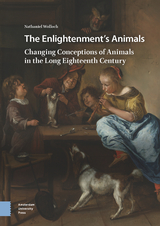 The Enlightenment's Animals: Changing Conceptions of Animals in the Long Eighteenth Century
Nathaniel Wolloch
Amsterdam University Press, 2019 In The Enlightenment’s Animals Nathaniel Wolloch takes a broad view of changing conceptions of animals in European culture during the long eighteenth century. Combining discussions of intellectual history, the history of science, the history of historiography, the history of economic thought, and, not least, art history, this book describes how animals were discussed and conceived in different intellectual and artistic contexts underwent a dramatic shift during this period. While in the seventeenth century and the first half of the eighteenth century the main focus was on the sensory and cognitive characteristics of animals, during the late Enlightenment a new outlook emerged, emphasizing their conception as economic resources. Focusing particularly on seventeenth-century Dutch culture, and on the Scottish Enlightenment, Wolloch discusses developments in other countries as well, presenting a new look at a topic of increasing importance in modern scholarship.
 Enlisting Faith: How the Military Chaplaincy Shaped Religion and State in Modern America
Ronit Y. Stahl
Harvard University Press, 2017 A century ago, as the United States prepared to enter World War I, the military chaplaincy included only mainline Protestants and Catholics. Today it counts Jews, Mormons, Muslims, Christian Scientists, Buddhists, Seventh-day Adventists, Hindus, and evangelicals among its ranks. Enlisting Faith traces the uneven processes through which the military struggled with, encouraged, and regulated religious pluralism over the twentieth century.
Moving from the battlefields of Europe to the jungles of Vietnam and between the forests of Civilian Conservation Corps camps and meetings in government offices, Ronit Y. Stahl reveals how the military borrowed from and battled religion. Just as the state relied on religion to sanction war and sanctify death, so too did religious groups seek recognition as American faiths. At times the state used religion to advance imperial goals. But religious citizens pushed back, challenging the state to uphold constitutional promises and moral standards.
Despite the constitutional separation of church and state, the federal government authorized and managed religion in the military. The chaplaincy demonstrates how state leaders scrambled to handle the nation’s deep religious, racial, and political complexities. While officials debated which clergy could serve, what insignia they would wear, and what religions appeared on dog tags, chaplains led worship for a range of faiths, navigated questions of conscience, struggled with discrimination, and confronted untimely death. Enlisting Faith is a vivid portrayal of religious encounters, state regulation, and the trials of faith—in God and country—experienced by the millions of Americans who fought in and with the armed forces.
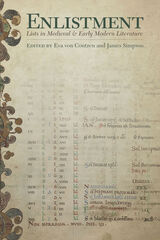 Enlistment: Lists in Medieval and Early Modern Literature
Edited by Eva von Contzen and James Simpson
Ohio State University Press, 2022 Bestiaries. Lapidaries. Lunaries. Inventories and household vocabularies. Lists are everywhere in medieval and early modern texts––evidence of the need to manage and order knowledge and experience. Yet until now, listing as a formal practice has received scant scholarly attention. In Enlistment, foremost medievalists and early modernists from both the Anglo-American and German traditions investigate the humble list as a platform for better understanding how and why lists captivated period audiences. From epic catalogues of trees in Geoffrey Chaucer and Edmund Spenser to genealogies and the names of the divine, the lists in question come from a variety of periods, languages, and genres. Throughout, contributors demonstrate how lists have the curious capacity to challenge our categories of thinking and ordering of the world. The lists we encounter in medieval and early modern literature can thus be seen as seismographs of cultural knowledge and also as testing grounds for defining the ineffable, or unfathomable, or that which would be dangerous if otherwise expressed. Contributors: Suzanne Conklin Akbari, Ingo Berensmeyer, Eva von Contzen, Alex Davis, Andrew James Johnston, Wolfram R. Keller, Alexis Kellner Becker, Kathryn Mogk Wagner, Martha Rust, James Simpson
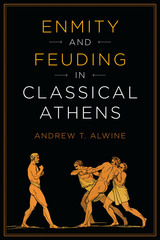 Enmity and Feuding in Classical Athens
By Andrew Alwine
University of Texas Press, 2015 Much has been written about the world’s first democracy, but no book so far has been dedicated solely to the study of enmity in ancient Athens. Enmity and Feuding in Classical Athens is a long-overdue analysis of the competitive power dynamics of Athenian honor and the potential problems these feuds created for democracies. The citizens of Athens believed that harming one’s enemy was an acceptable practice and even the duty of every honorable citizen. They sought public wins over their rivals, making enmity a critical element in struggles for honor and standing, while simultaneously recognizing the threat that personal enmity posed to the community. Andrew Alwine works to understand how Athenians addressed this threat by looking at the extant work of Attic orators. Their speeches served as the intersection between private vengeance and public sanction of illegal behavior, allowing citizens to engage in feuds within established parameters. This mediation helped support Athenian democracy and provided the social underpinning to allow it to function in conjunction with Greek notions of personal honor. Alwine provides a framework for understanding key issues in the history of democracy, such as the relationship between private and public realms, the development of equality and the rule of law, and the establishment of individual political rights. Serving also as a nuanced introduction to the works of the Attic orators, Enmity and Feuding in Classical Athens is an indispensable addition to scholarship on Athens.
 Ennead II
Plotinus
Harvard University Press Plato’s most influential disciple and proponent.
Plotinus (AD 204/5–270), possibly of Roman descent, but certainly a Greek in education and environment, was the first and greatest of Neoplatonic philosophers. Practically nothing is known of his early life, but at the age of 28 he went to Alexandria, and studied philosophy with Ammonius “Saccas” for eleven years. Wishing to learn the philosophy of the Persians and Indians, he joined the expedition of Gordian III against the Persians in 243, not without subsequent danger. Aged 40 he settled in Rome and taught philosophy there till shortly before his death. In 253 he began to write, and continued to do so till the last year of his life. His writings were edited by his disciple Porphyry, who published them many years after his master’s death in six sets of nine treatises each (the Enneads).
Plotinus regarded Plato as his master, and his own philosophy is a profoundly original development of the Platonism of the first two centuries of the Christian era and the closely related thought of the Neopythagoreans, with some influences from Aristotle and his followers and the Stoics, whose writings he knew well but used critically. There is no real trace of Oriental influence on his thought, and he was passionately opposed to Gnosticism. He is a unique combination of mystic and Hellenic rationalist. His thought dominated later Greek philosophy and influenced both Christians and Muslims, and is still alive today because of its union of rationality and intense religious experience.
The Loeb Classical Library edition of Plotinus is in seven volumes.
 Ennead III
Plotinus
Harvard University Press Plato’s most influential disciple and proponent.
Plotinus (AD 204/5–270), possibly of Roman descent, but certainly a Greek in education and environment, was the first and greatest of Neoplatonic philosophers. Practically nothing is known of his early life, but at the age of 28 he went to Alexandria, and studied philosophy with Ammonius “Saccas” for eleven years. Wishing to learn the philosophy of the Persians and Indians, he joined the expedition of Gordian III against the Persians in 243, not without subsequent danger. Aged 40 he settled in Rome and taught philosophy there till shortly before his death. In 253 he began to write, and continued to do so till the last year of his life. His writings were edited by his disciple Porphyry, who published them many years after his master’s death in six sets of nine treatises each (the Enneads).
Plotinus regarded Plato as his master, and his own philosophy is a profoundly original development of the Platonism of the first two centuries of the Christian era and the closely related thought of the Neopythagoreans, with some influences from Aristotle and his followers and the Stoics, whose writings he knew well but used critically. There is no real trace of Oriental influence on his thought, and he was passionately opposed to Gnosticism. He is a unique combination of mystic and Hellenic rationalist. His thought dominated later Greek philosophy and influenced both Christians and Muslims, and is still alive today because of its union of rationality and intense religious experience.
The Loeb Classical Library edition of Plotinus is in seven volumes.
 Ennead IV
Plotinus
Harvard University Press, 1966 Plato’s most influential disciple and proponent.
Plotinus (AD 204/5–270), possibly of Roman descent, but certainly a Greek in education and environment, was the first and greatest of Neoplatonic philosophers. Practically nothing is known of his early life, but at the age of 28 he went to Alexandria, and studied philosophy with Ammonius “Saccas” for eleven years. Wishing to learn the philosophy of the Persians and Indians, he joined the expedition of Gordian III against the Persians in 243, not without subsequent danger. Aged 40 he settled in Rome and taught philosophy there till shortly before his death. In 253 he began to write, and continued to do so till the last year of his life. His writings were edited by his disciple Porphyry, who published them many years after his master’s death in six sets of nine treatises each (the Enneads).
Plotinus regarded Plato as his master, and his own philosophy is a profoundly original development of the Platonism of the first two centuries of the Christian era and the closely related thought of the Neopythagoreans, with some influences from Aristotle and his followers and the Stoics, whose writings he knew well but used critically. There is no real trace of Oriental influence on his thought, and he was passionately opposed to Gnosticism. He is a unique combination of mystic and Hellenic rationalist. His thought dominated later Greek philosophy and influenced both Christians and Muslims, and is still alive today because of its union of rationality and intense religious experience.
The Loeb Classical Library edition of Plotinus is in seven volumes.
 Ennead V
Plotinus
Harvard University Press Plato’s most influential disciple and proponent.
Plotinus (AD 204/5–270), possibly of Roman descent, but certainly a Greek in education and environment, was the first and greatest of Neoplatonic philosophers. Practically nothing is known of his early life, but at the age of 28 he went to Alexandria, and studied philosophy with Ammonius “Saccas” for eleven years. Wishing to learn the philosophy of the Persians and Indians, he joined the expedition of Gordian III against the Persians in 243, not without subsequent danger. Aged 40 he settled in Rome and taught philosophy there till shortly before his death. In 253 he began to write, and continued to do so till the last year of his life. His writings were edited by his disciple Porphyry, who published them many years after his master’s death in six sets of nine treatises each (the Enneads).
Plotinus regarded Plato as his master, and his own philosophy is a profoundly original development of the Platonism of the first two centuries of the Christian era and the closely related thought of the Neopythagoreans, with some influences from Aristotle and his followers and the Stoics, whose writings he knew well but used critically. There is no real trace of Oriental influence on his thought, and he was passionately opposed to Gnosticism. He is a unique combination of mystic and Hellenic rationalist. His thought dominated later Greek philosophy and influenced both Christians and Muslims, and is still alive today because of its union of rationality and intense religious experience.
The Loeb Classical Library edition of Plotinus is in seven volumes.
 Ennead VI.1–5
Plotinus
Harvard University Press Plato’s most influential disciple and proponent.
Plotinus (AD 204/5–270), possibly of Roman descent, but certainly a Greek in education and environment, was the first and greatest of Neoplatonic philosophers. Practically nothing is known of his early life, but at the age of 28 he went to Alexandria, and studied philosophy with Ammonius “Saccas” for eleven years. Wishing to learn the philosophy of the Persians and Indians, he joined the expedition of Gordian III against the Persians in 243, not without subsequent danger. Aged 40 he settled in Rome and taught philosophy there till shortly before his death. In 253 he began to write, and continued to do so till the last year of his life. His writings were edited by his disciple Porphyry, who published them many years after his master’s death in six sets of nine treatises each (the Enneads).
Plotinus regarded Plato as his master, and his own philosophy is a profoundly original development of the Platonism of the first two centuries of the Christian era and the closely related thought of the Neopythagoreans, with some influences from Aristotle and his followers and the Stoics, whose writings he knew well but used critically. There is no real trace of Oriental influence on his thought, and he was passionately opposed to Gnosticism. He is a unique combination of mystic and Hellenic rationalist. His thought dominated later Greek philosophy and influenced both Christians and Muslims, and is still alive today because of its union of rationality and intense religious experience.
The Loeb Classical Library edition of Plotinus is in seven volumes.
 Ennead VI.6–9
Plotinus
Harvard University Press Plato’s most influential disciple and proponent.
Plotinus (AD 204/5–270), possibly of Roman descent, but certainly a Greek in education and environment, was the first and greatest of Neoplatonic philosophers. Practically nothing is known of his early life, but at the age of 28 he went to Alexandria, and studied philosophy with Ammonius “Saccas” for eleven years. Wishing to learn the philosophy of the Persians and Indians, he joined the expedition of Gordian III against the Persians in 243, not without subsequent danger. Aged 40 he settled in Rome and taught philosophy there till shortly before his death. In 253 he began to write, and continued to do so till the last year of his life. His writings were edited by his disciple Porphyry, who published them many years after his master’s death in six sets of nine treatises each (the Enneads).
Plotinus regarded Plato as his master, and his own philosophy is a profoundly original development of the Platonism of the first two centuries of the Christian era and the closely related thought of the Neopythagoreans, with some influences from Aristotle and his followers and the Stoics, whose writings he knew well but used critically. There is no real trace of Oriental influence on his thought, and he was passionately opposed to Gnosticism. He is a unique combination of mystic and Hellenic rationalist. His thought dominated later Greek philosophy and influenced both Christians and Muslims, and is still alive today because of its union of rationality and intense religious experience.
The Loeb Classical Library edition of Plotinus is in seven volumes.
 Ennobling Japan’s Savage Northeast: Tōhoku as Japanese Postwar Thought, 1945–2011
Nathan Hopson
Harvard University Press Ennobling Japan’s Savage Northeast is the first comprehensive account in English of the discursive life of the Tōhoku region in postwar Japan from 1945 through 2011. The Northeast became the subject of world attention with the March 2011 triple disaster of earthquake, tsunami, and nuclear meltdown. But Tōhoku’s history and significance to emic understandings of Japanese self and nationhood remain poorly understood. When Japan embarked on its quest to modernize in the mid-nineteenth century, historical prejudice, contemporary politics, and economic calculation together led the state to marginalize Tōhoku, creating a “backward” region in both fact and image. After 1945, a group of mostly local intellectuals attempted to overcome this image and rehabilitate the Northeast as a source of new national values. This early postwar Tōhoku recuperation movement has proved to be a critical source for the new Kyoto school’s neoconservative valorization of native Japanese identity, fueling that group’s antimodern, anti-Western discourse since the 1980s.
Nathan Hopson unravels the contested postwar meanings of Tōhoku to reveal the complex and contradictory ways in which that region has been incorporated into Japan’s shifting self-images since World War II.
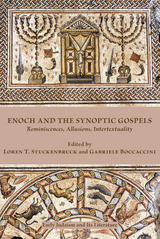 Enoch and the Synoptic Gospels: Reminiscences, Allusions, Intertextuality
Loren T. Stuckenbruck
SBL Press, 2016 Essential research for students and scholars of Second Temple Judaism and the New Testament
Since Richard Laurence published the first English translation of 1 Enoch in 1821, its importance for an understanding of early Christianity has been generally recognized. The present volume is the first book of essays contributed by international specialists in Second Temple Judaism devoted to the significance of traditions found in 1 Enoch for the interpretation of the Synoptic Gospels in the New Testament. Areas covered by the contributions include demonology, Christology, angelology, cosmology, birth narratives, forgiveness of sins, veneration, wisdom, and priestly tradition. The contributors are Joseph L. Angel, Daniel Assefa, Leslie Baynes, Gabriele Boccaccini, Kelley Coblentz Bautch, Henryk Drawnel, André Gagné, Lester L. Grabbe, Daniel M. Gurtner, Andrei A. Orlov, Anders Klostergaard Petersen, Amy E. Richter, Loren T. Stuckenbruck, Benjamin Wold, and Archie T. Wright.
Features:
- Multiple approaches to thinking about the relationship between 1 Enoch and the Synoptic Gospels
- Exploration of the common socio-cultural and religious framework within which the traditions concerning Enoch and Jesus developed
- Articles presented at the Seventh Enoch Seminar in 2013
The Enormous Vogue of Things Mexican: Cultural Relations between the United States and Mexico, 1920-1935
Helen Delpar
University of Alabama Press, 1995 Beginning about 1900 the expanded international role of the United States brought increased attention to the cultures of other peoples and a growth of interest in Latin America. The Enormous Vogue of Things Mexican traces the evolution of cultural relations between the United States and Mexico from 1920 to 1935, identifying the individuals, institutions, and themes that made up this fascinating chapter in the history of the two countries.
Enos Mills: Citizen of Nature
Alexander Drummond
University Press of Colorado, 1995 Enos Mills (1870-1922) was the quintessential voice of the Rocky Mountains in the early decades of the twentieth century, and he achieved fame as a naturalist and nature writer, conservation pioneer, lecturer, and mountain adventurer. Enos Mills: Citizen of Nature is the first full-length examination of Mills and his work, an incisive account of a complex, controversial, and often difficult man who touched millions of lives in his time and whose legacy has great relevance today.
 Enquiry into Plants, Volume I: Books 1–5
Theophrastus
Harvard University Press The first fruits of Greek botany.
Theophrastus of Eresus in Lesbos, born about 370 BC, is the author of the most important botanical works that have survived from classical antiquity. He was in turn student, collaborator, and successor of Aristotle. Like his predecessor he was interested in all aspects of human knowledge and experience, especially natural science. His writings on plants form a counterpart to Aristotle’s zoological works.
In the Enquiry into Plants Theophrastus classifies and describes varieties—covering trees, plants of particular regions, shrubs, herbaceous plants, and cereals; in the last of the nine books he focuses on plant juices and medicinal properties of herbs. This edition is in two volumes; the second contains two additional treatises, On Odours and Weather Signs.
In De causis plantarum Theophrastus turns to plant physiology. Books 1 and 2 are concerned with generation, sprouting, flowering and fruiting, and the effects of climate. In Books 3 and 4 Theophrastus studies cultivation and agricultural methods. In Books 5 and 6 he discusses plant breeding; diseases and other causes of death; and distinctive flavors and odors. The Loeb Classical Library edition is in three volumes.
Theophrastus’ celebrated Characters is of a quite different nature. This collection of descriptive sketches is the earliest known character-writing and a striking reflection of contemporary life.
 Enquiry into Plants, Volume II: Books 6–9
Theophrastus
Harvard University Press The first fruits of Greek botany.
Theophrastus of Eresus in Lesbos, born about 370 BC, is the author of the most important botanical works that have survived from classical antiquity. He was in turn student, collaborator, and successor of Aristotle. Like his predecessor he was interested in all aspects of human knowledge and experience, especially natural science. His writings on plants form a counterpart to Aristotle’s zoological works.
In the Enquiry into Plants Theophrastus classifies and describes varieties—covering trees, plants of particular regions, shrubs, herbaceous plants, and cereals; in the last of the nine books he focuses on plant juices and medicinal properties of herbs. This edition is in two volumes; the second contains two additional treatises, On Odours and Weather Signs.
In De causis plantarum Theophrastus turns to plant physiology. Books 1 and 2 are concerned with generation, sprouting, flowering and fruiting, and the effects of climate. In Books 3 and 4 Theophrastus studies cultivation and agricultural methods. In Books 5 and 6 he discusses plant breeding; diseases and other causes of death; and distinctive flavors and odors. The Loeb Classical Library edition is in three volumes.
Theophrastus’ celebrated Characters is of a quite different nature. This collection of descriptive sketches is the earliest known character-writing and a striking reflection of contemporary life.
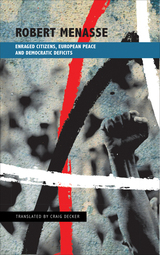 Enraged Citizens, European Peace and Democratic Deficits: Or Why the Democracy Given to Us Must Become One We Fight For
Robert Menasse
Seagull Books, 2016 In 2010, Robert Menasse journeyed to Brussels to begin work on a novel centered on the European Union. His extended stay resulted in a completely different book—Enraged Citizens, European Peace and Democratic Deficits, a work of nonfiction examining the history of the European project and the evolving politics of nation-states.
Spanning from the beginning of the transnational idea with 1951’s Montanunion—the European Coal and Steel Community—to the current financial crisis, Menasse focuses on the institutional structures and forces both advancing and obstructing the European project. Given the internal tensions among the European Commission, Parliament, and Council, Menasse argues that current problems that are frequently misunderstood as resulting from the financial crisis are, in fact, political. Along the way, he makes the bold claim that either the Europe of nation-states will perish—or the project of transcending the nation-states will.
A provocative book, Enraged Citizens, European Peace and Democratic Deficits deftly analyzes the financial and bureaucratic structures of the European Union and sheds much-needed light on the state of the debt crisis. Menasse brings his considerable literary expertise to the unraveling of the real state of the Union, along the way weaving an intriguing tale of one continent’s efforts to become a truly postnational democracy.
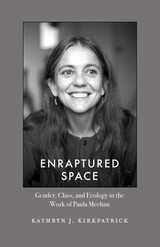 Enraptured Space: Gender, Class, and Ecology in the Work of Paula Meehan
Kathryn J. Kirkpatrick
West Virginia University Press, 2025 In the first book-length study of Paula Meehan, one of Ireland’s leading contemporary poets emerges as an original voice whose perspectives on gender, class, and ecology are transforming the Irish literary landscape and beyond. Drawing on her own lived experience as a practicing poet, Kathryn J. Kirkpatrick explores how scholarship is grounded in an imaginative exchange between the words on the page and the material conditions of the scholar who works to inhabit them. With chapters of literary analysis swimming in a conversation between two poets, this book breaches the boundaries between criticism and memoir, suggesting ways that every scholar is transformed by the subjects they study.
In Paula Meehan, Kirkpatrick has found a powerful poet to both study and love, and her reading of Meehan’s poetry and prose through the lenses of gender studies, the environmental humanities, and social class offers a passionate endorsement of Meehan’s radical interventions in the canon of Irish poetry. This work explores eight volumes of Meehan’s poetry, including Dharmakaya, Painting Rain, and Geomantic.
 Enriching Architecture: Craft and Its Conservation in Anglo-Irish building production, 1660–1760
Edited by Christine Casey and Melanie Hayes
University College London, 2023 An argument for taking the craft work of surface enrichment of buildings more seriously in architectural history.
Architectural history has tended to marginalize the many types of refinement and enrichment of surfaces in stone, wood, and plaster that were fundamental aspects of early modern architecture. Enriching Architecture aims to retrieve and rehabilitate surface achievement as a vital element of early modern buildings in Britain and Ireland, arguing for the historical legitimacy of creative craft skill as a primary agent in architectural production. The contributors draw upon the major rethinking of craft and materials within the wider cultural sphere in recent years to deconstruct traditional, oppositional ways of thinking about architectural production. The book explores broad themes of surface treatment such as wainscot, rustication, plasterwork, and staircase embellishment, along with chapters focused on virtuoso buildings and set pieces that illuminate these themes.
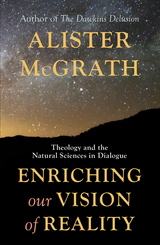 Enriching Our Vision of Reality: Theology and the Natural Sciences in Dialogue
Alister McGrath
Templeton Press, 2017
“Enriching our Vision of Reality is elegant, erudite, and animated by a constant enthusiasm for its subject. There is everything here—science, theology, philosophy, biography, even some poetry—all enlisted to help us to see the world as it is, both more clearly and with greater delight.” —Reverend Doctor Andrew Davison, Starbridge Lecturer in theology and natural sciences, University of Cambridge, and fellow in theology at Corpus Christi College
“It’s a pleasure to read an introduction to science and Christian belief that is both erudite and accessible. McGrath’s new book is rich with personal examples, biographies of famous scientists and theologians, and effective refutations of their detractors. This invitation to move forward from a bifurcated to an expansive view of reality is recommended for all who seek an ‘integrated understanding’ of science and Christian faith.” —Philip Clayton, editor of The Oxford Handbook of Religion and Science
In this exceptional volume, leading theologian Alister McGrath writes for scientists with an interest in theology, and Christians and theologians who are aware of the importance of the natural sciences. A scene-setting chapter explores the importance of the human quest for intelligibility. The focus then moves to three leading figures who have stimulated discussion about the relationship between science and theology in recent years: Charles Coulson, an Oxford professor of theoretical chemistry who was also a prominent Methodist lay preacher; Thomas F. Torrance, perhaps the finest British theologian of the twentieth-century; and John Polkinghorne, a theoretical physicist and theologian.
The final section of the book features six “parallel conversations” between science and theology, which lay the groundwork for the kind of enriched vision of reality the author hopes to encourage. Here, we are inspired to enjoy individual aspects of nature while seeking to interpret them in the light of deeper revelations about our gloriously strange universe.
Enrico Fermi, Physicist
Emilio Segrè
University of Chicago Press, 1972 Student, collaborator and lifelong friend of Enrico Fermi, Emilio Segrè presents a rich, well-rounded portrait of the scientist, his methods, intellectual history, and achievements. Explaining in nontechnical terms the scientific problems Fermi faced or solved, Enrico Fermi, Physicist contains illuminating material concerning Fermi's youth in Italy and the development of his scientific style.
Emilio Segre was awarded the Nobel Prize for Physics in 1959.
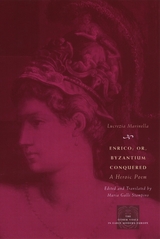 Enrico; or, Byzantium Conquered: A Heroic Poem
Lucrezia Marinella
University of Chicago Press, 2009 Lucrezia Marinella (1571–1653) is, by all accounts, a phenomenon in early modernity: a woman who wrote and published in many genres, whose fame shone brightly within and outside her native Venice, and whose voice is simultaneously original and reflective of her time and culture. In Enrico; or, Byzantium Conquered, one of the most ambitious and rewarding of her numerous narrative works, Marinella demonstrates her skill as an epic poet.
Now available for the first time in English translation, Enrico retells the story of the conquest of Byzantium in the Fourth Crusade (1202–04). Marinella intersperses historical events in her account of the invasion with numerous invented episodes, drawing on the rich imaginative legacy of the chivalric romance. Fast-moving, colorful, and narrated with the zest that characterizes Marinella’s other works, this poem is a great example of a woman engaging critically with a quintessentially masculine form and subject matter, writing in a genre in which the work of women poets was typically shunned.
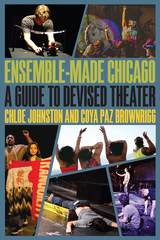 Ensemble-Made Chicago: A Guide to Devised Theater
Chloe Johnston and Coya Paz Brownrigg
Northwestern University Press, 2019 Featuring the work of: About Face Youth Theatre • Albany Park Theater Project • Barrel of Monkeys • Every house has a door • FEMelanin • 500 Clown • Free Street Theater • Honey Pot Performance • Lookingglass Theater • The Neo-Futurists • The Second City • Southside Ignoramus Quartet • Teatro Luna • Walkabout Theater • Young Fugitives Ensemble-Made Chicago brings together a wide range of Chicago theater companies to share strategies for cocreating performance. Cocreated theater breaks down the traditional roles of writer, director, and performer in favor of a more egalitarian approach in which all participants contribute to the creation of original material. Each chapter offers a short history of a Chicago company, followed by detailed exercises that have been developed and used by that company to build ensemble and generate performances. Companies included range in age from two to fifty years, represent different Chicago neighborhoods, and reflect both the storefront tradition and established cultural institutions. The book pays special attention to the ways the fight for social justice has shaped the development of this aesthetic in Chicago. Assembled from interviews and firsthand observations, Ensemble-Made Chicago is written in a lively and accessible style and will serve as an invaluable guide for students and practitioners alike, as well as an important archive of Chicago’s vibrant ensemble traditions. Readers will find new creative methods to enrich their own practice and push their work in new directions.
 Enslaved Africans and Their Descendants in Africa: Life Histories
Martin A. Klein and Stephen J. Rockel
Ohio University Press, 2025 An exploration of the resilient lives and legacies of enslaved Africans in Africa Unlike narratives focused on enslaved people in the Americas, Europe, or the Middle East, this edited collection highlights the lives of African slaves and their descendants who remained in Africa. The contributors chronicle lives spanning the continent, from Sierra Leone, Burkina Faso, Nigeria, Chad, and Cameroon to Egypt, Ethiopia, Tanzania, and South Africa. The collection explores various forms of slavery and diverse personal trajectories, with many stories beginning in childhood enslavement and evolving into adulthood with limited chances for education or personal advancement. Notably, the accounts include figures who managed to achieve prominent roles, such as a slave who became a general and administrator, a female slave who rose to be a village chief, and a woman who became a successful obstetrician in Muslim Africa. The narratives underscore the resilience and agency of the enslaved individuals, many of whom created meaningful lives despite the constraints and stigma of both slavery and post-slavery. Some, like a medical missionary in Tanganyika and a slave convert who helped grow the Catholic Church in Burkina Faso, contributed significantly to their communities and religious institutions. Accessing these stories required rigorous research due to limited documentation, social silence surrounding slavery, and stigma associated with slave ancestry. The contributors’ extensive research brings together fragmented knowledge and oral histories to provide an invaluable perspective and insight into the complex identities, struggles, and achievements of African slaves and their descendants. Contributors:
Richard Anderson
Dadda Astabarka
Abdourahman Halirou
Martin A. Klein
George Michael La Rue
Adam Mahamat
Ricardo Marquez Garcia
Stephen J. Rockel
Ute Röschenthaler
Mohammed Bashir Salau
Moris Samen
Sandra Rowoldt Shell
Joseph Jules Sinang
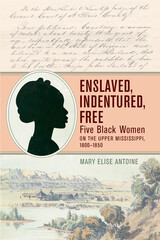 Enslaved, Indentured, Free: Five Black Women on the Upper Mississippi, 1800–1850
Mary Elise Antoine
Wisconsin Historical Society Press, 2022 The Northwest Ordinance of 1787 made slavery illegal in the territory that would later become Illinois, Indiana, Michigan, Ohio, Wisconsin, and part of Minnesota. However, many Black individuals’ rights were denied by white enslavers who continued to hold them captive in the territory well into the nineteenth century. Set in this period of American history, Enslaved, Indentured, Free shines a light on five extraordinary Black women—Marianne, Mariah, Patsey, Rachel, and Courtney—whose lives intersected in Prairie du Chien, Wisconsin.
Focusing on these five women, Mary Elise Antoine explores the history of slavery in the Upper Mississippi River Valley, relying on legal documents, military records, court transcripts, and personal correspondence. Whether through perseverance, self-purchase, or freedom suits—including one suit that was used as precedent in Dred and Harriet Scott’s freedom suits years later—each of these women ultimately secured her freedom, thanks in part to the bonds they forged with one another.
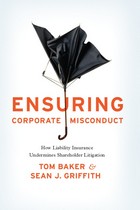 Ensuring Corporate Misconduct: How Liability Insurance Undermines Shareholder Litigation
Tom Baker and Sean J. Griffith
University of Chicago Press, 2010 Shareholder litigation and class action suits play a key role in protecting investors and regulating big businesses. But Directors and Officers liability insurance shields corporations and their managers from the financial consequences of many illegal acts, as evidenced by the recent Enron scandal and many of last year’s corporate financial meltdowns. Ensuring Corporate Misconduct demonstrates for the first time how corporations use insurance to avoid responsibility for corporate misconduct, dangerously undermining the impact of securities laws.
As Tom Baker and Sean J. Griffith demonstrate, this need not be the case. Opening up the formerly closed world of corporate insurance, the authors interviewed people from every part of the industry in order to show the different instances where insurance companies could step in and play a constructive role in strengthening corporate governance—yet currently do not. Ensuring Corporate Misconduct concludes with a set of readily implementable reforms that could significantly rehabilitate the system.
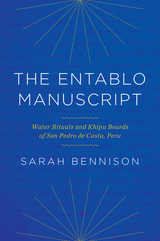 The Entablo Manuscript: Water Rituals and Khipu Boards of San Pedro de Casta, Peru
Sarah Bennison
University of Texas Press, 2022 A unique study of an Andean community’s water rituals and the extraordinary document describing how they should be performed
In the dry season in the Andes, water from springs, lakes, reservoirs, and melting glaciers feeds irrigation canals that have sustained communities for thousands of years. Managing and maintaining these water infrastructures is essential, and in 1921, in the village of San Pedro de Casta, Peru, local authorities recorded their ritual canal-cleaning duties in a Spanish-language document called the Entablo. It is only the second book (along with the Huarochirí Manuscript) ever seen by scholars in which an Andean community explains its customs and ritual laws in its own words. Sarah Bennison offers a critical introduction to the Entablo, a Spanish transcription of the document, and an English translation. Among its other revelations, the Entablo delves into the use of khipu boards, devices that meld the traditional knotted strings known as khipus with a written alphabet. Only in the Entablo do we learn that there were multiple khipu boards associated with a single canal-cleaning ritual, or that there were separate khipu records for men and women. The Entablo manuscript furnishes unparalleled insights into Andean rituals, religion, and community history at a historical moment when rural highland communities were changing rapidly.
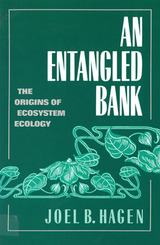 An Entangled Bank: The Origins of Ecosystem Ecology
Joel B. Hagen
Rutgers University Press, 1992 This book was a revelation. I was simply enthralled by Joel Hagen's brilliance in reviewing the emergence of the discipline of ecosystem ecology (the study of biotic-abiotic interaction and nutrient flows in ecological systems). He does a magnificent job of introducing the personalities that midwived the new science. He explains their intellectual struggles, philosophical cross-currents, and different academic milieux. He also expertly illuminates sociopolitical context. Through his in-depth research he is able to dispel some misconceptions and truismsm, arriving at the heart of what made each scientist tick. Even when exploring some of the arcane figures and dead-end developments, he is so compelling that they become integral to the story, not sidetracks.
His breadth of knowledge, his discerning inclusiveness, his clarity of thought, all make _An Entangled Bank_ a stimulating read. Very often in science courses we are presented only with the canonical "state of the science," having to swallow its agglomerated whole free of context. Hagen reveals the wisdom of understanding intellectual foundations. Through study of the origins and development of a science, we may better grasp the received tenets of current scientific understanding. As a young science, ecosystem ecology has a historical context that is relatively accessible to us, if less romantic than a tale of the origins of astronomy might be.
A peek into the labs and offices of botanists, limnologists, and biogeochemists might not seem like the acme of excitement. Hagen inspires us with his insights. He makes his subject meaningful to us. Though it is not pleasure reading by any stretch, its clear-sighted intellectual vigor makes _An Entangled Bank_ pure enjoyment.
Entangled Far Rights: A Russian-European Intellectual Romance in the Twentieth Century
Marlene Laruelle
University of Pittsburgh Press, 2018 Since the rise of Putin, many have puzzled by the strange affinity of the far right in the West for today's authoritarian Russia. Entangled Far Rights explores the deep roots of this phenomena and reveals it to be a running thread through the entire history of the long 20th century and present regardless of the changing political character of Russia's regimes.
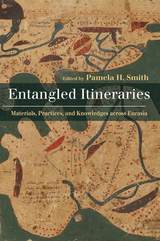 Entangled Itineraries: Materials, Practices, and Knowledges across Eurasia
Pamela H. Smith
University of Pittsburgh Press, 2019 Trade flowed across Eurasia, around the Indian Ocean, and over the Mediterranean for millennia, but in the early modern period, larger parts of the globe became connected through these established trade routes. Knowledge, embodied in various people, materials, texts, objects, and practices, also moved and came together along these routes in hubs of exchange where different social and cultural groups intersected and interacted.
Entangled Itineraries traces this movement of knowledge across the Eurasian continent from the early years of the Common Era to the nineteenth century, following local goods, techniques, tools, and writings as they traveled and transformed into new material and intellectual objects and ways of knowing. Focusing on nonlinear trajectories of knowledge in motion, this volume follows itineraries that weaved in and out of busy, crowded cosmopolitan cities in China; in the trade hubs of Kucha and Malacca; and in centers of Arabic scholarship, such as Reyy and Baghdad, which resonated in Bursa, Assam, and even as far as southern France. Contributors explore the many ways in which materials, practices, and knowledge systems were transformed and codified as they converged, swelled, at times disappeared, and often reemerged anew.
 Entangled Landscapes: Early Modern China and Europe
Edited by Yue Zhuang and Andrea M. Riemenschnitter
National University of Singapore Press, 2017 China and Europe have had a storied, and at times stormy, relationship. Yet their relationship is hardly one of a simple, binary exchange. Instead, their roles are best described as entangled. This exchange has a physical manifestation in the world of garden design, as artists on both continents engaged in complex processes of appropriation, crossover, and transformation.
Entangled Landscapes focuses on the exchange of ideas of landscape practice between Europe and China in the sixteenth, seventeenth, and eighteenth centuries. Yue Zhuang and Andrea M. Riemenschnitter explore this through three themes—empire-building, mediators’ constraints, and aesthetic negotiations. They challenge our assumptions about how China and Europe influenced one another and go beyond well-documented outcomes like the jardin anglo-chinois and Européenerie styles. Interdisciplinary and revisionist, this brings the critical spirit of postcolonial studies to art history and will appeal to scholars in fields such as comparative literature and visual culture, history, and human geography.
 Entangled Objects: Exchange, Material Culture, and Colonialism in the Pacific
Nicholas Thomas
Harvard University Press, 1991 Entangled Objects threatens to dislodge the cornerstone of Western anthropology by rendering permanently problematic the idea of reciprocity. All traffic, and commerce, whether economic or intellectual, between Western anthropologists and the rest of the world, is predicated upon the possibility of establishing reciprocal relations between the West and the indigenous peoples it has colonized for centuries.
Drawing on his work on contemporary postcolonial Pacific societies, Nicholas Thomas takes up three issues central to modern anthropology: the cultural and political dynamics of colonial encounters, the nature of Western and non-Western transactions (such as the gift and the commodity), and the significance of material objects in social life. Along the way, he raises doubts about any simple “us/them” dichotomy between Westerners and Pacific Islanders, challenging the preoccupation of anthropology with cultural difference by stressing the shared history of colonial entanglement.
Thomas integrates general issues into a historical discussion of the uses Pacific Islanders and Europeans have made of each other’s material artifacts. He explores how nineteenth- and twentieth-century islanders, and visitors from the time of the Cook voyages up to the present day, have fashioned identities for themselves and each other by appropriating and exchanging goods. Previous writers have explored museums and the tribal art market, but this is the first book to concentrate on the distinct interests of European collectors and the islanders. In its comparative scope, its combination of historical and ethnographic scholarship, and its subversive approach to anthropological theory and traditional understandings of colonial relationships, Entangled Objects is a unique and challenging book. It will be tremendously interesting to all those working in the fields of cultural studies, from history to literature.
 Entangled Paths Toward Modernity: Contextualizing Socialism and Nationalism in the Balkans
Augusta Dimou
Central European University Press, 2009 The book is a study in comparative intellectual history and discusses how socialist ideology emerged as an option of political modernity in the Balkans of the late nineteenth and early twentieth century.Focusing on how technologies of ideological transfer and adaptation work, the book examines the introduction and contextualization of international socialist paradigms in the Southeast European periphery. At its core is the presentation of three case studies (Serbia, Bulgaria and Greece), intertwined at times through similar, but also divergent paths. Each case aspires to tell a different and yet complementary story with respect to the issue of modernity and socialism. The book analyses the introduction of socialism against the background and in conjunction to other prominent options of political modernity such as nationalism, liberalism and agrarianism.
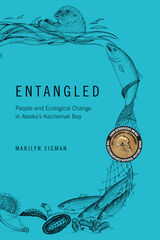 Entangled: People and Ecological Change in Alaska's Kachemak Bay
Marilyn Sigman
University of Alaska Press, 2018 Chronicling her quest for wildness and home in Alaska, naturalist Marilyn Sigman writes lyrically about the history of natural abundance and human notions of wealth—from seals to shellfish to sea otters to herring, halibut, and salmon—in Alaska’s iconic Kachemak Bay.
Kachemak Bay is a place where people and the living resources they depend on have ebbed and flowed for thousands of years. The forces of the earth are dynamic here: they can change in an instant, shaking the ground beneath your feet or overturning kayaks in a rushing wave. Glaciers have advanced and receded over centuries. The climate, like the ocean, has shifted from warmer to colder and back again in a matter of decades. The ocean food web has been shuffled from bottom to top again and again.
In Entangled, Sigman contemplates the patterns of people staying and leaving, of settlement and displacement, nesting her own journey to Kachemak Bay within diasporas of her Jewish ancestors and of ancient peoples from Asia to the southern coast of Alaska. Along the way she weaves in scientific facts about the region as well as the stories told by Alaska’s indigenous peoples. It is a rhapsodic introduction to this stunning region and a siren call to protect the land’s natural resources in the face of a warming, changing world.
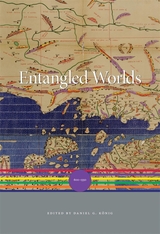 Entangled Worlds: 600–1350
Daniel G. König
Harvard University Press, 2025 Leading historians and archaeologists offer a comprehensive introduction to the increasingly entangled worlds that spanned the globe between 600 and 1350 CE.
The period between the seventh and fourteenth centuries is hardly thought of as an era of globalization. Entire societies in the Americas, Australia, and Oceania developed in relative isolation from other parts of the world. Even on the interconnected landmass of Eurafrasia, many people had little to do with processes of transregional exchange.
Yet the period 600–1350 CE in fact witnessed an explosion of connectivity amid the consolidation of sophisticated approaches to human organization. Flows of people, goods, and ideas across regional boundaries intensified, changing lives at all social levels, from rulers to the enslaved. In the Americas, large cities and north-south trade networks took shape. The Arabic-Islamic conquests of the seventh and eighth centuries, along with the Mongol expansion of the thirteenth, tied together diverse polities from southeast Asia to sub-Saharan Africa. Regions also became more culturally and politically integrated: Latin-Christian models of social organization spread across Europe; the Sinitic written language drew eastern Eurasia into a common elite culture; and the accumulation of significant agricultural surpluses in the Indian subcontinent supported the emergence of a settled political order.
Entangled Worlds sees the completion of the magisterial six-volume set A History of the World, offering an authoritative introduction to a vibrant era of global history. The distinguished contributors make clear that there never was a stagnant “Middle Ages” wedged between Antiquity and Modernity but instead a period defined by decisive strides toward global connection, urbanization, and the cultural and political formations we live with today.
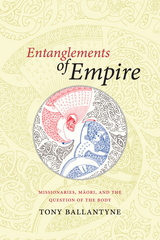 Entanglements of Empire: Missionaries, Maori, and the Question of the Body
Tony Ballantyne
Duke University Press, 2015 The first Protestant mission was established in New Zealand in 1814, initiating complex political, cultural, and economic entanglements with Māori. Tony Ballantyne shows how interest in missionary Christianity among influential Māori chiefs had far-reaching consequences for both groups. Deftly reconstructing cross-cultural translations and struggles over such concepts and practices as civilization, work, time and space, and gender, he identifies the physical body as the most contentious site of cultural engagement, with Māori and missionaries struggling over hygiene, tattooing, clothing, and sexual morality. Entanglements of Empire is particularly concerned with how, as a result of their encounters in the classroom, chapel, kitchen, and farmyard, Māori and the English mutually influenced each other’s worldviews. Concluding in 1840 with New Zealand’s formal colonization, this book offers an important contribution to debates over religion and empire.
 Entanglements of Two: A Series of Duets
Edited by Karen Christopher and Mary Paterson
Intellect Books, 2021 An investigation of the complex relationship of form and practice through the lens of the smallest multiple units of collaboration: the pair.
Drawing out the particularities of collaborative work, Entanglements of Two: A Series of Duets considers the duo as a microcosm of humankind. Focusing on a ten-year period in the work of collaborative performance maker Karen Christopher, the book explores the practical, philosophical, and aesthetic implications of working in pairs and offers wider reflections on the duet as a concept in artistic and social life. The twenty-five pieces in the collection—from an international group of collaborators, artists, and performance scholars, alongside writing from related disciplines, including linguistics, physics, poetry, and theology—offer critical reflections on artistic collaboration and entanglement and contemplate their significance on an interpersonal and global level. A foreword by writer and artist Season Butler rounds out this essential volume.
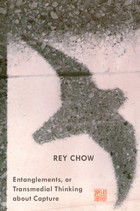 Entanglements, or Transmedial Thinking about Capture
Rey Chow
Duke University Press, 2012 How might the pornographic be associated with Brecht's and Benjamin's media theories? How are Foucault's and Deleuze's writings on visibilities "postcolonial"? What happens when Rancière's discussions of art are juxtaposed with cultural anthropology? What does a story by Lao She about collecting reveal about political collectivism in modern China? How does Girard's notion of mimetic violence speak to identity politics? How might Arendt's and Derrida's reflections on forgiveness be supplemented by a film by Lee Chang-dong? What can Akira Kurosawa's films about Japan say about American Studies? How is Asia framed transnationally, with what consequences for those who self-identify as Asian? These questions are dispersively heterologous yet mutually implicated. This paradoxical character of their discursive relations is what Rey Chow intends with the word "entanglements," by which she means, first, an enmeshment of topics: the mediatized image in modernist reflexivity; captivation and identification; victimhood; the place of East Asia in globalized Western academic study. Beyond enmeshment, she asks, can entanglements be phenomena that are not defined by affinity or proximity? Might entanglements be about partition and disparity rather than about conjunction and similarity?
Across medial forms (including theater, film, narrative, digitization, and photographic art), and against more popular trends of declaring things and people to be in flux, Chow proposes conceptual frames that foreground instead aesthetic, ontological, and sentient experiences of force, dominance, submission, fidelity, antagonism, masochism, letting-go, and the attraction to self-annihilation. Boundary, trap, capture, captivation, sacrifice, and mimesis: these riveting terms serve as analytic pressure points in her readings, articulating perversity, madness, and terror to pursuits of freedom.
 The Entangling Net: Alaska's Commercial Fishing Women Tell Their Lives
Leslie Leyland Fields
University of Illinois Press, 1997 "Truly remarkable portraits
of courage." -- John van Amerongen, editor, Alaska Fisherman's
Journal
"These little-known tales
of women working in Alaska's commercial fishing industry make for great
reading. . . . Readers will be amazed by their stories." -- Laine
Welch, Alaska Fish Radio
"A richly textured story,
a multi-genre text that invites readers to witness women's conversation
with America's last frontier, Alaska." -- Patricia Foster, University
of Iowa
Why do women choose an occupation
that has been ranked the most dangerous in the nation? What do women give
up--and get in return--when they take on the tasks of fishermen? The
Entangling Net explores these issues through the stories of twenty
women who have chosen to work in this extremely risky, male-dominated
profession.
Leslie Leyland Fields lyrically
weaves their stories with her own experiences as a fishing woman. She
tells of long, exhausting days in skiffs, catching fish in brutally cold
weather on waters that are often violent. Her words and those of the women
she interviews convey the paradoxical relationship the women have with
commercial fishing: they face extraordinarily difficult working conditions
made more difficult and dangerous by male crews and skippers who don't
welcome women, yet they feel impelled by the challenge of the work to
return to their jobs season after season.
Enter Dark Stranger: Poems
William Trowbridge
University of Arkansas Press, 1989 The world of William Trowbridge is one preoccupied with loss, with the fall from some possibility of grace that all who are born must bear. In the title poem of Trowbridge’s first full-length collection the poet calls our attention to movies, to Shane in particular. He asks us to identify, not with Shane, the lonely knight on a nameless quest, but with the much more lonely, and real, Jack Palance, the Prince of Darkness. Trowbridge favors the villain, the outcast, the imperfect, the sinner, the alienated: King Kong, the Frog Prince, Frankenstein’s monster.
 Enter Rabelais, Laughing
Barbara C. Bowen
Vanderbilt University Press, 1998 Francois Rabelais is a difficult and often misunderstood author, whose reputation for coarse "Rabelaisian" jesting and "Gargantuan" indulgence in food, drink, and sex is highly misleading. He was in fact a committed humanist who expressed strong views on religion, good government, education, and much more through the mock-heroic adventures of his giants. While most books about Rabelais have relatively little to say about his comedic genius, Enter Rabelais, Laughing analyzes the many sides of Rabelais's humor, focusing on why his writing was so hilariously funny to sixteenth-century readers. The author begins by discussing how the Renaissance defined laughter and situates Rabelais in a long tradition of literary laughter. Subsequent chapters examine specific contexts relevant to Gargantua and Pantagruel, beginning with the comic aspects of epic, chronicle, mock-epic, and farce, and proceeding to Renaissance and Reformation humanist satire, rhetoric, medicine, and law. All of these chapters combine information, much of it new, on the humanist message Rabelais wanted to convey to his readers, with an analysis of how he used his wit to reinforce his message. Rarely is a writer's work treated in such illuminating detail. On a broad level, Enter Rabelais, Laughing serves as an excellent introduction to French Renaissance literature and exhibits a remarkably charming and lucid writing style, free of jargon. To Rabelais scholars in particular it offers a thorough and innovative analysis that corrects misconceptions and questions commonly held views.
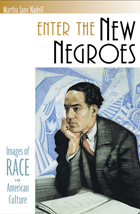 Enter the New Negroes: Images of Race in American Culture
Martha Jane Nadell
Harvard University Press, 2004 With the appearance of the urban, modern, diverse "New Negro" in the Harlem Renaissance, writers and critics began a vibrant debate on the nature of African-American identity, community, and history. Martha Jane Nadell offers an illuminating new perspective on the period and the decades immediately following it in a fascinating exploration of the neglected role played by visual images of race in that debate.
After tracing the literary and visual images of nineteenth-century "Old Negro" stereotypes, Nadell focuses on works from the 1920s through the 1940s that showcased important visual elements. Alain Locke and Wallace Thurman published magazines and anthologies that embraced modernist images. Zora Neale Hurston's Mules and Men, with illustrations by Mexican caricaturist Miguel Covarrubias, meditated on the nature of black Southern folk culture. In the "folk history" Twelve Million Black Voices, Richard Wright matched prose to Farm Security Administration photographs. And in the 1948 Langston Hughes poetry collection One Way Ticket, Jacob Lawrence produced a series of drawings engaging with Hughes's themes of lynching, race relations, and black culture. These collaborations addressed questions at the heart of the movement and in the era that followed it: Who exactly were the New Negroes? How could they attack past stereotypes? How should images convey their sense of newness, possibility, and individuality? In what directions should African-American arts and letters move?
Featuring many compelling contemporary illustrations, Enter the New Negroes restores a critical visual aspect to African-American culture as it evokes the passion of a community determined to shape its own identity and image.
Enter These Gates: Meditations for the Days of Awe
Alden Solovy
Central Conference of American Rabbis, 2024 Enter These Gates is a High Holy Day companion for our times, with more than one hundred new poems, prayers, and meditations for Rosh HaShanah and Yom Kippur. Poet-liturgist Alden Solovy draws from his unique spirit to blend today's struggles and joys with classic themes, layering a contemporary voice into beloved motifs. Enter These Gates is a vital resource for individual prayer, study, and communal worship. Themes include confession, repentance, forgiveness, and memory, as well as frailty, seeing holiness, and what Solovy calls "the ancient journey." A companion to the machzor, Enter These Gates offers a fresh yet deeply rooted approach to heightening our experience of the Days of Awe. FINALIST: NEXT GENERATION INDIE BOOK AWARDS (Spirituality category)
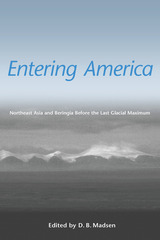 Entering America: Northeast Asia and Beringia Before the Last Glacial Maximum
David B. Madsen
University of Utah Press, 2004 Where did the first Americans come from and when did they get here? That basic question of American archaeology, long thought to have been solved, is re-emerging as a critical issue as the number of well-excavated sites dating to pre-Clovis times increases. It now seems possible that small populations of human foragers entered the Americas prior to the creation of the continental glacial barrier. While the archaeological and paleoecological aspects of a post-glacial entry have been well studied, there is little work available on the possibility of a pre-glacial entry.
Entering America seeks to fill that void by providing the most up-to-date information on the nature of environmental and cultural conditions in northeast Asia and Beringia (the Bering land bridge) immediately prior to the Last Glacial Maximum. Because the peopling of the New World is a question of international archaeological interest, this volume will be important to specialists and nonspecialists alike.
 Entering China’s Service: Robert Hart’s Journals, 1854–1863
Katherine Bruner
Harvard University Press, 1986 Robert Hart was one of those empire builders of the Victorian age who had a long and nearly uninterrupted experience in China, from 1854, when as a young Irishman from Belfast he landed in Ningpo, until 1908, when as a man in his seventies he finally retired to England. His years as the Ch’ing government’s Inspector General of the Maritime Customs Service have been copiously recorded in letters to his London agent, beginning in 1868, published as a 2-volume collection, The I. G. in Peking (Harvard, Belknap Press, 1975).
In 1970, a second lode of Hart materials came to light, the 77 volumes of his journals, begun on the day of his arrival in China in 1854 and ending at his departure in 1908, with two short but significant gaps in the first decade where he himself destroyed entries of too personal a nature.
Entering China’s Service presents a complete and annotated transcript of the surviving journals through 1863, alternating with chapters devoted to Hart’s North Ireland background, the China he encountered, the Ch’ing officials who trusted him, and the unfolding of his career. His reactions to the Chinese as well as to his fellow Westerners cast an invaluable light on nineteenth-century China.
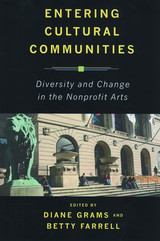 Entering Cultural Communities: Diversity and Change in the Nonprofit Arts
Grams, Diane
Rutgers University Press, 2008 Arts organizations once sought patrons primarily from among the wealthy and well educated, but for many decades now they have revised their goals as they seek to broaden their audiences. Today, museums, orchestras, dance companies, theaters, and community cultural centers try to involve a variety of people in the arts. They strive to attract a more racially and ethnically diverse group of people, those from a broader range of economic backgrounds, new immigrants, families, and youth.
The chapters in this book draw on interviews with leaders, staff, volunteers, and audience members from eighty-five nonprofit cultural organizations to explore how they are trying to increase participation and the extent to which they have been successful. The insiders' accounts point to the opportunities and challenges involved in such efforts, from the reinvention of programs and creation of new activities, to the addition of new departments and staff dynamics, to partnerships with new groups. The authors differentiate between "relational" and "transactional" practices, the former term describing efforts to build connections with local communities and the latter describing efforts to create new consumer markets for cultural products. In both cases, arts leaders report that, although positive results are difficult to measure conclusively, long-term efforts bring better outcomes than short-term activities.
The organizations discussed include large, medium, and small nonprofits located in urban, suburban, and rural areas—from large institutions such as the Smithsonian, the Walker Art Center, the Museum of Fine Arts Houston, and the San Francisco Symphony to many cultural organizations that are smaller, but often known nationally for their innovative work, such as AS220, The Loft Literary Center, Armory Center for the Arts, Appalshop, and the Western Folklife Center.
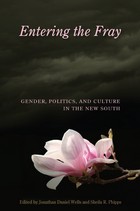 Entering the Fray: Gender, Politics, and Culture in the New South
Edited by Jonathan Daniel Wells & Sheila R. Phipps
University of Missouri Press, 2009 The study of the New South has in recent decades been greatly enriched by research into gender, reshaping our understanding of the struggle for woman suffrage, the conflicted nature of race and class in the South, the complex story of politics, and the role of family and motherhood in black and white society. This book brings together nine essays that examine the importance of gender, race, and culture in the New South, offering a rich and varied analysis of the multifaceted role of gender in the lives of black and white southerners in the troubled decades of the late nineteenth and early twentieth centuries. Ranging widely from conservative activism by white women in 1920s Georgia to political involvement by black women in 1950s Memphis, many of these essays focus on southern women’s increasing public activities and high-profile images in the twentieth century. They tell how women shouldered responsibilities for local, national, and international interests; but just as nineteenth-century women’s status could be at risk from too much public presence, women of the New South stepped gingerly into the public arena, taking care to work within what they considered their current gender limitations. The authors—both established and up-and-coming scholars—take on subjects that reflect wide-ranging, sophisticated, and diverse scholarship on black and white women in the New South. They include the efforts of female Home Demonstration Agents to defeat debilitating diseases in rural Florida and the increasing participation of women in historic preservation at Monticello. They also reflect unique personal stories as diverse as lobbyist Kathryn Dunaway’s efforts to defeat the Equal Rights Amendment in Georgia and Susan Smith’s depiction by the national media as a racist southerner during coverage of her children’s deaths. Taken together, these nine essays contribute to the picture of women increasing their movement into political and economic life while all too often still maintaining their gendered place as determined by society. Their rich insights provide new ways to consider the meaning and role of gender in the post–Civil War South.
Entering the Watershed: A New Approach To Save America's River Ecosystems
Bob Doppelt, Mary Scurlock, Chris Frissell, and James Karr
Island Press, 1993 Entering the Watershed is the product of a two-year project established by the Pacific Rivers Council to develop new federal riverine protection and restoration policy alternatives. It recommends a comprehensive new approach to river protection based on principles of watershed dynamics, ecosystem function, and conservation biology -- a nationwide, strategic community- and ecosystem-based watershed restoration initiative. The book: - describes in detail the existing level of damage to rivers and species
- analyzes flaws and gaps in existing policy
- provides the framework necessary to develop new policies
- outlines the scientific underpinnings and management strategies needed in new policy
- makes specific policy proposals
Entering Transmasculinity: The Inevitability of Discourse
matthew heinz
Intellect Books, 2016 Entering Transmasculinity is a holistic study of the intersecting and overlapping discourses that shape transgender identities. In the book, matthew heinz offers an examination of mediated and experienced transmasculine subjectivities and aims to capture the apparent contradictions that structure transmasculine experience, perception, and identification. From the relationship between transmasculinity’s emancipatory potential and its simultaneously homogenizing implications, to issues of gender-queerness, sexual minorities, normativity, and fatherhood, Entering Transmasculinity the first book to synthesize the disparate areas of academic study into a theory of the transmasculine self and its formation.
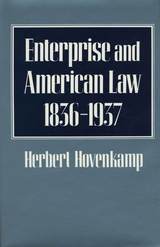 Enterprise and American Law, 1836–1937
Herbert Hovenkamp
Harvard University Press, 1991 In this integration of law and economic ideas, Herbert Hovenkamp charts the evolution of the legal framework that regulated American business enterprise from the time of Andrew Jackson through the first New Deal. He reveals the interdependent relationship between economic theory and law that existed in these decades of headlong growth and examines how this relationship shaped both the modern business corporation and substantive due process. Classical economic theory—the cluster of ideas about free markets—became the guiding model for the structure and function of both private and public law.
Hovenkamp explores the relationship of classical economic ideas to law in six broad areas related to enterprise in the nineteenth and early twentieth centuries. He traces the development of the early business corporation and maps the rise of regulated industry from the first charter-based utilities to the railroads. He argues that free market political economy provided the intellectual background for constitutional theory and helped define the limits of state and federal regulation of business behavior. The book also illustrates the unique American perspective on political economy reflected in the famous doctrine of substantive due process. Finally, Hovenkamp demonstrates the influence of economic theory on labor law and gives us a reexamination of the antitrust movement, the most explicit intersection of law and economics before the New Deal.
Legal, economic, and intellectual historians and political scientists will welcome these trenchant insights on an influential period in American constitutional and corporate history.
Enterprise Exit Processes in Transition Economies: Downsizing, Workouts, and Liquidation
Leszek Balcerowicz
Central European University Press, 1998 The rebirth of competition and the extensive "exit" that has resulted are among the most important developments in Central Europe since the demise of Communism. This text examines why, how, and to what extent enterprises have reduced their size or left the market altogether during the first years of the transition from socialism to capitalism in the Czech Republic, Hungary and Poland.
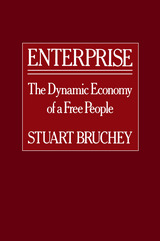 Enterprise: The Dynamic Economy of a Free People
Stuart Bruchey
Harvard University Press, 1990 Not since Charles and Mary Beard's The Rise of American Civilization has a narrative been written for the general reader and student alike that so superbly explicates the origins of American capitalism. Arguing that the central fact explaining the success of the American experiment is the development of the economy, the distinguished economic historian Stuart Bruchey shows the reciprocal relationship between economic growth and values, law, and social and political change, as well as between economic development and the more traditional variables of capital, labor, and resources.
Enterprising, risk-taking men and women in all walks of life are at the center of the remarkable story that is the American dream and reality. The farm family moving to an unfamiliar environment and trying new technology; the business executive or worker with a new idea for improving a machine; the jurist venturing down a different legal path to sharpen incentives to invest; lawmakers of all kinds risking tenure or office by giving priority to measures designed to entice capital and labor to their jurisdictions—these entrepreneurs provided the leaven that gradually raised the living standards of the average person to heights unknown anywhere in the past.
Twenty years in the writing, Enterprise summarizes the scholarly contributions of historians and social scientists. It reaches deep into the European past—to fourteenth-century Italy—to retrace the origins of American capitalism. The author tells the story of individual achievement and vertical social mobility and their triumph over obstacles, a never-ending theme of American enterprise. Whether Americans maintain those heights today or will suffer a decline as the price of 1980s “now-nowism”—as Richard Darman characterizes this decade of wanting everything, at once, and paying nothing—remains to be seen.
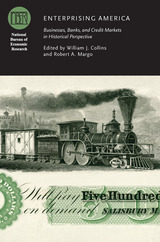 Enterprising America: Businesses, Banks, and Credit Markets in Historical Perspective
Edited by William J. Collins and Robert A. Margo
University of Chicago Press, 2015 The rise of America from a colonial outpost to one of the world’s most sophisticated and productive economies was facilitated by the establishment of a variety of economic enterprises pursued within the framework of laws and institutions that set the rules for their organization and operation.
To better understand the historical processes central to American economic development, Enterprising America brings together contributors who address the economic behavior of American firms and financial institutions—and the associated legal institutions that shaped their behavior—throughout the nineteenth and early twentieth centuries. Collectively, the contributions provide an account of the ways in which businesses, banks, and credit markets promoted America’s extraordinary economic growth. Among the topics that emerge are the rise of incorporation and its connection to factory production in manufacturing, the organization and operation of large cotton plantations in comparison with factories, the regulation and governance of banks, the transportation revolution’s influence on bank stability and survival, and the emergence of long-distance credit in the context of an economy that was growing rapidly and becoming increasingly integrated across space.
 Enterprising Elite: The Boston Associates and the World They Made
Robert F. Dalzell Jr.
Harvard University Press, 1987 More than any other single group of individuals, the Boston Associates were responsible for the sweeping economic transformation that occurred in New England between 1815 and 1861. Through the use of the corporate form, they established an extensive network of modern business enterprises that were among the largest of the time. Their most notable achievement was the development of the Waltham-Lowell system in the textile industry, but they were also active in transportation, banking, and insurance, and at the same time played a major role in philanthropy and politics.
Evaluating each of these efforts in turn and placing the Associates in the context of the society and culture that produced them, the author convincingly explains the complex motives that led the group to undertake initiatives on so many different fronts. Dalzell shows that men like Francis Cabot Lowell, Nathan Appleton, and Amos and Abbott Lawrence are best understood as transitional figures. Although they used modern methods when it suited their interest, they were most concerned with protecting the positions they had already won at the top of a traditional social order. Thus, for all the innovations they sponsored, their commitment to change remained both partial and highly selective. And while something very like an industrial revolution did occur in New England during the nineteenth century, paradoxically the Associates neither sought nor welcomed it. On the contrary, as time passed they became increasingly preoccupied with combating the forces of change.
In addition to the light it sheds on a crucial chapter of business history, this gracefully written study offers fresh insights into the role and attitudes of elites during the period. Furthermore it contradicts some of the prevailing thought about entrepreneurial behavior in the early phases of industrialization in America.
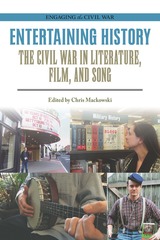 Entertaining History: The Civil War in Literature, Film, and Song
Edited by Chris Mackowski
Southern Illinois University Press, 2020 Popular media can spark the national consciousness in a way that captures people’s attention, interests them in history, and inspires them to visit battlefields, museums, and historic sites. This lively collection of essays and feature stories celebrates the novels, popular histories, magazines, movies, television shows, photography, and songs that have enticed Americans to learn more about our most dramatic historical era.
From Ulysses S. Grant’s Memoirs to Abraham Lincoln: Vampire Hunter, from Roots to Ken Burns’s The Civil War, from “Dixie” to “Ashokan Farewell,” and from Civil War photography to the Gettysburg Cyclorama, trendy and well-loved depictions of the Civil War are the subjects of twenty contributors who tell how they and the general public have been influenced by them. Sarah Kay Bierle examines the eternal appeal of Gone with the Wind and asks how it is that a protagonist who so opposed the war has become such a figurehead for it. H. R. Gordon talks with New York Times–bestselling novelist Jeff Shaara to discuss the power of storytelling. Paul Ashdown explores ColdMountain’s value as a portrait of the war as national upheaval, and Kevin Pawlak traces a shift in cinema’s depiction of slavery epitomized by 12 Years a Slave. Tony Horwitz revisits his iconic Confederates in the Attic twenty years later.
The contributors’ fresh analysis articulates a shared passion for history’s representation in the popular media. The variety of voices and topics in this collection coalesces into a fascinating discussion of some of the most popular texts in the genres. In keeping with the innovative nature of this series, web-exclusive material extends the conversation beyond the book.
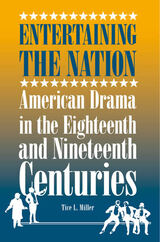 Entertaining the Nation: American Drama in the Eighteenth and Nineteenth Centuries
Tice L. Miller
Southern Illinois University Press, 2007 In this survey of eighteenth- and nineteenth-century American drama, Tice L. Miller examines American plays written before a canon was established in American dramatic literature and provides analyses central to the culture that produced them. Entertaining the Nation: American Drama in the Eighteenth and Nineteenth Centuries evaluates plays in the early years of the republic, reveals shifts in taste from the classical to the contemporary in the 1840s and 1850s, and considers the increasing influence of realism at the end of the nineteenth century. Miller explores the relationship between American drama and societal issues during this period. While never completely shedding its English roots, says Miller, the American drama addressed issues important on this side of the Atlantic such as egalitarianism, republicanism, immigration, slavery, the West, Wall Street, and the Civil War. In considering the theme of egalitarianism, the volume notes Alexis de Tocqueville’s observation in 1831 that equality was more important to Americans than liberty. Also addressed is the Yankee character, which became a staple in American comedy for much of the nineteenth century. Miller analyzes several English plays and notes how David Garrick’s reforms in London were carried over to the colonies. Garrick faced an increasingly middle-class public, offers Miller, and had to make adjustments to plays and to his repertory to draw an audience. The volumealso looks at the shift in drama that paralleled the one in political power from the aristocrats who founded the nation to Jacksonian democrats. Miller traces how the proliferation of newspapers developed a demand for plays that reflected contemporary society and details how playwrights scrambled to put those symbols of the outside world on stage to appeal to the public. Steamships and trains, slavery and adaptations of Uncle Tom’s Cabin, and French influences are presented as popular subjects during that time. Entertaining the Nation effectively outlines the civilizing force of drama in the establishment and development of the nation, ameliorating differences among the various theatergoing classes, and provides a microcosm of the changes on and off the stage in America during these two centuries.
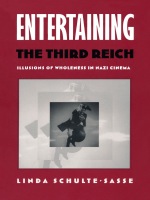 Entertaining the Third Reich: Illusions of Wholeness in Nazi Cinema
Linda Schulte-Sasse
Duke University Press, 1996 In this persuasive reversal of previous scholarship, Linda Schulte-Sasse takes an unorthodox look at Nazi cinema, examining Nazi films as movies that contain propaganda rather than as propaganda vehicles that happen to be movies. Like other Nazi artistic productions, Nazi film has long been regarded as kitsch rather than art, and therefore unworthy of critical textual analysis. By reading these films as consumer entertainment, Schulte-Sasse reveals the similarities between Nazi commercial film and classical Hollywood cinema and, with this shift in emphasis, demonstrates how Hollywood-style movie formulas frequently compromised Nazi messages.
Drawing on theoretical work, particularly that of Lacan and Zizek, Schulte-Sasse shows how films such as Jew Süsss and The Great King construct fantasies of social harmony, often through distorted versions of familiar stories from eighteenth-century German literature, history, and philosophy. Schulte-Sasse observes, for example, that Nazi films, with their valorization of bourgeois culture and use of familiar narrative models, display a curious affinity with the world of Enlightenment culture that the politics of National Socialism would seem to contradict.
Schulte-Sasse argues that film served National Socialism less because of its ideological homogeneity than because of the appeal and familiarity of its underlying literary paradigms and because the medium itself guarantees a pleasurable illusion of wholeness. Entertaining the Third Reich will be of interest to a wide range of scholars, including those engaged in the study of cinema, popular culture, Nazism and Nazi art, the workings of fascist culture, and the history of modern ideology.
Enthusiasm: A Chapter in the History of Religion
Ronald A. Knox
University of Notre Dame Press, 1994 Enthusiasm, first published in 1950 by Ronald A. Knox, is the end product of thirty years of research and inspiration. In his perceptive and learned study Knox presents the personalities and religious philosophies of the various types of enthusiasts of the seventeenth and eighteenth centuries: the monatists; donatists; anabaptists; Quakers; Jansenism; quietism; methodism; and other movements.
Enthusiasm And Divine Madness
Josef Pieper
St. Augustine's Press, 1999 Plato's famous dialogue, the Phaedrus, was variously subtitled in antiquity: "On Beauty," "On Love," "On the Psyche." It is also concerned with the art of rhetoric, of thought and communication.
Pieper gives interpretation of the dialogue. Leaving the more recondite scholarly preoccupations aside, he concentrates on the content, bringing the actual situation in the dialogue – Athens and its intellectuals engaged in spirited debate – alive. Equally alive is the discussion of ideas, which are brought to bear on contemporary experience and made to prove the perennial validity of Socratic wisdom, and its power to excite the mind. The main thesis – that in poetry and in love man is "beside himself," that is, divinely inspired - is discussed with reference to modern poets, novelists, and modern psychology.
 Enticement Of Religion
Kees Bolle
University of Notre Dame Press, 2002 In The Enticement of Religion, Kees W. Bolle has written an accessible and informative introduction to the basic facts of religion and to the ways scholars and other people have dealt with religion over the centuries. Bolle's central purpose is to provide a serious, in-depth study that will introduce students and other general readers to religion and religious events in the world.
Part 1 of the book focuses on the facts of religion, and covers such topics as the object and task of the historian of religions, the correct usage of words like "faith" and "tradition," modes of religious expression, and the social and political impact of religion. Bolle raises basic, yet not often discussed, questions such as "What is Religion?" and "What are the Religions of the World?" The second part of the book provides a historical survey of Western intellectual approaches to religion. Starting with the Greeks and progressing all the way to the twentieth century, Bolle explores how writers and scholars such as David Hume, Friedrich Schleiermacher, Soren Kierkegaard, Ludwig Wittgenstein, Joseph Conrad, Charles Péguy, and many others have influenced our judgments on religion.
Written in clear, jargon-free prose, The Enticement of Religion will appeal to anyone interested in understanding what religion is and why it is important to know something about it.
KEES W. BOLLE is professor emeritus of history at UCLA. He is the author of numerous books and articles as well as founder and general editor of the publication Hermeneutics: Studies in the History of Religion.
"The Enticement of Religion is the product of Kees Bolle's lifelong quest for understanding of religion. As a sustained essay on hermeneutics (he prefers ‘epistemology'), it is, indeed, an enticing alternative to the post-modernist studies in critical discourse so pervasive in today's intellectual world-a refreshingly innovative approach free of subservience to current fashion." -William W. Malandra, University of Minnesota
"This book will serve well undergraduate majors in religious studies, students commencing graduate study in the field, and anyone interested in religion and religions who wishes to be introduced to the major issues, problems, and thinkers emergent in the context of western intellectual history. Bolle's probings are worthy of the careful attention of all who are open to being seriously engaged in the data of religions." -F. Stanley Lusby, University of Tennessee, Knoxville
----------
"Aptly titled, this is a scintillating and intellectually satisfying survey of centuries of serious religious study focusing less on the specifics of different traditions than on the question why we worship. Drawing on the varied disciplines of philosophy, theology, anthropology, and history and the expertise of past masters of the history of religion--Ibn Khaldun, Max Müller, G. van der Leeuw, Raffaele Pettazzoni, Mircea Eliade, and countless others--Bolle is eager to provide a hermeneutics for the 21st century, offering an updated explanation and understanding of what religion is and why we should know about it. Bolle covers both Eastern and Western traditions, and because his first rule is that ‘you should listen to the people whose religion you try to comprehend,' readers cannot help but to have their view of religions deepened and broadened. Extensive bibliographies at the end of each chapter will fuel interest and authoritatively guide librarians seeking to build their own collections. Recommended for all academic libraries and large public libraries." --Library Journal
"Writing with a minimum amount of technical jargon, Bolle provides an accessible study of the data and questions about religion found in every human civilization. This book will interest all who are concerned about the place of religious life and thought in the modern world. Recommended. All Levels." --Choice
"The Enticement of Religion is the product of Kees Bolle's lifelong quest for understanding of religion. As a sustained essay on hermeneutics (he prefers ‘epistemology'), it is, indeed, an enticing alternative to the post-modernist studies in critical discourse so pervasive in today's intellectual world-a refreshingly innovative approach free of subservience to current fashion." -William W. Malandra, University of Minnesota
"This book will serve well undergraduate majors in religious studies, students commencing graduate study in the field, and anyone interested in religion and religions who wishes to be introduced to the major issues, problems, and thinkers emergent in the context of western intellectual history. Bolle's probings are worthy of the careful attention of all who are open to being seriously engaged in the data of religions." -F. Stanley Lusby, University of Tennessee, Knoxville
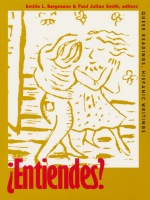 ¿Entiendes?: Queer Readings, Hispanic Writings
Emilie L. Bergmann and Paul Julian Smith, eds.
Duke University Press, 1995 "¿Entiendes?" is literally translated as "Do you understand? Do you get it?" But those who do "get it" will also hear within this question a subtler meaning: "Are you queer? Are you one of us?" The issues of gay and lesbian identity represented by this question are explored for the first time in the context of Spanish and Hispanic literature in this groundbreaking anthology.
Combining intimate knowledge of Spanish-speaking cultures with contemporary queer theory, these essays address texts that share both a common language and a concern with lesbian, gay, and bisexual identities. Using a variety of approaches, the contributors tease the homoerotic messages out of a wide range of works, from chronicles of colonization in the Caribbean to recent Puerto Rican writing, from the work of Cervantes to that of the most outrageous contemporary Latina performance artists. This volume offers a methodology for examining work by authors and artists whose sexuality is not so much open as "an open secret," respecting, for example, the biographical privacy of writers like Gabriela Mistral while responding to the voices that speak in their writing. Contributing to an archeology of queer discourses, ¿Entiendes? also includes important studies of terminology and encoded homosexuality in Argentine literature and Caribbean journalism of the late nineteenth century.
Whether considering homosexual panic in the stories of Borges, performances by Latino AIDS activists in Los Angeles, queer lives in turn-of-the-century Havana and Buenos Aires, or the mapping of homosexual geographies of 1930s New York in Lorca’s "Ode to Walt Whitman," ¿Entiendes? is certain to stir interest at the crossroads of sexual and national identities while proving to be an invaluable resource.
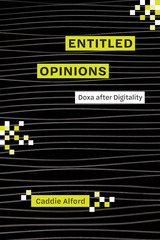 Entitled Opinions: Doxa after Digitality
Caddie Alford
University of Alabama Press, 2024 A landmark rhetorical theory of the formation and functioning of opinions in social media contexts Entitled Opinions: Doxa After Digitality offers a rhetorical theory of opinions, especially as opinions operate within social media. Many urgent contemporary issues—from demagoguery to white ethno-nationalism—compel us to consider opinions seriously. Yet while clichés like “he tells it like it is” and newer imperatives such as #BlackLivesMatter seem straightforward, haptics, emoji, and “like” buttons belie unexamined collective assumptions about how opinions in the digital realm function. Caddie Alford illuminates this function by deploying the ancient Greek term for opinions: doxa. Doxa translates to “opinion,” but the term can also signal seemingness and expectations. Doxa’s capacious meanings reveal opinions to be more than static or monolithic: With doxa, opinions become emergent, dynamic, relational, and pluralistic. Masterfully combining rhetorical frameworks as well as scholarship on opinions and digital media entanglements, Alford puts opinions into conversation with such case studies as algorithms, infrastructure, digital illiteracy, virality, and activism. She shows how “doxa” reveals gradations of opinions, from more reputable to less reputable. She demonstrates that these gradations are multifaceted and susceptible to interventions. Entitled Opinions sheds much of the baggage associated with opinions while opening up more fertile pathways of inquiry. In a world that says, “don’t read the comments,” this book reads the comments, taking seriously content that could be easily dismissed otherwise and alchemizing judgments into implications.
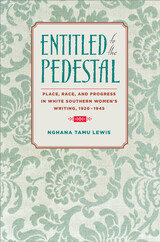 Entitled to the Pedestal: Place, Race, and Progress in White Southern Women’s Writing, 1920–1945
Nghana tamu Lewis
University of Iowa Press, 2007 In this searching study, Nghana Lewis offers a close reading of the works and private correspondences, essays, and lectures of five southern white women writers: Julia Peterkin, Gwen Bristow, Caroline Gordon, Willa Cather, and Lillian Smith. At the core of this work is a sophisticated reexamination of the myth of southern white womanhood. Lewis overturns the conventional argument that white women were passive and pedestal-bound. Instead, she argues that these figures were complicit in the day-to-day dynamics of power and authorship and stood to gain much from these arrangements at the expense of others. At the same time that her examination of southern mythology explodes received wisdom, it is also a journey of self-discovery. As Lewis writes in her preface, “As a proud daughter of the South, I have always been acutely aware of the region’s rich cultural heritage, folks, and foodstuffs. How could I not be? I was born and reared in Lafayette, Louisiana, where an infant’s first words are not ‘da-da’ and ‘ma-ma’ but ‘crawfish boil’ and ‘fais-do-do.’ . . . I have also always been keenly familiar with its volatile history.” Where these conflicting images—and specifically the role of white southern women as catalysts, vindicators, abettors, and antagonists—meet forms the crux of this study. As such, this study of the South by a daughter of the South offers a distinctive perspective that illuminates the texts in novel and provocative ways.
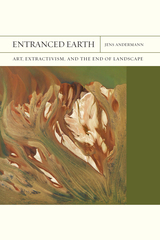 Entranced Earth: Art, Extractivism, and the End of Landscape
Jens Andermann
Northwestern University Press, 2023 A sweeping analysis of the lasting effects of neocolonial extractivism in Latin American aesthetic modernity from 1920 to the present
Looking to the extractive frontier as a focal point of Latin American art, literature, music, and film, Jens Andermann asks what emerges at the other end of landscape. Art in the Global South has long represented and interrogated “insurgent nature”—organic and inorganic matter, human and nonhuman life, thrown into turmoil.
In Entranced Earth: Art, Extractivism, and the End of Landscape, Andermann traces the impact of despaisamiento—world-destroying un-landscaping—throughout the Latin American modernist archive. At the same time, he explores innovative, resilient modes of allyship forged between diverse actors through their shared experiences of destruction. From the literary regionalism of the 1930s to contemporary bio art, from modernist garden architecture to representations of migration and displacement in sound art and film, Entranced Earth tracks the crisis of landscape and environmental exhaustion beyond despair toward speculative, experimental forms of survival.
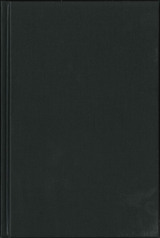 Entre Guadalupe y Malinche: Tejanas in Literature and Art
Edited by Inés Hernández-Ávila and Norma Elia Cantú
University of Texas Press, 2016 Mexican and Mexican American women have written about Texas and their lives in the state since colonial times. Edited by fellow Tejanas Inés Hernández-Ávila and Norma Elia Cantú, Entre Guadalupe y Malinche gathers, for the first time, a representative body of work about the lives and experiences of women who identify as Tejanas in both the literary and visual arts. The writings of more than fifty authors and the artwork of eight artists manifest the nuanced complexity of what it means to be Tejana and how this identity offers alternative perspectives to contemporary notions of Chicana identity, community, and culture. Considering Texas-Mexican women and their identity formations, subjectivities, and location on the longest border between Mexico and any of the southwestern states acknowledges the profound influence that land and history have on a people and a community, and how Tejana creative traditions have been shaped by historical, geographical, cultural, linguistic, social, and political forces. This representation of Tejana arts and letters brings together the work of rising stars along with well-known figures such as writers Gloria Anzaldúa, Emma Pérez, Alicia Gaspar de Alba, Carmen Tafolla, and Pat Mora, and artists such as Carmen Lomas Garza, Kathy Vargas, Santa Barraza, and more. The collection attests to the rooted presence of the original indigenous peoples of the land now known as Tejas, as well as a strong Chicana/Mexicana feminism that has its precursors in Tejana history itself.
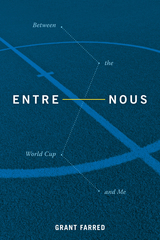 Entre Nous: Between the World Cup and Me
Grant Farred
Duke University Press, 2019 In Entre Nous Grant Farred examines the careers of international football stars Lionel Messi and Luis Suarez, along with his own experience playing for an amateur township team in apartheid South Africa, to theorize the relationship between sports and the intertwined experiences of relation, separation, and belonging. Drawing on Jean-Luc Nancy's concept of relation and Heideggerian ontology, Farred outlines how various relationships—the significantly different relationships Messi has with his club team FC Barcelona and the Argentine national team; Farred's shifting modes of relation as he moved between his South African team and his Princeton graduate student team; and Suarez's deep bond with Uruguay's national team coach Oscar Tabarez—demonstrate the ways the politics of relation both exist within and transcend sports. Farred demonstrates that approaching sports philosophically offers particularly insightful means of understanding the nature of being in the world, thereby opening new paths for exploring how the self is constituted in its relation to the other.
 Entrepreneurial Arts and Cultural Leadership: Traits of Success in Nonprofit Theatre
Bonnie Fogel and Brett Ashley Crawford
Intellect Books, 2025 A tactical guide for nonprofit arts leaders, revealing the entrepreneurial traits that turn creative passion into sustainable success.
Entrepreneurial Arts and Cultural Leadership focuses on real-world strategies for developing the entrepreneurial mindset necessary for leading and sustaining nonprofit arts organizations. Bonnie Fogel and Brett Ashley Crawford examine the leadership traits that drive innovation, adaptability, and long-term viability in the ever-evolving arts sector.
Through the case study of Imagination Stage, they highlight how successful nonprofit theater leaders can navigate financial instability, advocate for equity and inclusion, and implement sustainable business models in a landscape forever impacted by national and global events. With practical insights, tools, and a resource-rich appendix, this book offers arts managers, educators, and nonprofit leaders a roadmap for resilience and growth. Whether you are an advanced student, a researcher, or an arts executive seeking inspiration, this book provides an essential framework for building the future of nonprofit theatre.
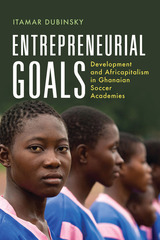 Entrepreneurial Goals: Development and Africapitalism in Ghanaian Soccer Academies
Itamar Dubinsky
University of Wisconsin Press, 2022 The idea that the African private sector will generate economic prosperity and social wealth—an objective many governments and foreign charitable organizations have failed to achieve—continues to attract attention in business and policy circles. Yet little research has actually been conducted on Africapitalist endeavors. With the immense popularity of sports and the many aspirations they foster, the successes and shortcomings of soccer academies have kicked their way into the spotlight. Entrepreneurial Goals breaks away from studies that focus on the international relations consequences of soccer ventures, which are often rebuked as extended forms of European colonialism and exploitation of local talent, and instead centers Ghanaian establishments and the opportunities they create for local development within their surrounding communities.
Itamar Dubinsky’s extensive ethnographic research offers an innovative theoretical approach by assessing three institutions—Mandela Soccer Academy, Kumasi Sports Academy, and Unistar Soccer Academy—through an Africapitalist prism. He demonstrates that these business endeavors, when viewed from the perspective of local interests, realize many of the educational, financial, and community building ambitions of the region. This pioneering examination of locally owned academies in Ghana reflects Dubinsky’s aim of illuminating the entrepreneurs and programs whose success passes to participating youth and their families, while also exposing the contradictions of for-profit development initiatives that purport to reap collective social benefits.
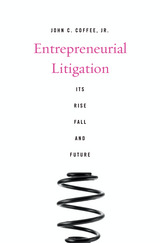 Entrepreneurial Litigation: Its Rise, Fall, and Future
John C. Coffee, Jr.
Harvard University Press, 2015 Uniquely in the United States, lawyers litigate large cases on behalf of many claimants who could not afford to sue individually. In these class actions, attorneys act typically as risk-taking entrepreneurs, effectively hiring the client rather than acting as the client’s agent. Lawyer-financed, lawyer-controlled, and lawyer-settled, such entrepreneurial litigation invites lawyers to sometimes act more in their own interest than in the interest of their clients. And because class litigation aggregates many claims, defendants object that its massive scale amounts to legalized extortion. Yet, without such devices as the class action and contingent fees, many meritorious claims would never be asserted.
John Coffee examines the dilemmas surrounding entrepreneurial litigation in a variety of specific contexts, including derivative actions, securities class actions, merger litigation, and mass tort litigation. His concise history traces how practices developed since the early days of the Republic, exploded at the end of the twentieth century, and then waned as Supreme Court decisions and legislation sharply curtailed the reach of entrepreneurial litigation. In an evenhanded account, Coffee assesses both the strengths and weaknesses of entrepreneurial litigation and proposes a number of reforms to achieve a fairer balance. His goal is to save the class action, not discard it, and to make private enforcement of law more democratically accountable. Taking a global perspective, he also considers the feasibility of exporting a modified form of entrepreneurial litigation to other countries that are today seeking a mechanism for aggregate representation.
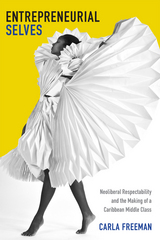 Entrepreneurial Selves: Neoliberal Respectability and the Making of a Caribbean Middle Class
Carla Freeman
Duke University Press, 2014 Entrepreneurial Selves is an ethnography of neoliberalism. Bridging political economy and affect studies, Carla Freeman turns a spotlight on the entrepreneur, a figure saluted across the globe as the very embodiment of neoliberalism. Steeped in more than a decade of ethnography on the emergent entrepreneurial middle class of Barbados, she finds dramatic reworkings of selfhood, intimacy, labor, and life amid the rumbling effects of political-economic restructuring. She shows us that the déjà vu of neoliberalism, the global hailing of entrepreneurial flexibility and its concomitant project of self-making, can only be grasped through the thickness of cultural specificity where its costs and pleasures are unevenly felt. Freeman theorizes postcolonial neoliberalism by reimagining the Caribbean cultural model of 'reputation-respectability.' This remarkable book will allow readers to see how the material social practices formerly associated with resistance to capitalism (reputation) are being mobilized in ways that sustain neoliberal precepts and, in so doing, re-map class, race, and gender through a new emotional economy.
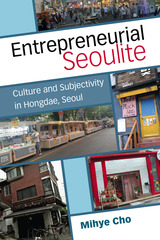 Entrepreneurial Seoulite: Culture and Subjectivity in Hongdae, Seoul
Mihye Cho
University of Michigan Press, 2019 Entrepreneurial Seoulite might be read as a memoir on Hongdae based on the author’s observations as a member of South Korea’s Generation X. During the 1990’s, Hongdae became widely known as a cool place associated with discourses on alternative music, independent labels, and club culture. Today, Hongdae is well known for its youth culture and nightlife, as well as its gentrification.
Recent research on Korean culture approaches the K-wave phenomenon from the perspectives of cultural consumption, media analysis, and cultural management and policy. Meanwhile, studies on Seoul have centered on its transformation as a global, creative city. Rather than examining the K-wave or the city itself, this book explores the experience of living through the city-in-transition, focusing on the relationship between “the ideology that justified engagement in capitalism” and the “subjectification process.” The book aims to understand the project to institutionalize a cultural district in Hongdae as a demonstration of the coevolution of ideologies and citizenship in a society undergoing rapid liberalization—politically, culturally, and economically.
A cultural turn took place in Korea during the 1990s, amid the economic prosperity driven by state-led industrialization and the collapse of the military dictatorship due to democratization movements. Cultural critiques, emerging as an alternative to social movements, proliferated to assert the freedom and autonomy of individuals against regulatory systems and institutions. The nation was hit by the Asian financial crisis in 1997, and witnessed massive economic restructuring including layoffs, stakeouts, and a prevalence of contingent employment. As a result, the entire nation had to find new engines of economic growth while experiencing a creative destruction. At the center of this national transformation, Seoul has sought to recreate itself from a mega city to a global city, equipped with cutting-edge knowledge industries and infrastructures.
By juxtaposing the cultural turn and cultural/creative city-making, Entrepreneurial Seoulite interrogates the formation of new citizen subjectivity, namely the enterprising self, in post-Fordist Seoul. What kinds of logic guide individuals in the engagement of new urban realities in rapidly liberalized Seoul—culturally and economically? In order to explore this query, Mihye Cho draws on Weber’s concept of “the spirit of capitalism” on the formation of a new economic agency focusing on the re-configuration of meanings, and seeks to capture a transformative moment detailing when and how capitalism requests a different spirit and lifestyle of its participants. Likewise, this book approaches the enterprising self as the new spirit of post-Fordist Seoul and explores the ways in which people in Seoul internalize and negotiate this new enterprising self.
 An Entrepreneur’s Manifesto
Steve Mariotti
Templeton Press, 2015 In an increasingly competitive world market, how does the United States rank? Many Americans are worried about the economic state of their nation, especially now that countries like China are becoming ever more economically powerful. What does America need to both stabilize and energize its economy? Entrepreneurship, Steve Mariotti claims, is vital. An Entrepreneur’s Manifesto is Mariotti’s rallying cry for the world to recognize the potential that business creation holds for the individual and the economy. Mariotti explores how entrepreneurship affects schools and prisons, developed cities and isolated villages, brick-and-mortar stores, and internet-based businesses. He takes a hard look at the research on entrepreneurial education, entrepreneurship, government policy, and the social and cultural attributes most likely to foster successful business creation, incorporating his discussions with some of the best minds on the question of entrepreneurship. Mariotti also examines how the rise of the Internet and Web-based innovations like crowdfunding have both changed—and not changed—the fundamentals of promoting those who take the ultimate gamble of going into business for themselves. As the author of several leading textbooks on the subject and founder of the Network for Teaching Entrepreneurship (NFTE), a global nonprofit organization that has educated more than 500,000 students and trained more than 5,000 teachers in 50 countries, Mariotti is both an experienced and reliable leader in what he calls the entrepreneurial revolution. Mariotti frequently writes for the Huffington Post and has been recruited by the State Department to discuss his ideas on youth entrepreneurship in Cambodia and other developing countries seeking to escape the shackles of centrally planned economic policies. Neither a dry recitation of academic theory nor a scattered collection of feel-good stories, An Entrepreneur’s Manifesto builds on Mariotti’s unique perspective to offer a critique that is both inspiring and practical. Riveting stories complement enlightening real-world perspectives, making the work relatable and inspiring. “There is no more revolutionary act,” Mariotti says, “than starting a business.”
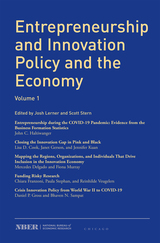 Entrepreneurship and Innovation Policy and the Economy: Volume 1
Edited by Josh Lerner and Scott Stern
University of Chicago Press Journals, 2022 Entrepreneurship and innovation are widely recognized as key drivers of long-term economic growth. Understanding the forces that influence them is essential for policy design. Building on the twenty-year legacy of the NBER Innovation Policy and the Economy series, Entrepreneurship and Innovation Policy and the Economy showcases recent research on entrepreneurship and entrepreneurship policy. The volume reports on five research projects. First, leveraging detailed data from the Business Formation Statistics, John Haltiwanger documents a striking uptick in new business formation during the pandemic, and considers the future economic impact of this renewed rate of business dynamism. The next two chapters focus on disparities in the degree of inclusion of women and people of color in innovation and entrepreneurship. Lisa Cook, Janet Gerson, and Jennifer Kuan examine the history of unequal access to education, training, and the practice and commercialization of invention, and the subsequent loss in innovative capacity and productivity. They also consider the potential effects of policies that address these inequalities. Mercedes Delgado and Fiona Murray complement this analysis by characterizing and analyzing the gender gap in patented innovation, including the substantial variation in inclusion of women across locations, industries, and individual firms. The remaining chapters focus on the organization of research and commercialization. Chiara Franzoni, Paula Stephan, and Reinhilde Veugelers consider the operation of current research funding systems with regard to risky research projects. They also describe the consequences of documented biases against novelty in funding decisions in the context of research on mRNA technology. Drawing on historical lessons from World War II as well as current analysis of innovation policy during COVID-19, Daniel Gross and Bhaven Sampat consider the unique challenges that arise when a crisis necessitates unusually rapid innovation and the deployment, at scale, of research findings.
 Entropy Economics: The Living Basis of Value and Production
James K. Galbraith and Jing Chen
University of Chicago Press, 2025 Economists dream of equilibrium. It’s time to wake up. In mainstream economics, markets are ideal if competition is perfect. When supply balances demand, economic maturity is orderly and disturbed only by shocks. These ideas are rooted in doctrines going back thousands of years, yet, as James K. Galbraith and Jing Chen show, they contradict the foundations of our scientific understanding of the physical and biological worlds. Entropy Economics discards the conventions of equilibrium and presents a new basis for thinking about economic issues, one rooted in life processes—an unequal world of unceasing change in which boundaries, plans, and regulations are essential. Galbraith and Chen’s theory of value is based on scarcity, and it accounts for the power of monopoly. Their theory of production covers increasing and decreasing returns, uncertainty, fixed investments over time, and the impact of rising resource costs. Together, their models illuminate key problems such as trade, finance, energy, climate, conflict, and demography. Entropy Economics is a thrilling framework for understanding the world as it is and will be keenly relevant to the economic challenges of a world threatened with disorder.
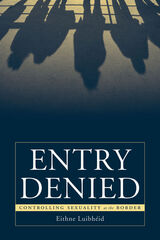 Entry Denied: Controlling Sexuality At The Border
Eithne Luibheid
University of Minnesota Press, 2002 A revelatory examination of 150 years of sexuality-based discrimination against immigrants to the United States. Lesbians, prostitutes, women likely to have sex across racial lines, "brought to the United States for immoral purposes," or "arriving in a state of pregnancy"—national threats, one and all. Since the late nineteenth century, immigrant women’s sexuality has been viewed as a threat to national security, to be contained through strict border-monitoring practices. By scrutinizing this policy, its origins, and its application, Eithne Luibhéid shows how the U.S. border became a site not just for controlling female sexuality but also for contesting, constructing, and renegotiating sexual identity. Initially targeting Chinese women, immigration control based on sexuality rapidly expanded to encompass every woman who sought entry to the United States. The particular cases Luibhéid examines-efforts to differentiate Chinese prostitutes from wives, the 1920s exclusion of Japanese wives to reduce the Japanese-American birthrate, the deportation of a Mexican woman on charges of lesbianism, the role of rape in mediating women’s border crossings today—challenge conventional accounts that attribute exclusion solely to prejudice or lack of information. This innovative work clearly links sexuality-based immigration exclusion to a dominant nationalism premised on sexual, gender, racial, and class hierarchies.
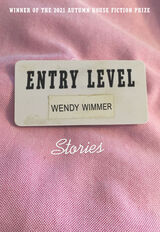 Entry Level
Wendy Wimmer
Autumn House Press, 2022 Tales of characters trying to find their way through the struggles of underemployment.
Wendy Wimmer’s debut short story collection, Entry Level, contains a range of characters who are trying to find, assert, or salvage their identities. These fifteen stories center around the experience of being underemployed—whether by circumstance, class, gender, race, or other prevailing factors—and the toll this takes on an individual. Wimmer pushes the boundaries of reality, creating stories that are funny, fantastic, and at times terrifying. Her characters undergo feats of endurance, heartbreak, and loneliness, all while trying to succeed in a world that so often undervalues them. From a young marine biologist suffering from imposter syndrome and a haunting to a bingo caller facing another brutal snowstorm and a creature that may or not be an angel, Wimmer’s characters are all confronting an oppressive universe that seemingly operates against them or is, at best, indifferent to them. These stories reflect on the difficulties of modern-day survival and remind us that piecing together a life demands both hope and resilience.
Entry Level was selected by Deesha Philyaw as the winner of the 2021 Autumn House Fiction Prize.
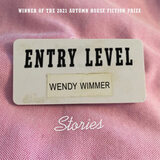 Entry Level
Wendy Wimmer
Autumn House Press, 2023 Tales of characters trying to find their way through the struggles of underemployment.
Wendy Wimmer’s debut short story collection, Entry Level, contains a range of characters who are trying to find, assert, or salvage their identities. These fifteen stories center around the experience of being underemployed—whether by circumstance, class, gender, race, or other prevailing factors—and the toll this takes on an individual. Wimmer pushes the boundaries of reality, creating stories that are funny, fantastic, and at times terrifying. Her characters undergo feats of endurance, heartbreak, and loneliness, all while trying to succeed in a world that so often undervalues them. From a young marine biologist suffering from imposter syndrome and a haunting to a bingo caller facing another brutal snowstorm and a creature that may or not be an angel, Wimmer’s characters are all confronting an oppressive universe that seemingly operates against them or is, at best, indifferent to them. These stories reflect on the difficulties of modern-day survival and remind us that piecing together a life demands both hope and resilience.
Entry Level was selected by Deesha Philyaw as the winner of the 2021 Autumn House Fiction Prize.
 Entry Points: The Vera List Center Field Guide on Art and Social Justice No. 1
Carin Kuoni and Chelsea Haines, editors
Duke University Press, 2016 Providing a lively snapshot of the state of art and social justice today on a global level, Entry Points accompanies the inaugural Vera List Center Prize for Art and Politics, launched at The New School on the occasion of the center’s twentieth anniversary. This book captures some of the most significant worldwide examples of art and social justice and introduces an interested audience of artists, policy makers, scholars, and writers to new ways of thinking about how justice is defined, advanced, and practiced through the arts. In so doing, it assembles some of the latest scholarship in this field while refining our vocabulary for speaking about social justice, social engagement, community enhancement, empowerment, and even art itself. The book's first half contains three essays by Thomas Keenan, João Ribas, and Sharon Sliwinski that map the field of art and social justice. These essays are accompanied by more than twenty profiles of recent artist projects that consist of brief essays and artist pages. This curated and carefully considered map of artists and projects identifies key moments in art and social justice. The book's second half consists of an in-depth analysis of Theaster Gates's The Dorchester Projects, which won the inaugural Vera List Prize for Art and Politics. Produced to complement the project’s exhibition at the Sheila C. Johnson Design Center, Parsons School of Design in September 2013, this analysis illuminates Gates's rich, complex, and exemplary work. This section includes an interview between Gates and Vera List Center director Carin Kuoni; essays by Horace D. Ballard Jr., Romi N. Crawford, Shannon Jackson, and Mabel O. Wilson; and a number of responses to The Dorchester Projects by faculty in departments across The New School. Published by Duke University Press and the Vera List Center for Art and Politics at The New School
Entwined: Three Lyric Sequences
Carol Frost
Tupelo Press, 2014 Carol Frost’s poems have a classical grace and elegance, but there is molten emotion beneath their fluid surfaces. The poetic sequences in Entwined give a reader three perspectives on human awareness: as a lexicon of abstractions (Time, Beauty, Adultery, Scorn, and so on) and what the poet calls “moral dreaming”; as a voyage from the soul’s dark night into a new experience of light among the bays and shoals of Florida’s fecund gulf coast; and as a meditation on memory and mortality, through an encounter with a mind in decline — a parent succumbing to dementia. Written over twenty-five years in three series, Carol Frost’s twelfth book of poems is formally elegant but fierce in feeling, boldly exploring lineation, an elastic syntax, and inventive punctuation to reach an extraordinary sensory intensity.
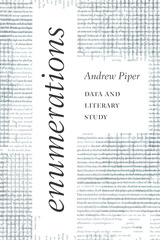 Enumerations: Data and Literary Study
Andrew Piper
University of Chicago Press, 2018 For well over a century, academic disciplines have studied human behavior using quantitative information. Until recently, however, the humanities have remained largely immune to the use of data—or vigorously resisted it. Thanks to new developments in computer science and natural language processing, literary scholars have embraced the quantitative study of literary works and have helped make Digital Humanities a rapidly growing field. But these developments raise a fundamental, and as yet unanswered question: what is the meaning of literary quantity?
In Enumerations, Andrew Piper answers that question across a variety of domains fundamental to the study of literature. He focuses on the elementary particles of literature, from the role of punctuation in poetry, the matter of plot in novels, the study of topoi, and the behavior of characters, to the nature of fictional language and the shape of a poet’s career. How does quantity affect our understanding of these categories? What happens when we look at 3,388,230 punctuation marks, 1.4 billion words, or 650,000 fictional characters? Does this change how we think about poetry, the novel, fictionality, character, the commonplace, or the writer’s career? In the course of answering such questions, Piper introduces readers to the analytical building blocks of computational text analysis and brings them to bear on fundamental concerns of literary scholarship. This book will be essential reading for anyone interested in Digital Humanities and the future of literary study.
 Enveloping Worlds: Toward a Discourse of Immersive Performance
E.B. Hunter and Scott Magelssen, Editors
University of Michigan Press, 2025 Enveloping Worlds is a collection of essays that analyzes the phenomenon of immersive, participatory performance as it has developed in the US. As this collection demonstrates, immersive performance offers three-dimensional multisensory experiences, inviting audience members to be participants in the unfolding of the story, and challenging pre-existing ideas about the function of performance and entertainment. Enveloping Worlds questions audience agency and choice, the space and boundaries of performance, modes of immersion, empathy and engagement, and ethical considerations through fifteen essays.
Case studies in the volume include the Choctaw Cultural Center in Oklahoma and Choctaw sovereignty; a Black artist’s autoethnographic performance challenging White audiences’ entitlement to full inclusion; Immersive Van Gogh experiences and their scenographers; telephone performance during the COVID-19 lockdowns; Diane Paulus’s The Donkey Show; the Battle of Atlanta panorama; an antebellum-themed department store display from the 1920s; escape rooms at Disney Parks; remotely staged plays about aging and dementia; tiki bars; anachronistic costuming at Renaissance Festivals; the technologies that shape the boundaries of immersive worlds; and tabletop role-playing games. Taken together, these essays contribute a rich discussion of immersive performance across radically different contexts, offering analytical models and terminology with which to clarify and advance this emergent discourse.
 Environment and Development in a Resource-Rich Economy: Malaysia under the New Economic Policy
Jeffrey R. Vincent and Rozali M. Ali
Harvard University Press, 1997 Malaysia interests development practitioners for many reasons, not least because of its remarkably rich natural environment. Environment and Development in a Resource-Rich Economy provides an invaluable analysis of major natural resource and environmental policy issues in the country during the 1970s and 1980s--a period of profound socioeconomic changes, rapid depletion of natural resources, and the emergence of serious air and water pollution problems.
What is path-breaking about this book is its emphasis on economics as a source of concepts and methods for analyzing natural resource and environmental issues and policy responses. The authors' access to unpublished data and key decision makers makes this account of extensive, field-based research an essential reference for policy makers and researchers concerned about environmental and natural resource management--both in Malaysia and throughout the globe. The book should be of particular interest for students who hope to understand more thoroughly the economic underpinnings of natural resource and environmental management policy.
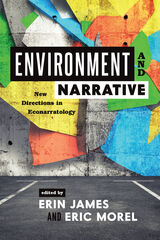 Environment and Narrative: New Directions in Econarratology
Edited by Erin James and Eric Morel
Ohio State University Press, 2020 Never before has a collection of original essays strived to create such constructive, shared discourse between ecocritical, narrative scholars and environmental humanities scholars interested in narrative. Erin James and Eric Morel’s volume Environment and Narrative: New Directions in Econarratology explores the complexity of pairing material environments and their representations with narrative forms of understanding.
To explore the methodological possibilities within “econarratology,” the contributors evaluate the mechanics of how narratives convey environmental understanding via building blocks such as the organization of time and space, characterization, focalization, description, and narration. They also query how readers emotionally and cognitively engage with such representations and how the process of encountering different environments in narratives stands to affect real-world attitudes and behaviors. By positioning narratives as important repositories of values, political and ethical ideas, and behaviors that determine how we engage with our ecological homes, the authors in this volume suggest that to change the way that we interact with the environment requires not only new stories but also a better understanding of the ones that have long been in circulation.
Environment and Post-Soviet Transformation in Kazakhstan’s Aral Sea Region: Sea Changes
William Wheeler
University College London, 2021 Presents a political ecology of life amid overlapping environmental and political upheaval.
Once the fourth largest lake in the world, Kazakhstan’s Aral Sea dried into an unrecognizable fraction of its size during a period of dramatic political change. Through the experiences of local fisheries across the rise and fall of the Soviet Union, Environment and Post-Soviet Transformation in Kazakhstan’s Aral Sea Region explores the diverse ways people in different socioeconomic contexts understand environmental change. In this book, William Wheeler offers a rigorous political ecology of life amid overlapping upheavals, attentive both to the legacies of Sovietism and the possibilities of transnationalism.
 Environment and Society in the Japanese Islands: From Prehistory to the Present
Bruce L. Batten
Oregon State University Press, 2015 Over the long course of Japan’s history, its people profited from their rich natural environment while simultaneously facing significant environmental challenges. Over time, they have altered their natural environment in numerous ways, from landscape modification to industrial pollution. How has the human-nature relationship changed over time in Japan? How does Japan’s environmental history compare with that of other countries, or that of the world as a whole?
Environment and Society in the Japanese Islands attempts to answer these questions through a series of case studies by leading Japanese and Western historians, geographers, archaeologists, and climatologists. These essays, on diverse topics from all periods of Japanese history and prehistory, are unified by their focus on the key concepts of “resilience” and “risk mitigation.” Taken as a whole, they place Japan’s experience in global context and call into question the commonly presumed division between pre-modern and modern environmental history.
Primarily intended for scholars and students in fields related to Japan or environmental history, these accessibly-written essays will be valuable to anyone wishing to learn about the historical roots of today’s environmental issues or the complex relationship between human society and the natural environment.
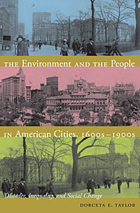 The Environment and the People in American Cities, 1600s-1900s: Disorder, Inequality, and Social Change
Dorceta E. Taylor
Duke University Press, 2009 In The Environment and the People in American Cities, Dorceta E. Taylor provides an in-depth examination of the development of urban environments, and urban environmentalism, in the United States. Taylor focuses on the evolution of the city, the emergence of elite reformers, the framing of environmental problems, and the perceptions of and responses to breakdowns in social order, from the seventeenth century through the twentieth. She demonstrates how social inequalities repeatedly informed the adjudication of questions related to health, safety, and land access and use. While many accounts of environmental history begin and end with wildlife and wilderness, Taylor shows that the city offers important clues to understanding the evolution of American environmental activism. Taylor traces the progression of several major thrusts in urban environmental activism, including the alleviation of poverty; sanitary reform and public health; safe, affordable, and adequate housing; parks, playgrounds, and open space; occupational health and safety; consumer protection (food and product safety); and land use and urban planning. At the same time, she presents a historical analysis of the ways race, class, and gender shaped experiences and perceptions of the environment as well as environmental activism and the construction of environmental discourses. Throughout her analysis, Taylor illuminates connections between the social and environmental conflicts of the past and those of the present. She describes the displacement of people of color for the production of natural open space for the white and wealthy, the close proximity between garbage and communities of color in early America, the cozy relationship between middle-class environmentalists and the business community, and the continuous resistance against environmental inequalities on the part of ordinary residents from marginal communities.
The Environment and the Press: From Adventure Writing to Advocacy
Mark Neuzil
Northwestern University Press, 2008 This history of environmental journalism looks at how the practice now defines issues and sets the public agenda evolving from a tradition that includes the works of authors such as Pliny the Elder, John Muir, and Rachel Carson. It makes the case that the relationship between the media and its audience is an ongoing conversation between society and the media on what matters and what should matter.
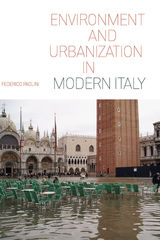 Environment and Urbanization in Modern Italy
Federico Paolini
University of Pittsburgh Press, 2020 From the second half of the 1940s, when postwar reconstruction began in Italy, there were three notable driving forces of environmental change: the uncontrollable process of urban drift, fueled by considerable migratory flows from the countryside and southern regions toward the cities where large-scale productive activities were beginning to amass; unruly industrial development, which was tolerated since it was seen as the necessary tribute to be paid to progress and modernization; and mass consumption. In his fourth book, Federico Paolini presents a series of essays ranging from the uses of natural resources, to environmental problems caused by means of transport, to issues concerning environmental politics and the dynamics of the environment movement. Paolini concludes the book with a forecast about the environmental problems that will emerge in the public debate of the twenty-first century.
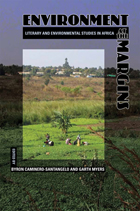 Environment at the Margins: Literary and Environmental Studies in Africa
Byron Caminero-Santangelo
Ohio University Press, 2011 Environment at the Margins brings literary and environmental studies into a robust interdisciplinary dialogue, challenging dominant ideas about nature, conservation, and development in Africa and exploring alternative narratives offered by writers and environmental thinkers. The essays bring together scholarship in geography, anthropology, and environmental history with the study of African and colonial literatures and with literary modes of analysis. Contributors analyze writings by colonial administrators and literary authors, as well as by such prominent African activists and writers as Ngugi wa Thiong’o, Mia Couto, Nadine Gordimer, Wangari Maathai, J. M. Coetzee, Zakes Mda, and Ben Okri. These postcolonial ecocritical readings focus on dialogue not only among disciplines but also among different visions of African environments. In the process, Environment at the Margins posits the possibility of an ecocriticism that will challenge and move beyond marginalizing, limiting visions of an imaginary Africa. Contributors:
Jane Carruthers
Mara Goldman
Amanda Hammar
Jonathan Highfield
David McDermott Hughes
Roderick P. Neumann
Rob Nixon
Anthony Vital
Laura Wright
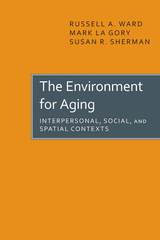 The Environment for Aging: Interpersonal, Social, and Spatial Contexts
Russell A. Ward
University of Alabama Press, 1988 The nature and consequences of aging depend on its environmental context, and the literature does not treat the various environmental dimensions in an integrated fashion. The authors introduce a general approach to the human ecosystem, highlighting theoretical and empirical issues necessary to an understanding of person-environment interaction related to aging. They then investigate in detail three aspects of the environment of older persons: residential and neighborhood, interpersonal support networks, and age-related attitudes. They give specific attention to the impact of the age composition of neighborhoods and interpersonal networks. The authors present findings from their interview survey of 1,185 community residents aged 60 and over. Major findings from the interviews include: - Despite objective neighborhood problems, older persons express high neighborhood satisfaction. This partly reflects limited residential options, as well as a passive and vicarious spatial experience. The environment is experienced in diverse ways; however, urbanism and personal competence shape the nature and outcomes of person-environment interaction.
- Older persons have relatively robust interpersonal support networks. Perceived sufficiency of contact and support are more salient to morale than are more objective measures of interpersonal support.
- Although attitudes toward other older people are generally favorable, patterns of age identity reflect a detrimental view of aging. There is little evidence that socialization for aging or age-group solidarity make aging “easier” in this regard.
- Older persons exhibit moderate age homogeneity within their interpersonal networks, partly reflecting neighborhood age concentration. Contrary to the apparent benefits of planned age-segregated housing, age homogeneity in neighborhoods and networks does not contribute to well-being.
The authors examine three major themes in their concluding chapter; age itself does not “loom large” in the lives of these community residents, though age becomes salient under certain conditions; there is diversity in the implications of the environmental context for aging, in particular reflecting an “environmental docility” hypothesis; and aging must be viewed in interactional or transactional terms—older people “construct” the environment as a subjective entity.
Environment for Growth: Environmental Management for Sustainability and Competitiveness in Central America
Edited by Theodore Panayotou
Harvard University Press, 2001 The Central American region is a vital ecological resource that provides environmental balance for the rest of the American continents. Using comprehensive surveys and statistical studies, this volume presents an evaluation of the region's deforestation, sustainable agriculture, tourism, emerging carbon markets, trade, and growth.
By comparing and contrasting policies applied by other countries with similar environmental characteristics, the contributors argue that Central American governments must learn from the results of these policies in order to manage resources, foster sustainability and competitiveness, and procure positive results.
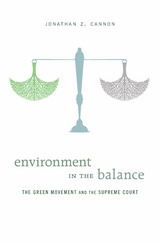 Environment in the Balance: The Green Movement and the Supreme Court
Jonathan Z. Cannon
Harvard University Press, 2015 The first Earth Day in 1970 marked environmentalism’s coming-of-age in the United States. More than four decades later, does the green movement remain a transformative force in American life? Presenting a new account from a legal perspective, Environment in the Balance interprets a wide range of U.S. Supreme Court decisions, along with social science research and the literature of the movement, to gauge the practical and cultural impact of environmentalism and its future prospects.
Jonathan Z. Cannon demonstrates that from the 1960s onward, the Court’s rulings on such legal issues as federalism, landowners’ rights, standing, and the scope of regulatory authority have reflected deep-seated cultural differences brought out by the mass movement to protect the environment. In the early years, environmentalists won some important victories, such as the Supreme Court’s 1973 decision allowing them to sue against barriers to recycling. But over time the Court has become more skeptical of their claims and more solicitous of values embodied in private property rights, technological mastery and economic growth, and limited government.
Today, facing the looming threat of global warming, environmentalists struggle to break through a cultural stalemate that threatens their goals. Cannon describes the current ferment in the movement, and chronicles efforts to broaden its cultural appeal while staying connected to its historical roots, and to ideas of nature that have been the source of its distinctive energy and purpose.
 Environment in the Global Arena: Actors, Values, Policies, and Futures
Kenneth A. Dahlberg, Marvin S. Soroos, Anne Thompson Feraru, James E. Harf, and B. Thomas Trout
Duke University Press, 1985 Volumes in the Global Issues series address the problems of energy and environment as matters of international concern, and a forthcoming volume provides an overview of all these areas. The issues in the series are each considered within a systematic framework common to all. Each volume begins with a historical background and then the issues are placed in their contemporary context. Four distinct perspectives are presented: (1) Who are the "global actors" involved in the issue, and what are the linkages among them? (2) What prevailing values are operating, and how have the relevant actors responded to those values? (3) What policies are applied by these actors at the global level, and how are these policies determined? (4) What are the possible results of the values and policies of these global actors?
 The Environment, International Relations, and U.S. Foreign Policy
Paul G. Harris, Editor
Georgetown University Press As the world's largest polluter and its wealthiest country, the United States has a potentially enormous impact on international efforts to protect the environment. In this innovative and thought-provoking book, an international group of scholars examines how U.S. foreign policy affects and is affected by global environmental change. Covering three broad areas—national security and geopolitics, domestic and international politics, and national interests and international obligations—the contributors examine a host of key issues, including ozone depletion and climate change, biodiversity and whale hunting, environmental and energy security, and international trade. They also raise moral issues associated with the United States's obligations to the rest of humanity. Because the environment has become an ever-more pressing issue at the diplomatic level, this book is essential, timely reading for policymakers, activists, and anyone interested in environmental change and international relations.
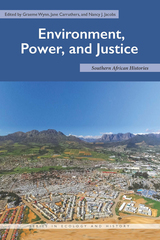 Environment, Power, and Justice: Southern African Histories
Graeme Wynn
Ohio University Press, 2022 Spanning the colonial, postcolonial, and postapartheid eras, these historical and locally specific case studies analyze and engage vernacular, activist, and scholarly efforts to mitigate social-environmental inequity. This book highlights the ways poor and vulnerable people in South Africa, Lesotho, and Zimbabwe have mobilized against the structural and political forces that deny them a healthy and sustainable environment. Spanning the colonial, postcolonial, and postapartheid eras, these studies engage vernacular, activist, and scholarly efforts to mitigate social-environmental inequity. Some chapters track the genealogies of contemporary activism, while others introduce positions, actors, and thinkers not previously identified with environmental justice. Addressing health, economic opportunity, agricultural policy, and food security, the chapters in this book explore a range of issues and ways of thinking about harm to people and their ecologies. Because environmental justice is often understood as a contemporary phenomenon framed around North American examples, these fresh case studies will enrich both southern African history and global environmental studies. Environment, Power, and Justice expands conceptions of environmental justice and reveals discourses and dynamics that advance both scholarship and social change. Contributors: - Christopher Conz
- Marc Epprecht
- Mary Galvin
- Sarah Ives
- Admire Mseba
- Muchaparara Musemwa
- Matthew A. Schnurr
- Cherryl Walker
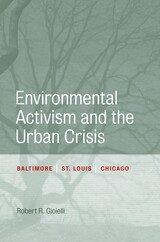 Environmental Activism and the Urban Crisis: Baltimore, St. Louis, Chicago
Robert Gioielli
Temple University Press, 2015 Environmental Activism and the Urban Crisis focuses on the wave of environmental activism and grassroots movements that swept through America's older, industrial cities during the late 1960s and early 1970s. Robert Gioielli offers incisive case studies of Baltimore, St. Louis, and Chicago to show how urban activism developed as an impassioned response to a host of racial, social, and political conflicts. As deindustrialization, urban renewal, and suburbanization caused the decline of the urban environment, residents--primarily African Americans and working-class whites--organized to protect their families and communities from health threats and environmental destruction. Gioielli examines various groups' activism in response to specific environmental problems caused by the urban crisis in each city. In doing so, he forms concrete connections between environmentalism, the African American freedom struggle, and various urban social movements such as highway protests in Baltimore and air pollution activism in Chicago. Eventually, the efforts of these activists paved the way for the emergence of a new movement-environmental justice.
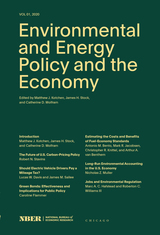 Environmental and Energy Policy and the Economy: Volume 1
Edited by Matthew J. Kotchen, James H. Stock, and Catherine D. Wolfram
University of Chicago Press Journals, 2020 This volume presents six new papers on environmental/energy economics and policy. Robert Stavins evaluates carbon taxes versus a cap-and-trade mechanism for reducing greenhouse-gas emissions, arguing that specific design features of either instrument can be more consequential than the choice of instrument itself. Lucas Davis and James Sallee show that the exemption of electric vehicles from the gasoline tax is likely to be efficient as long as gasoline prices remain below social marginal costs, even though it results in lower tax revenue. Caroline Flammer analyzes the rapidly growing market for green bonds and highlights the importance of third-party certification to the financial and environmental performance of publically traded companies. Antonio Bento, Mark Jacobsen, Christopher Knittel, and Arthur van Benthem develop a general framework for evaluating the costs and benefits of fuel economy standards and use it to account for the differences between several recent studies of changes in these standards. Nicholas Muller estimates a measure of output in the U.S. economy over the last 60 years that accounts for air pollution damages, and shows that pollution effects are sizable, affect growth rates, and have diminished appreciably over time. Finally, Marc Hafstead and Roberton Williams illustrate methods of accounting for employment effects when evaluating the costs and benefits of environmental regulations.
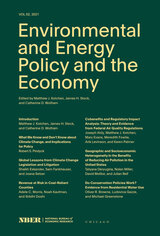 Environmental and Energy Policy and the Economy: Volume 2
Edited by Matthew J. Kotchen, James H. Stock, and Catherine D. Wolfram
University of Chicago Press Journals, 2020 This volume presents six new papers on environmental and energy economics and related policy issues. Robert Pindyck provides a systematic overview of what is known, and remains unknown, about climate change, along with the implications of uncertainty for climate policy. Shaikh Eskander, Sam Fankhauser, and Joana Setzer offer insights from a comprehensive data set on climate change legislation and litigation across all countries of the world over the past thirty years. Adele Morris, Noah Kaufman, and Siddhi Doshi shine a light on how expected trends in the coal industry will create significant challenges for the local public finance of coal-reliant communities. Joseph Aldy and his collaborators analyze the treatment of co-benefits in benefit-cost analyses of federal clean air regulations. Tatyana Deryugina and her co-authors report on the geographic and socioeconomic heterogeneity in the benefits of reducing particulate matter air pollution. Finally, Oliver Browne, Ludovica Gazze, and Michael Greenstone use detailed data on residential water consumption to evaluate the relative impacts of conservation policies based on prices, restrictions, and public persuasion.
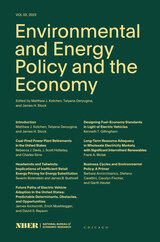 Environmental and Energy Policy and the Economy: Volume 3
Edited by Matthew J. Kotchen, Tatyana Deryugina, and James H. Stock
University of Chicago Press Journals, 2022 This volume presents six new papers on environmental and energy economics and policy in the United States. Rebecca Davis, J. Scott Holladay, and Charles Sims analyze recent trends in and forecasts of coal-fired power plant retirements with and without new climate policy. Severin Borenstein and James Bushnell examine the efficiency of pricing for electricity, natural gas, and gasoline. James Archsmith, Erich Muehlegger, and David Rapson provide a prospective analysis of future pathways for electric vehicle adoption. Kenneth Gillingham considers the consequences of such pathways for the design of fuel vehicle economy standards. Frank Wolak investigates the long-term resource adequacy in wholesale electricity markets with significant intermittent renewables. Finally, Barbara Annicchiarico, Stefano Carattini, Carolyn Fischer, and Garth Heutel review the state of research on the interactions between business cycles and environmental policy.
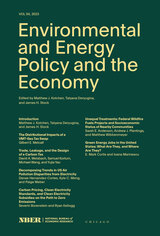 Environmental and Energy Policy and the Economy: Volume 4
Edited by Matthew J. Kotchen, Tatyana Deryugina, and James H. Stock
University of Chicago Press Journals, 2023 Rigorous, careful, and nonpartisan research with a high policy impact on environmental and energy economics.
Environmental and Energy Policy and the Economy focuses on the effective and efficient management of environmental and energy challenges. Research papers offer new evidence on the intended and unintended consequences, the market and nonmarket effects, and the incentive and distributional impacts of policy initiatives and market developments.
This volume presents six new papers on environmental and energy economics and policy. Gilbert Metcalf examines the distributional impacts of substituting a vehicle miles-traveled tax for the existing federal excise tax in the United States. David Weisbach, Samuel Kortum, Michael Wang, and Yujia Yao consider solutions to the leakage problem of climate policy with differential tax policies on the supply and demand for fossil fuels and on domestic production and consumption. Danae Hernandez-Cortes, Kyle Meng, and Paige Weber quantify and decompose recent trends in air pollution disparities in the US electricity sector. Severin Borenstein and Ryan Kellogg provide a comparative analysis of different incentive-based mechanisms to reduce emissions in the electricity sector on a path to zero emissions. Sarah Anderson, Andrew Plantinga, and Matthew Wibbenmeyer document distributional differences in the allocation of US wildfire prevention projects. Finally, Mark Curtis and Ioana Marinescu provide new evidence on the quality and quantity of emerging “green” jobs in the United States.
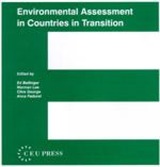 Environmental Assessment in Countries in Transintion
Norman Lee
Central European University Press, 2000 The countries included in this study on the regulations and practices relating environmental assessment are Armenia, Belarus, Bulgaria, Croatia, the Czech Republic, Estonia, Hungary, Kazakhstan, Latvia, Lithuania, Moldova, Montenegro, Poland, Romania, Russia, Slovenia, Ukraine. Each country study has been prepared by specialists from within the country concerned. This study will be of interest to EA practitioners in public administration; development and consultant organizations; training and educational and research institutes; and international and bilateral aid agencies. Project level EIA (Environmental Impact Assessment) and, to a lesser extent, SEA (Strategic Environmental Assessment) for planning and other strategic-level actions have been, or are being, introduced in the great majority of countries in transition (CIT). As yet, however, most of the countries have only limited experience in formulating "state of the art" EIA regulations and applying them satisfactorily. Furthermore, such experiences in CITs that do exist are not yet sufficiently well documented and widely disseminated. This report should be of considerable value in helping strengthen EA regulation and practice in the region.
 The Environmental Beat: Inside the Struggle to Legitimize the Environment as News
Suzannah Evans Comfort
University of Missouri Press, 2026 Environmental degradation has been part of American life for centuries, and yet environmental journalism as a specialized reporting beat has only existed since the 1960s. In the ensuing decades, the environment has fallen in and out of favor as a priority for news organizations. Moreover, journalists who pursue environmental stories have long been dogged by a reputation that they are activists, a charge that delegitimizes their labor and further undermines the potential for news organizations to commit to reporting on environmental issues.
In The Environmental Beat: Inside the Struggle to Legitimize the Environment as New, Suzannah Evans Comfort examines the circumstances under which news organizations chose to invest in environmental journalism since the early 20th century, demonstrating that a combination of external social factors and internal newsroom dynamics must occur for the environment to appear as a newsworthy topic. Comfort also examines actors on the margins of journalistic legitimacy, such as newspaper outdoor columnists who wrote on the sports pages, and environmental advocacy presses that provided a far more consistent source of environmental news making than their peers in the newsroom. These low-status actors in the journalistic field embraced advocacy and rejected both-siderism in their reporting on issues of the environment. Their consistency and longevity, even as more traditionally produced news attention waxed and waned, may provide an explanation for the perception of environmental news making as fundamentally activist.
The Environmental Beat will be of interest to working journalists as well as scholars of journalism.
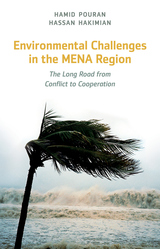 Environmental Challenges in the MENA Region: The Long Road from Conflict to Cooperation
Hamid Pouran and Hassan Hakimian
Gingko, 2019 The Middle East and North Africa region is well-known for its abundant natural resources and important geostrategic position. This position is often overshadowed by continued sectarian violence and trans-boundary conflicts that threaten the stability of the entire region with serious global implications. This preoccupation with conflict has come at the expense of addressing the region’s other challenges.
Although the region’s fragile environmental state has increasingly preoccupied policymakers in individual countries, there is currently insufficient attention paid to coordinating collaborative action to recognise and address problems relating to its environmental sustainability and climatic change. In the absence of a positive agenda for tackling these issues, recurrent environmental setbacks and rapid depletion of the region’s natural resources continue to pose a major threat to the long-term economic, political, and social stability of the region.
Despite the urgency of these challenges, there is little research dedicated to studying MENA’s environmental sustainability. Environmental Challenges in the MENA Region: The Long Road from Conflict to Cooperation draws from the proceedings of a seminal international conference on the subject at SOAS in October 2016, which was held as a celebration of the SOAS Centenary. This led to a collective contribution by experts and policy-makers concerned with the state of the MENA region’s environmental predicament with the aim of addressing these problems in a constructive and forward-looking approach.
The chapters in this book are predicated upon two critical premises. First, expertise and awareness from a wide range of disciplines is required to understand and address environmental challenges. And, second, to have a real chance of success, MENA countries need to confront these problems as their common threats and to see them as an opportunity for regional cooperation and policy coordination. This book provides the results of an interdisciplinary effort to address the various dimensions of the region’s environmental challenges from across the region and disciplines.
Environmental Change
Rosemary O'Leary
Temple University Press, 1995 Environmental Change examines the impact of hundreds of federal court decisions on the policies and administration of the EPA since its inception in 1970. Having surveyed over 2,000 federal court decisions, Rosemary O'Leary presents case studies of five important policy areas: water quality, pesticides, toxic substances, air quality, and hazardous wastes. Compliance with court orders, O'Leary discovered, has become one of the EPA's top priorities, at times overshadowing congressional mandates and the authority of EPA administrators. For an agency often caught between the White House and Congressional agendas, the competing interests of industry and environmental groups, and turf battles with other federal agencies, O'Leary argues, judicial decision making is crucial in the public policy process. Environmental Change offers valuable information in the fields of public policy and environmental law.
 Environmental Change and Human Adaptation in the Ancient American Southwest
Doyel and Dean
University of Utah Press, 2006 Archaeology provides an ideal avenue for examining long-term processes and interrelationships between human behavior and environmental stability, variation, and change. The American Southwest is particularly well suited for such 'deep-time' investigations because of its comprehensive archaeological record, rich ethnographic and historical data on its peoples, and unmatched reconstructions of multiple environmental variables across a broad range of spatial and temporal scales.
This volume contains a varied and instructive set of studies of human behavioral adaptation to environmental change in the ancient Southwest. It makes significant contributions to southwestern prehistory, settlement pattern studies, agriculture, behavioral ecology, paleo-environmental reconstruction, and statistical and computer-aided modeling. The mix of case studies and syntheses covers the Colorado Plateau, Sonoran Desert, Mogollon Highlands, and Rio Grande Valley and summarizes the work of some of the leading researchers in the region.
 Environmental Change in the Lake Tahoe Basin: A Synthesis of Science and Public Policy
Robert N. Coats
University of Nevada Press, 2025 The Lake Tahoe Basin is both a natural treasure and a complex case study in environmental management. Environmental Change in the Lake Tahoe Basin offers a comprehensive assessment of the region’s environmental history, current conditions, and future challenges, providing lessons in how science-based policies can drive effective stewardship in high-value, high-conflict landscapes. For over a century, scientific research and management efforts have aimed to mitigate the impacts of logging, mining, pollution, and invasive species while balancing urban development, tourism, and ecological preservation on the Lake. The book explores these challenges through a multidisciplinary lens, integrating environmental science, policy analysis, and case studies of both successful and failed management strategies. Written by experts who have played direct roles in key scientific discoveries and policy decisions, the book also examines the influence of environmental organizations and litigation in shaping conservation efforts. At its core, the authors argue that the Tahoe Basin serves as a model for science-driven land and water stewardship. The book evaluates long-term monitoring programs, offering actionable recommendations for improving environmental oversight and resource management. Combining scientific analysis with accessible language, Environmental Change in the Lake Tahoe Basin serves as an up-to-date review of the region’s environmental challenges, providing an essential guide for scientists, resource managers, and policymakers. The authors will donate all royalties from the sale of this volume to the Union of Concerned Scientist, www.ucs.org.
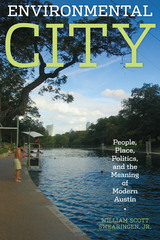 Environmental City: People, Place, Politics, and the Meaning of Modern Austin
By William Scott Swearingen, Jr.
University of Texas Press, 2010 As Austin grew from a college and government town of the 1950s into the sprawling city of 2010, two ideas of Austin as a place came into conflict. Many who promoted the ideology of growth believed Austin would be defined by economic output, money, and wealth. But many others thought Austin was instead defined by its quality of life. Because the natural environment contributed so much to Austin's quality of life, a social movement that wanted to preserve the city's environment became the leading edge of a larger movement that wanted to retain a unique sense of place. The "environmental movement" in Austin became the political and symbolic arm of the more general movement for place. This is a history of the environmental movement in Austin—how it began; what it did; and how it promoted ideas about the relationships between people, cities, and the environment. It is also about a deeper movement to retain a sense of place that is Austin, and how that deeper movement continues to shape the way Austin is built today. The city it helped to create is now on the forefront of national efforts to rethink how we build our cities, reduce global warming, and find ways that humans and the environment can coexist in a big city.
Environmental Disputes: Community Involvement In Conflict Resolution
James E. Crowfoot and Julia Wondolleck
Island Press, 1990 Environmental Disputes helps citizen groups, businesses, and governments understand how Environmental Dispute Settlement--a set of procedures for settling disputes over environmental policies without litigation--can work for them.
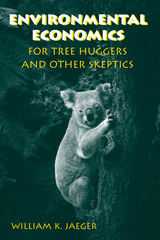 Environmental Economics for Tree Huggers and Other Skeptics
William K. Jaeger
Island Press, 2006 Though many students and environmentalists shudder at even the thought of economics, a working knowledge of the basics can be a powerful ally. Economic arguments carry a great deal of weight, and putting them to work for environmental causes can be a deciding factor, especially in policy debates. The reverse is true as well, and an understanding of the possibly flawed, misleading, or overstated economics behind an opponent's case can be crucially important. Environmental Economics for Tree Huggers and Other Skeptics carefully explains the tools of economic analysis and shows how they can be used to help reveal the root causes of and potential solutions for environmental and natural resource problems. Jaeger's proven techniques and wonderfully conversational tone assume no economics training, and his presentation of the material is designed to facilitate clarity. His step-by-step approach unearths surprisingly simple, easy-to-remember principles and shows how to apply them to real-world environmental problems. Those with exposure to introductory microeconomics will find Environmental Economics for Tree Huggers and Other Skeptics to be a welcome refresher. Undergraduate and graduate students of environmental studies, resource management, law, policy, and related fields, as well as novices who are skeptical of how the field could possibly help them in their own efforts, will be pleasantly surprised.
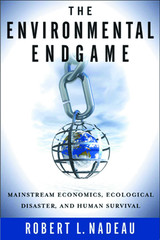 The Environmental Endgame: Mainstream Economics, Ecological Disaster, and Human Survival
Nadeau, Robert L
Rutgers University Press, 2006 For decades, scholars have warned of an impending global environmental crisis. Yet politicians, particularly in the United States, have consistently shown that they are not taking the threat seriously. Initiatives aimed at protecting the planet are commonly seen as belonging to a category unto themselves-the preserve of scientists and environmental enthusiasts.
In this groundbreaking book, Robert L. Nadeau warns that we have moved menacingly close to a global environmental catastrophe and that to evade this fate we must stop drawing a distinction between issues that are "environmental" or "scientific" and those that reside in the sphere of "real life." Although scientists have attempted to bring ecological concerns to the forefront of global issues, problems are rarely communicated in ways that can be readily understood by those outside the scientific community.
Bringing together perspectives from a variety of disciplines, including economics, politics, biology, and the history of science, The Environmental Endgame articulates the concerns of scientists in a way that they become the real-life, tangible concerns of people around the world. Nadeau asserts that we have entered a new phase of human history that cannot be one of separation and division but must be one of cooperation and mutual goals.
Nadeau demonstrates that our current governmental and financial institutions, based on neoclassical economics, lack the mechanisms for implementing viable solutions to large-scale crises. Such steps cannot be taken without moving beyond the power politics of the nation-state system. The book concludes with a call to view the natural world as part of humanity, not separate from it. This unifying worldview would be a catalyst for implementing the international government organizations necessary to resolving the crisis.
The Environmental Endgame is an ambitious and timely book that will change the way we think about our economy, our government, and the environment. It should be read by everyone who cares about the pervasive neglect and abuse of planet Earth and wants to know what can be done about it.
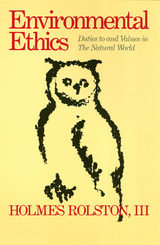 Environmental Ethics
Holmes Rolston
Temple University Press, 1989 Environmental Ethics is a systematic account of values carried by the natural world, coupled with an inquiry into duties toward animals, plants, species, and ecosystems. A comprehensive philosophy of nature is illustrated by and integrated with numerous actual examples of ethical decisions made in encounters with fauna and flora, endangered species, and threatened ecosystems. The ethics developed is informed throughout by ecological science and evolutionary biology, with attention to the logic of moving from what is in nature to what ought to be. The ethical theory is applied in detail to social, public, and business policy. Written in an engaging style, using diagrams and figures as well as numerous case studies, Environmental Ethics prods the reader into concrete application and invites reader participation in the ethical discussions. The ethics concludes by exploring the historical experiences of personal residence in a surrounding environment. Here is an adventure into what it means to live as responsible human beings in the community of life on Earth.
In the series Ethics and Action, edited by Tom Regan.
 Environmental Ethics and Forestry
Peter List
Temple University Press, 2000 During the past twenty-five years, North American forestry has received increasingly vigorous scrutiny. Critics including the environmentalists, environmental scientists, representatives of public interest groups, and many individual citizens have expressed concerns about forestry's basic assumptions and methods, as well as its practical outcomes. Criticism has centered on such issues as the exploitation of forests for timber production, the reduction and fragmentation of old-growth habitats, the destruction of biodiversity, the degradation of grasslands through grazing practices, lack of government attention to recreation facilities, silvicultural methods like clearcutting and the use of herbicides and pesticides, the exportation of industrial forestry techniques to other parts of the world, and the use of public monies to provide services for private resource companies, as in the creation of logging roads.
This rising tide of public scrutiny has led many foresters to suspect that their "contract" with society to manage forests using their best professional judgment has been undermined. Some of these professionals, as well as some of their critics, have begun to reexamine their old beliefs and to look for new ways of practicing forestry. Part of this reflective process has entailed new directions in environmental ethics and environmental philosophy.
This reader brings together some of the new thinking in this area. Here students of the applied environmental and natural resource sciences, as well as the interested general reader, will discover a rich sampling of writings in environmental ethics and philosophy as they apply to forestry. Readings focus on basic ethical systems in forestry and forest management, philosophical issues in forestry ethics, codes of ethics in forestry and related natural resource sciences such as fisheries science and wildlife biology, Aldo Leopold's land ethic in forestry, ethical advocacy and whistleblowing in government resource agencies, the ethics of new forestry, ecoforestry, and public debate in forestry, as well as ethical issues in global forestry such as the responsibilities of forest corporations, environmentalists, and individual wood consumers.
The volume contains materials from the founders of forestry ethics, such as Bernhard Fernow, Giford Pinchot, John Muir, and Aldo Leopold; from such organizations as the Society of American Foresters, the Wildlife Society, the American Fisheries Society, Forest Service Employees for Environmental Ethics, and the Ecoforesters group, in addition to the writings by a variety of well-known environmental philosophers and foresters, including Holmes Rolston, Robin Attfield, Lawrence Johnson, Michael McDonald, Paul Wood, James E. Coufal, Raymond Craig, Kristin Shrader-Frechette, Jeff DeBonis, Jim L. Bowyer, Alasdair Gunn, Doug Daigle, Alan G. McQuillan, Stephanie Kaza, Alan Drengson, Duncan Taylor, and Kathleen Dean Moore.
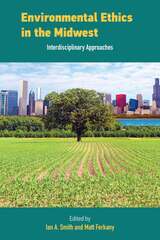 Environmental Ethics in the Midwest: Interdisciplinary Approaches
Ian Smith
Michigan State University Press, 2022 The American Midwest is environmentally rich and complex, home to some of the world’s largest freshwater lakes and streams as well as cities, prairies, forests, and farmlands. Nevertheless, the unique environmental opportunities and challenges the region presents have been left underappreciated and underexplored by environmental ethicists. The close integration of the natural and built environments of the Midwest prompts interdisciplinary inquiry in a particularly pointed way. To remedy the lack of scholarly attention to this area, this volume attends to the way that the broad concerns of environmental ethics manifest in the region. These eight original essays cover a wide range of topics, including agrarian ethics and Stoicism; the Dakota access pipeline and Indigenous women’s activism; philosophy of law and species classification; environmental justice and the Flint water crisis; hog farming and antimicrobial drug resistance; science education standards and climate change education; virtue ethics and ecological restoration; environmental pragmatism and the Clean Water Act; and more. Each accessibly written chapter brings multidisciplinary complexity to bear on this complex region. The authors include philosophers working in environmental ethics and other subfields of philosophy, and together with scholars in fields such as environmental sociology, American Indian studies, and environmental studies, they provide a fresh and necessary perspective on the American Midwest.
 Environmental Futures: An International Literary Anthology
Edited by Caren Irr, et al.
Brandeis University Press, 2024 A global anthology, curated by experts from around the world, draws on fiction and poetry to examine environmental challenges and their implications for communities.
Featuring short stories, poetry, drama, and creative nonfiction from around the world, this anthology showcases contemporary literature to envision the future of the environment. While environmental literature written in English has been dominated by English and American men who make solo explorations into an unspoiled natural world, Environmental Futures emphasizes local and indigenous writers contending with global landscapes that are far from pristine. Their work opens up decolonial perspectives from Anglophone Africa, South Asia, India, China, South America, the peripheries of Europe, and BIPoC North America. Introducing many writers who will be unfamiliar to English-speaking readers, this collection explores resistance to the oil economy, the impact of storms and natural disasters, extinction, and relations between humans and animals, among other themes.
The pieces are organized by geographical area in five sections: Africa, Asia, Europe, Latin America, and North America. Expert scholars and translators—Kurt Cavender, Roberto Forns-Broggi, Cajetan Iheka, Upamanyu (Pablo) Mukherjee, Irina Sadovina, and Shaobo Xie—selected the works and provided critical introductions for each section.
 Environmental Governance: The Global Challenge
Lamont C. Hempel
Island Press, 1996 In Environmental Governance, Lamont C. Hempel considers the nature of global environmental change and the institutional responses needed to manage it. While environmental problems are increasingly transboundary in scope and significance, governance remains sharply fragmented and territorial. For political institutions to cope successfully with growing biospheric crises, they must become "glocal" in design and operation -- some of the environmental authority presently invested in sovereign states must be redistributed to both supranational entities and local communities.Using political theory, applied policy analysis, and case studies, Hempel explains how major and sustainable improvements in the quality of life will require significant but achievable innovations. Changes such as "green" technologies, human population stabilization, full social cost pricing, the elimination of absolute poverty, and the widespread adoption of ecologically based values and ecologically compatible lifestyles will all be necessary in the coming decades. But without a redesign and strengthening of local, regional, and transnational political institutions and policies, such developments are not likely to flourish.While thoroughly grounded in political science, Environmental Governance is multidisciplinary in design, drawing on concepts and tools from ecology, economics, law, business, sociology, philosophy, public health, and international relations theory.
 Environmental Groups and Legal Expertise: Shaping the Brexit process
Carolyn Abbot and Maria Lee
University College London, 2021 A close look at environmental NGO advocacy during Brexit and how legal expertise can be a resource in moments of crisis.
This book explores the use and understanding of law and legal expertise by environmental groups. Rather than focusing on the courtroom, however, this volume scrutinizes environmental NGO advocacy during the extraordinarily dramatic Brexit process, from the referendum on leaving the EU in 2016 to the debate around the new Environment Bill in 2020. In an effort to show how legal expertise is more than a campaign tool or the threat of litigation, this book describes the ways in which law can provide distinctive ways of both seeing and changing the world. Legal resources in the environmental sector are not just a practical limit on what can be done, but an opportunity to investigate the very understanding of what should be done. Legal expertise was heavily and often effectively used in the anomalously law-heavy Brexit-environment debate. This book will clarify this moment and the NGO collaboration that made it possible for environmental advocates to call upon legal expertise in a moment of crisis.
 Environmental Health: Fourth Edition
Dade W. Moeller
Harvard University Press, 2011 Dramatic changes in the field of environmental health since the Third Edition was published in 2004 demand a new, radically updated version of this essential textbook.
Based on the recommendations of advisory bodies and federal agency regulations, as well as a thorough review of the scientific literature, Moeller’s Fourth Edition is the only fully current text in this burgeoning field. It features new tables and figures, and revisions of those retained from previous editions. Environmental Health is also enriched with the knowledge and insights of professionals who are deeply involved in “real world” aspects of each subject covered.
In eighteen chapters, students receive a complete but manageable introduction to the complex nature of the environment, how humans interact with it, and the mutual impact between people and the environments where they work or live. This new edition emphasizes the challenges students will face in the field: the local and global implications of environmental health initiatives, their short- and long-range effects, their importance to both developing and developed nations, and the roles individuals can play in helping to resolve these problems.
Whether discussing toxicology, injury prevention, risk assessment, and ionizing and non-ionizing radiation, or more traditional subjects like the management and control of air, water, and food, Dade Moeller emphasizes the need for a systems approach to analyzing new projects prior to their construction and operation.
Environmental Health is indispensable reading for practitioners, students, and anyone considering a career in public health.
 Environmental Health: Revised Edition
Dade W. Moeller
Harvard University Press, 1997 When the first edition of Environmental Health appeared in 1992 it was quickly recognized as the single best resource for students, public health professionals, and general readers concerned with the well-being of the environment and its inhabitants. Now, four completely new chapters and an additional two hundred pages of text bring this definitive work up to date.
This new edition maintains the earlier edition's balanced coverage of a broad spectrum of timely topics, including air, water, and food; occupational health; insect and rodent control; the effects, uses, and management of ionizing and nonionizing radiation; accidents as a cause of injuries and deaths; natural and man-made disasters; the impact of energy usage; and environmental standards and monitoring. The new edition also offers completely new chapters on four crucial subjects: environmental toxicology, environmental epidemiology, environmental law, and risk assessment. In addition, drinking water and liquid wastes, formerly discussed in combination, are now covered in separate chapters.
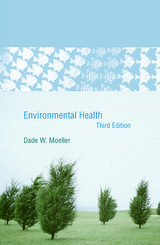 Environmental Health: Third Edition
Dade W. Moeller
Harvard University Press, 2005 Environmental Health has established itself as the most succinct and comprehensive textbook on the subject. This extensively revised and rewritten third edition continues this tradition by incorporating new developments and by adding timely coverage of topics such as environmental economics and terrorism.
As in previous volumes, the new edition presents balanced assessments of environmental problems, examining their local and global implications, their short- and long-range impacts, and their importance in both developed and less developed countries of the world. The Third Edition also addresses emerging issues such as environmental justice, deforestation, the protection of endangered species, multiple chemical sensitivity, and the application of the threshold concept in evaluating the effects of toxic and radioactive materials.
Whether discussing acid rain, ozone depletion, global warming, or more traditional subjects such as the management and control of air, water, and food, Dade Moeller emphasizes the need for a systems approach. As with previous volumes, Environmental Health, Third Edition, offers a depth of understanding that is without peer. While it covers technical details, it is also a book that anyone with an interest in the environment can pick up and browse at random.
An Environmental History of Knowledge and Politics: Forestry in Nineteenth- and Twentieth-Century Hungary
Robert Balogh
Central European University Press, 2026 In February 2024 the designated body of the geological sciences rejected the proposition that humans have entered the Anthropocene epoch. Historians are yet to tell history as the interaction with materials and living beings. The history of forestry is a particularly promising subject to study. Environmental concerns and the large-scale commodification of forests, often with state participation, have been walking hand-in-hand since at least the mid-eighteenth century. Moreover, the history of the development of forestry’s standardised methodology is a global history. This book describes the efforts and experiences of trained foresters driven by competing priorities, as well as their impact on the society, landscape and politics of Hungary between about 1860 and 1975.
Environmental History, volume 27 number 1 (January 2022)
The University of Chicago Press
University of Chicago Press Journals, 2022 This is volume 27 issue 1 of Environmental History. Environmental History (EH) is the world’s leading scholarly journal in environmental history and the journal of record in the field. Scholarship published in EH explores the changing relationships between humans and the environment over time. This interdisciplinary journal brings together insights from geography, anthropology, the natural sciences, and many other disciplines to inform historical scholarship.
Environmental History, volume 27 number 2 (April 2022)
The University of Chicago Press
University of Chicago Press Journals, 2022 This is volume 27 issue 2 of Environmental History. Environmental History (EH) is the world’s leading scholarly journal in environmental history and the journal of record in the field. Scholarship published in EH explores the changing relationships between humans and the environment over time. This interdisciplinary journal brings together insights from geography, anthropology, the natural sciences, and many other disciplines to inform historical scholarship.
Environmental History, volume 27 number 3 (July 2022)
The University of Chicago Press
University of Chicago Press Journals, 2022 This is volume 27 issue 3 of Environmental History. Environmental History (EH) is the world’s leading scholarly journal in environmental history and the journal of record in the field. Scholarship published in EH explores the changing relationships between humans and the environment over time. This interdisciplinary journal brings together insights from geography, anthropology, the natural sciences, and many other disciplines to inform historical scholarship.
Environmental History, volume 27 number 4 (October 2022)
The University of Chicago Press
University of Chicago Press Journals, 2022 This is volume 27 issue 4 of Environmental History. Environmental History (EH) is the world’s leading scholarly journal in environmental history and the journal of record in the field. Scholarship published in EH explores the changing relationships between humans and the environment over time. This interdisciplinary journal brings together insights from geography, anthropology, the natural sciences, and many other disciplines to inform historical scholarship.
Environmental History, volume 28 number 1 (January 2023)
The University of Chicago Press
University of Chicago Press Journals, 2023 This is volume 28 issue 1 of Environmental History. Environmental History (EH) is the world’s leading scholarly journal in environmental history and the journal of record in the field. Scholarship published in EH explores the changing relationships between humans and the environment over time. This interdisciplinary journal brings together insights from geography, anthropology, the natural sciences, and many other disciplines to inform historical scholarship.
|
|

